
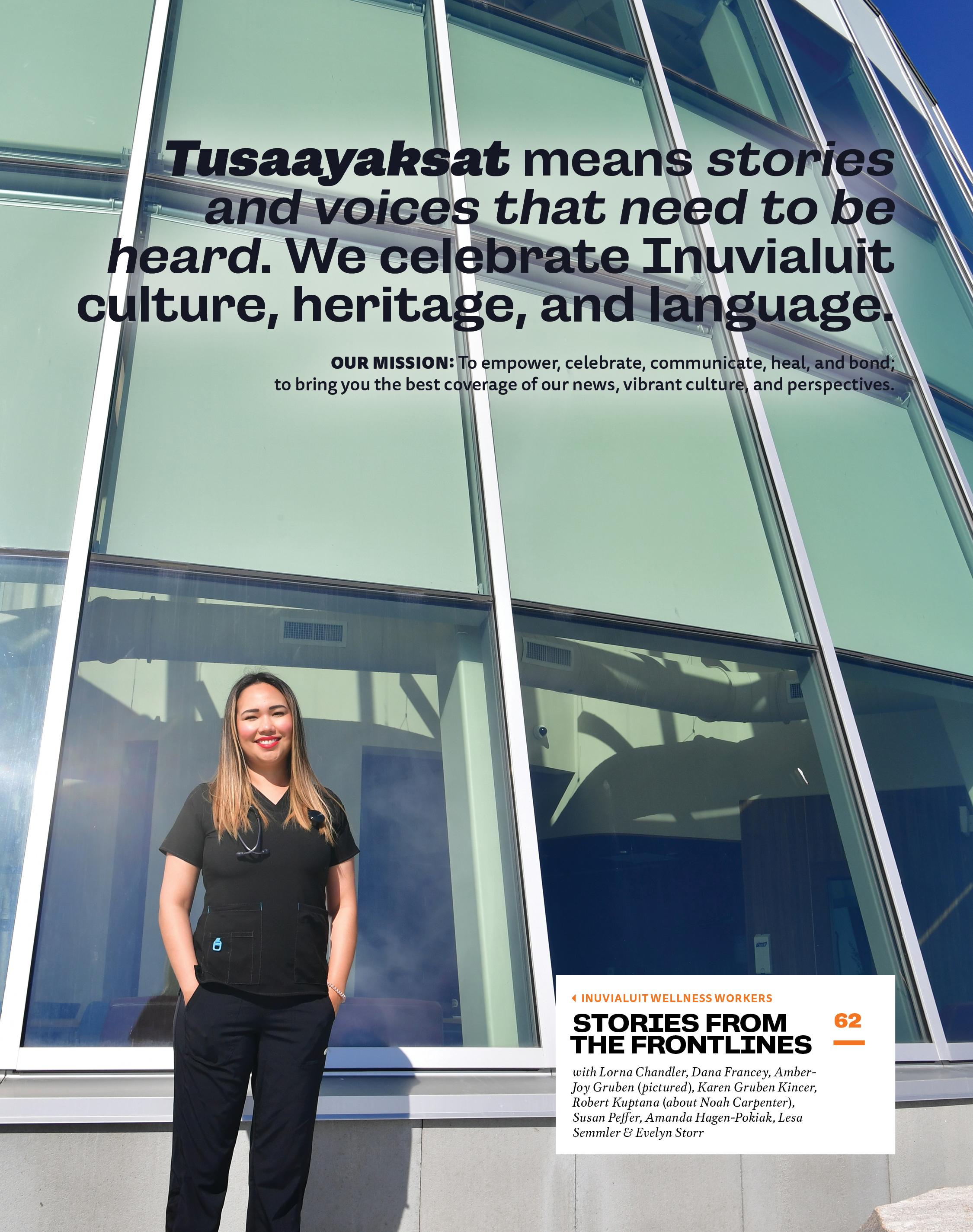
Who was Canada's very frst Inuk Registered Nurse? Follow James as he recollects the many pieces of his mother's story.



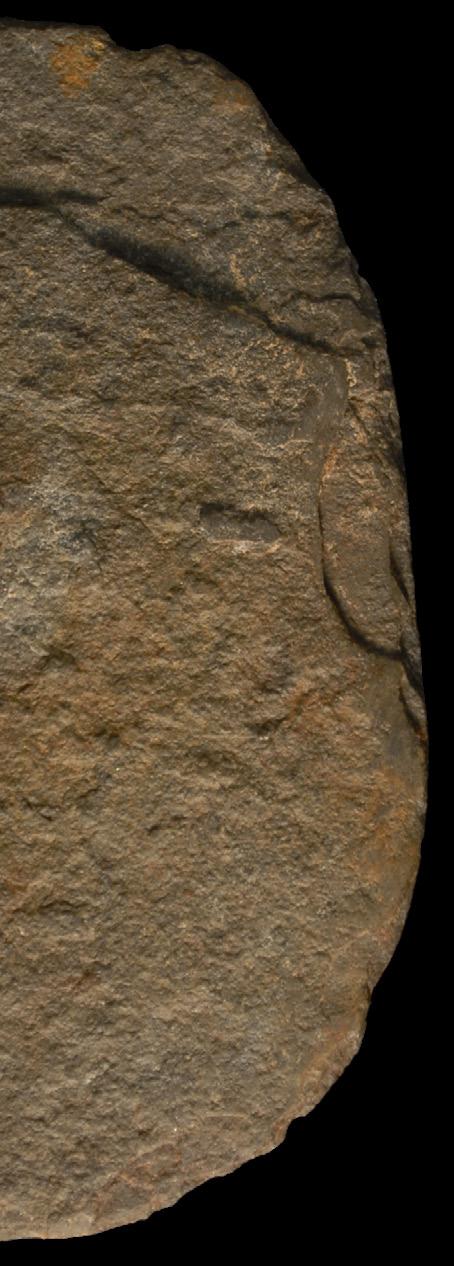
4 MAKPIRAAM ILUANI TABLE OF CONTENTS INTRODUCTION HEALTH & WELLNESS Jasmine Ruben (Guest Editor) AANNURAAQ CLOTHING FASHION DURING A PANDEMIC Erica Lugt FEATURE STORY WESTERN ARCTIC YOUTH COLLECTIVE Alyssa Carpenter & Nigit'stil Norbert POETRY TO WHO YOU ARE Mary-Anne Francey 100 106 50 RECALLING MABEL James Lumsden
FACEBOOK DISCUSSION SOBRIETY STORIES Including Starla Short, Brian Kowikchuk & Tanis Blake 21 TAIMA CLOSING BLESSING FOR OUR COVID-19 WORKERS Robert Kuptana CONVERSATIONS PANDEMIC PERSPECTIVES Alexandra & Kailin Aleekuk 30 HISTORICAL HEALTH & WELLBEING ON BANKS ISLAND Natasha Lyons & Lisa Hodgetts HAVAARIKTUQ CREATIVE HOW TO GET GOOD Dennis Allen 93 85 OPINION MEN IN MEN TAL HEALTH Noel Leigh-Cockney 96 44 102 BACK COVER STORY INUVIALUIT FORTITUDE Christina King (Taalrumiq) 109 HAVAARIKTUQ CREATIVE MASKING UP FOR CHARITY Kristian Binder 104
AUYAQ SUMMER 2020 INUUHIRIKTUQ HEALTH
ON THE COVER
Registered Nurses (RNs) Amber-Joy Gruben and Jasmine Ruben pose in front of the Yellowknife Stanton Territorial Hospital.
(Photo by Myrna Pokiak)
Publisher Inuvialuit Communications Society
Editor Jason Lau
Guest Editor Jasmine Ruben
Art Director Kyle Natkusiak Aleekuk
ICS Manager Tamara Voudrach
Ofce Administrator Roseanne Rogers
EDITORIAL
Storytellers Alexandra Aleekuk, Kailin
Aleekuk, Dennis Allen, Joey Amos, Elizabeth Arey, Clara Bates, Kristian Binder, Tanis Blake, Alainna Carpenter, Alyssa Carpenter/WAYC, Lorna Chandler, Janeen Chelsey, Noel-Leigh Cockney, Scott Dillon, Dwayne Drescher, Janet Elias, Aggi Ettagiak, Dana Francey, Mary-Anne Francey, Joanne Green, Jasmine Gruben, Amber-Joy Gruben, Edna Gruben, Amanda Hagen-Pokiak, Cynthia Hammond, Lisa Hodgetts/ILH, Herman R. Kaglik, Evangeline Kapotaon, Karen Kincer, Christina King (Taalrumiq), Crystal Kongayona, Brian Kowikchuk, Robert Kuptana, Karla Kuptana, Erica Lugt, James Lumsden, Natasha Lyons/ ILH, Nigit'stil Norbert/WAYC, Susan Pefer, Tyrone Raddi, Jasmine Ruben, Lesa Semmler, Starla Short, Evelyn Storr, Alice J. Thrasher, James Williams. Artists Kyle Natkusiak
Aleekuk, Alexandra Aleekuk, Kailin Aleekuk, Elizabeth Arey, Kristian Binder, Tanis Blake, Stewart Burnett, Asad Chisti, Debbie Dillon, Kynwill Gordon-Ruben, Christina King, Teri-Lynn Mcleod, Weronika Murray, Myrna Pokiak, Ben Powless, Sallie & Alyssa Ross, Shayla Snowshoe.
SPECIAL THANKS TO
Deanna Marie Jacobson, Umoja Toronto
BOARD OF DIRECTORS
President, Inuvik Lucy Kuptana
Vice President, Tuktoyaktuk Debbie Raddi
Treasurer, Ulukhaktok Joseph Haluksit
Aklavik Director Frederick Arey
Paulatuk Director Denise Wolki
Sachs Harbour Director Jean Harry
BUSINESS OFFICE
Inuvialuit Communications Society
292 Mackenzie Rd. / P.O. Box 1704
Inuvik, NT X0E 0T0
SUBSCRIPTIONS
Contact icsfnance@northwestel.net or phone
+1 (867) 777-2320 to subscribe or renew. As of this issue, our prices are: $20 CAD (1 year) and $36 CAD (2 years).
TUSAAYAKSAT IS FUNDED BY:
Inuvialuit Regional Corporation
GNWT (Education, Culture and Employment)
Letters From ICS

} UBLAAMI! We are now six months post-COVID-19 restrictions! It has been a surreal time for us all. I would like to take this opportunity to say that I am overwhelmed by our people’s ability to adapt through hardship. Te strength of Inuvialuit is undebatable.
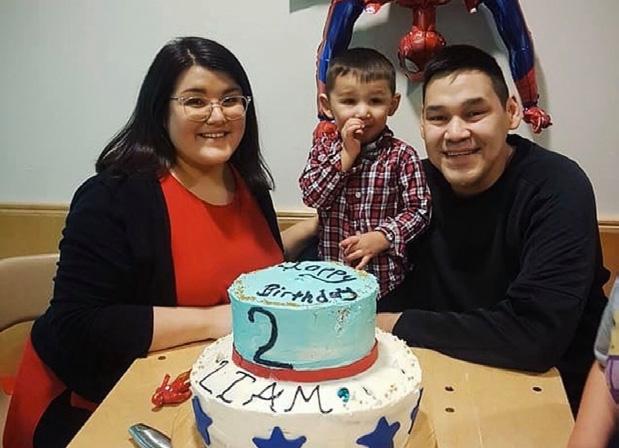
In this issue, we traverse what Inuvialuit say is important to them in the discussion of health and wellness: our Inuvialuit front-line workers, physical activity, mental health, social issues, and the arts have all come through with purpose from this issue’s contributors.
We highlight and honour our Inuvialuit front-line workers and healthcare professionals that are keeping us safe through the SARSCoV-2 pandemic. Amber-Joy Gruben shares the emotional impact of Indigenous nurses treating Indigenous patients, the day-to-day demands of a career in nursing and how important it can be to get active outdoors during the pandemic. Te importance of physical activity has been highlighted by many in the last few months. James Williams shares his lifelong relationship with sports, Northern Games, and personal philosophies on achieving one's goals.
Artists throughout our region and beyond have been busy creating new works to inspire. Catch Erica Lugt’s newest finds in “Fashion During A
Pandemic” and our back-cover story from Christina King takes a look back on the early-1900’s flu epidemic that devastated the Inuvialuit population. Inuvialuit were and still are We will always overcome.
We hope that this issue brings you much-needed inspiration and feelings of connection during this unprecedented time in our history. We may not be able to travel to be with loved ones, or spend as much time with our innait (Elders), but sharing tusaayaksat (stories that need to be heard) will allow us to bridge those gaps and remind us why we hold fast in our social distancing—to protect each other out of love.
My ui (husband), irniq (son), and I pray for your health, happiness, and well-being.
TAMARA VOUDRACH MANAGER, INUVIALUIT COMMUNICATIONS SOCIETY
} WHAT AN APPROPRIATE MOMENT in time to publish a Health & Wellness edition of Tusaayaksat! Te coronavirus pandemic, and subsequently the NWT Public Health order to isolate and social distance, has curtailed the Northern Games 50th anniversary event until the Summer of 2021. So, we have decided to focus this issue on Health and Wellness.
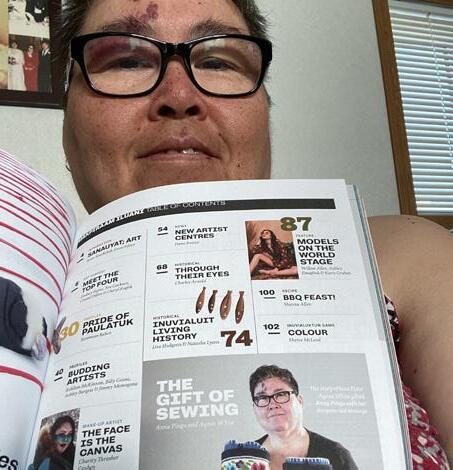


It has been an anxious time so far into this global pandemic. I think I took many things for granted for so long, but when it comes down to it—your family, health, and basic necessities are what’s so important. Everything else seems miniscule when you think of it.
My employer, along with others across the country, ordered their staf to work from home to minimize interactions and reduce any spread. You could have heard a pin drop in our Corporate ofces for a while.
Only the essential employees like the grocery clerks and pharmacists, truck drivers, suppliers, airlines, and health and enforcement services, kept operating to keep this country afloat. It’s just so incredible to see the sacrifice of so many to keep the public safe and supplied. We need to applaud their eforts and recognize them!

We are now on month 5 of the pandemic, with the country slowly re-opening and schools planning to re-open in the Fall—but it is a changed world. We will have to live with many limitations to our

lifestyle, but I think it is worth it. Te protection of you, your family, and your community is important. We will all need to make sacrifices, but I’m happy to see hospitals working with improved COVID-19 treatment methods, and researchers working on a vaccine that may be announced within the next year—but there are no guarantees. I think at last count, there were at least 160 teams globally working on a vaccine!
In this edition, you will be introduced to some of Inuvialuit Regional Corporation (IRC) Health and Wellness team—my colleagues at the Inuvialuit Regional Corporation who work very hard to ofer valuable programming in the communities and represent Inuvialuit at health and wellness forums across the country. Te work that the Health and Wellness team does is a model for many.
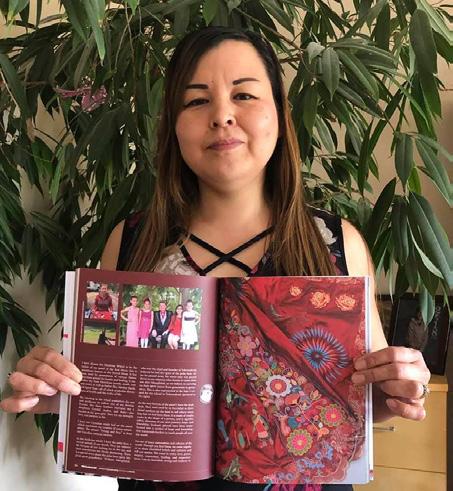
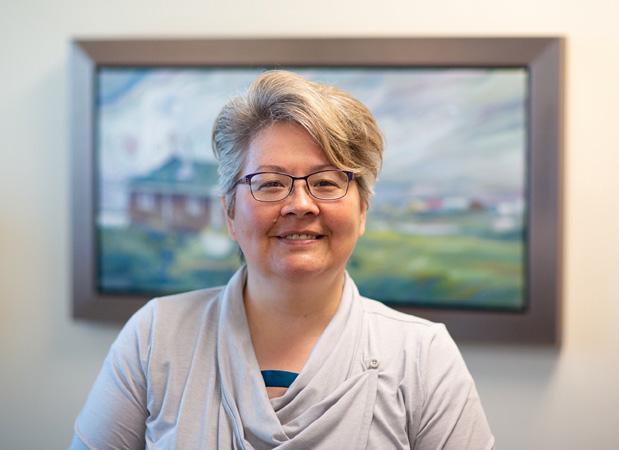
Troughout all of this (and this will continue), our mental health has been afected. Tese are anxious times—and many of us are anxious enough already! I have seen many people turn back to the land as their solace and it’s pretty wonderful to see families spending so much time out there enjoying the beautiful and bountiful land. Canada is an amazing sight, but the Inuvialuit Settlement Region is spectacular!
Te last message I would like to extend is to ofer a suggestion: let us all try to practice a bit of patience; many are working hard to keep us all safe. Take care of yourself and each other. Keep well and keep safe. Keep the faith that there will be a time when everyone will gather and celebrate again! Anaqanaallu!
INUUHIRIKTUQ HEALTH & WELLNESS 3 ` INUINNAQTUN–KANGIRYUARMIUTUN / ENGLISH
LUCY KUPTANA PRESIDENT, INUVIALUIT COMMUNICATIONS SOCIETY
SHOWING OFF YOUR UPINRAKSAQ
SPRING
2020
Geri-Lyn Guthrie @yegeskimo
Tanya Berry @nvinuvialuit
Shirley Steenberg
Chris Blechert @inuvialuit_chris
Anna Pingo @annapingo
HEALTH&

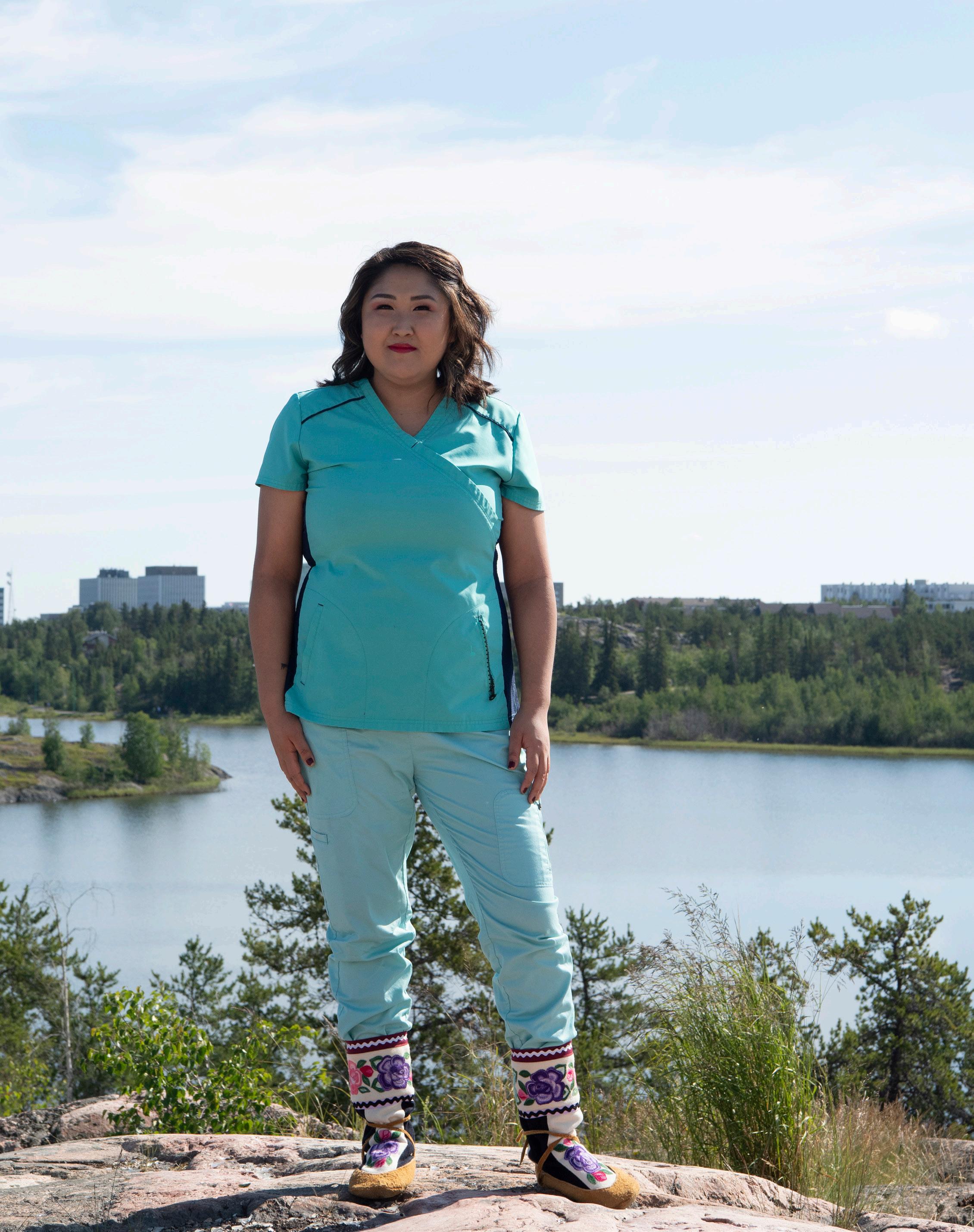 PHOTO BY MYRNA POKIAK
PHOTO BY MYRNA POKIAK
UBLAAMI!
EVER SINCE I WAS EIGHT YEARS OLD, I WANTED TO BE A DOCTOR. I am now 29 years old. I recently (in 2019) completed the Bachelor of Science in the Nursing program in Yellowknife, NT, and now I am a Registered Nurse.
I have two young daughters, Everlee (4 years old) and Victoria (2 years old) who were born while I was completing the nursing program. I know—what was I thinking right? To be honest, though, I could not have done it without them. Tey both were my motivation to pursue my nursing degree because I want to be a better mother for them. I am grateful for all my family and friends who supported me throughout that journey, especially my husband Dustin. If you’re wondering if you should go for that certificate, course, or program—you can do it! I believe in you! With dedication and motivation, anything is possible.
I am truly grateful and honoured to be the Guest Editor for the Health and Wellness edition of Tusaayaksat Magazine. In my perspective, health and wellness comes in many diferent aspects. For example, physical health (exercise, diet, etc.), mental health, traditional health (learned from our Elders and the land), spiritual health, and social health. However, I know health and wellness are diferent for each individual. So, if it means berry picking in the delta, drum dancing, spending time with loved ones, or receiving professional counselling, I wish you all nothing but health and wellness—especially during these uncertain times.
Jasmine Ruben Guest Editor
INUINNAQTUN: HEALTHY, HAS A GOOD LIFE — SALLIRMIUTUN & UUMMARMIUTUN: IS IN GOOD HEALTH
INUUHIRIKTUQ—SURRAITUQ—HURRAITCHUQ
I'M JASMINE. MY TAATAK ELIJAH ALLEN NAMED ME PANIUYAQ AFTER MY NAANAK, MABEL ALLEN (NEE CHICKSI). I WAS BORN IN INUVIK, NT.
James Thomas Ronald 'Iyahuk' Williams
YOUNG ATHLETE WORKING IN WILDLIFE AND ENVIRONMENTAL CONSERVATION
I was born in Fort Simpson on December 24, 1991. Ten I lived in Yellowknife when I was really young until 2001, before moving to Inuvik. Inuvik is where I consider my hometown and where I grew up.
My childhood consisted of a lot of time being involved in sports. I would always be involved in school sports in elementary school at Sir Alexander Mackenzie School. Tere, Mr. Brewster hosted various intramural tournaments for sports. In high school at Samuel Hearne Secondary School, I was always involved with traveling sports such as: volleyball, basketball and soccer. Outside of school, I did cross-country skiing, speed skating, arctic sports, and hockey.
I come from a hockey family. My dad (Tom Williams), my sister (Aurora), and I played hockey—even my mom (Pamela) played for a bit. Every day of the week, if we were not at the rink, then I was somewhere else doing some sports. Both my parents worked very hard to give my sister and me the opportunity to excel at sports, which I thank them so much for. In my later years, I was able to play Junior A hockey in the Maritimes (for four seasons) and later on, I gained a scholarship to Concordia University College of Edmonton. Tis was a general hockey scholarship towards tuition and to play on the Concordia Tunder Hockey Team.
If we weren't anywhere else, we would be at my good friend (still to this day) Paden Lennie's
house, either playing an intense road hockey game, or other games like baseball, hide-andseek, kick the can, and so on.
Outside of sports and with friends, I loved being out in the bush. My parents always had a cabin in whatever town we lived in. At a young age, I was fortunate enough to be introduced to an Inuvialuit tradition of whaling at Kendall Island. Hank and Sarah Rogers, whom I consider my 'adoptive Naanak and Taatak', would take me out for weeks at a time every summer to help with the harvest. I was able to get my first whale on July 17, 2007 (at 15 years old).
Currently I am 28 years old; I am married to my wonderful wife Linna Williams. We have a handsome and goofy toddler named Jimmy (James) Anguniakti Williams. We are currently living in Yellowknife, where I work as a Renewable Resource Ofcer for the Department of Environment and Natural Resources in the GNWT. My job allows me to keep in touch with the land, and conserve land and wildlife by providing enforcement with pertinent legislation. I am proud to be working at my job; I am a fourth-generation ofcer in wildlife and environment conservation. My great-grandfather Ignace Mercredi (Wood Bufalo National Park Game Warden), my grandfather Ron Williams (RWED/ENR Game Warden), and my uncle David Williams (RWED/ENR Game Warden), all on my dad’s side, were all ofcers before me.
AUYAQ SUMMER 2020 6
James graced our cover back 12 years ago, in our Winter 2008 issue (Volume 22, No. 5) with a story about his passion for hockey. Previous Editor Maia Lepage writes: "James Williams was born to play hockey… He may not be the biggest man on the team, but is guaranteed that you will notice him. His fast skating abilities and excellent puck-handling skills make him a force to be reckoned with. Match those skills with his 200lbs of pure muscle, and that equals one ferce competitor."
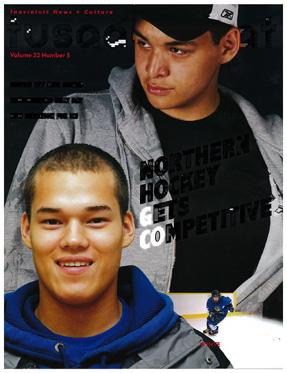




I come from a hockey family… Every day of the week, if we were not at the rink, then I was somewhere else doing some sports.
} TUSAAYAKSAT THROWBACK!
INUUHIRIKTUQ HEALTH & WELLNESS 7 INGUTAAQTUQ / IS MOVING
HOW CAN YOUTH GET INVOLVED IN THE GAMES?

"Other than attending the demonstrations at the schools through Aboriginal Sports Circle, there are some people that have found ways to practice in communities," James says. "Here in Yellowknife, a fellow competitor Veronica MacDonald started an Arctic Sports Club, which consists of one practice a week for groups between the ages of 8-17 and 18+. In other communities, I'm sure they have a similar practice set up."



AUYAQ SUMMER 2020 8
For the past many years, I have been working with the Aboriginal Sports Circle NWT, traveling to communities all over the NWT to demonstrate, promote, and talk about the history of the Northern Games. I always tell [others] what my coaches told me: "It is important to keep passing on the Northern Games." I used this on March 7th, 2015, when I was invited to conduct a speech for a TEDxAklavik, which was an independently organized TED event by Shane Douglas. Tere, I also said: "Tere is no such word as can't—this word should not be in your vocabulary. Not only in the Northern Games, but also in life. You will get more out of life if you at least try."
ABOUT NORTHERN GAMES
I was introduced to the Northern Games at a really young age by my Uncle Donald Kuptana Jr. When my family was living in Yellowknife in the 90s, we would visit Inuvik in the summers. We would visit with my Uncle Junior and Aunty Lucy, along with my cousins Scott and Kyle; my uncle would show us the Northern Games and get us to practice in their living room. My first introduction to competition was in 2003 at the old Aurora College Gym in Inuvik.
As to who taught me the Games: I would have to say Donald Kuptana Jr. introduced me and has always coached me. Elders such as Edward Lennie, Abel Tingmiak, Roy Ipana Sr., Gerry Kisoun, to name a few, have always been coaches to me also. In the Games, I am also a firm believer that everyone coaches each other in a way as competitors. In competitions, we are pushing each other to do the best we can!
I enjoy every single one of the Northern Games. Any one of the high kicks are very popular; they have a great history traditionally behind them about having to be agile and to keep one’s coordination and body in shape. In a competition, it is very popular to watch the high
kicks, and it’s always a great time! I always joke to people by saying now that I am getting older, I would have to say I'm liking the strength games now (Arm Pull, Head Pull, Muskox Push, and the odd Lip Pull).
In each competition or demonstration, I always feel so proud of my culture and proud to be Inuvialuit.
I have competed in numerous events such as the 2003, 2007, 2009 and 2014 Circumpolar Northern Games—all held in Inuvik. As part of the NWT Youth Ambassador Program’s (a Sport North organization) Arctic Sports Demonstrator and Mentor, I had the privilege to participate in events like the 2010 Vancouver Winter Olympics, 2011 Duke and Duchess Canada Tour in Yellowknife, 2013 NWT Days held in Ottawa, 2017 Hockey Canada Conference, and numerous other events held in Yellowknife like awards dinners and galas. In every one of these competitions or demonstrations, I feel so proud and the atmosphere is always great.
GENERAL WORDS OF ADVICE
Everyone has the potential within themselves to succeed and reach their goals. A former hockey school instructor of mine, Doug Russell, told us kids (which I took to heart), "One can be accomplished by working hard and 'D.A.D’—having Discipline, the right Attitude, and Dedication.” I used these qualities when I was in college, playing hockey at various levels, and still in my everyday life. Also never forget there are people out there that will help guide you through and will be more than willing to help you reach your goals and succeed. More importantly, never forget that in order to succeed and reach your goals—the responsibility is yours. Be proud of who you are, your culture, and where you come from.
@ JAYDUBZZ 02 INUUHIRIKTUQ HEALTH & WELLNESS 9 INGUTAAQTUQ / IS MOVING
Jasmine Gruben
When I was younger, my older brothers went to the AWGs (Arctic Winter Games) before me—so I guess I kind’ve followed their steps, and they taught me at home. My brothers are Craig Gruben and Lennie Gruben. I started asking about the games, then they told me all about it. Tey showed me the steps for the games. My favourite Northern Game is the 1-foot high kick, I like the sport because it’s easy and fast-learning—well for me. Everyone’s diferent! I feel really happy while I’m doing these Northern Games, because I’m representing my community. I have competed a lot actually—I have gone to Arctic Winter Games in Fort Smith 2 years ago. Ever since I was 9 years old, I have been competing in Inuvik for the Dene games. To get other youth involved, we can ask them and show them the steps, talk them out, tell them it’s a great sport and that it helps them a lot.
I usually write in my Socials class. I write about diferent cultures, and other social stuf, and at home I write about myself, how I’m doing, and how I feel. I enjoy writing because it’s taken some things of my mind and I sometimes can really focus while I write. I keep a journal because whenever I’m feeling down, I write in it and I feel a lot better after I’m done writing. In my opinion, I think writing is the best to cope with, and it’s good for focusing and burning some energy.
Growing up, I wasn’t really taught Inuvialuktun. In our school we used to have a really good teacher (who actually teaches) but ever since she passed, we haven’t been learning our language. But the advice I would give to other youth is learn, listen and talk. Listening is really important.
I grew up in this small community of Tuktoyaktuk and there can be a lot of drama. I grew up getting bullied a lot, but I had supportive friends. When I was being bullied, I’d sometimes talk to my mom. I’ve never really bothered talking to anyone. Tere are also counsellors we can talk to. To those being bullied, I probably would tell them: don’t let the bullies get the best of you and don’t listen to them. Make sure they’re okay. To the bullies, I would ask if they’re okay, ask them what’s going on and what’s making them hurt someone else. To stop bullying, we could be nicer to other people and treat others how you want to be treated.
Living in this community is beautiful at the same time. I just turned 15 recently, and so far, I’m having fun. I have a little bit planned out for my future. So far it’s going good. I wanna finish school and go to college somewhere in Alberta or Whitehorse. I’m gonna come home for a while and move somewhere and get a job. And from there on, I don’t have anything else planned. I wanna continue on with the Northern Games as I get older.
THE ENERGY
10 UPINRAAQ SUMMER 2020
OF NORTHERN GAMES AND WRITING

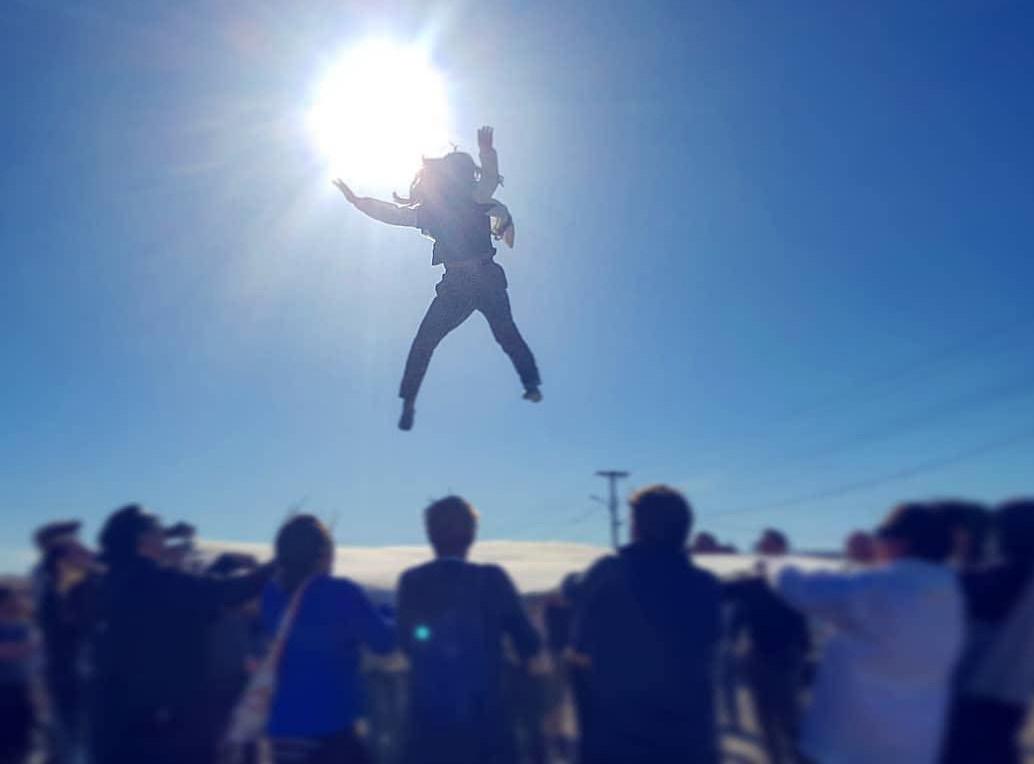 PHOTO BY STEWART BURNETT
PHOTO BY STEWART BURNETT
I feel really happy while I’m doing these Northern Games, because I’m representing my community.
INUUHIRIKTUQ HEALTH & WELLNESS 11 INGUTAAQTUQ / IS MOVING
@ JASMINE.GRUBEN
Karla Kuptana
COMMUNITY SAFETY AND WELLNESS THROUGH FIREFIGHTING
Why did you get involved with firefighting?
My whole family has been a part of the fire department at some point in time. I currently serve the Inuvik Fire Department (IFD) right now with my husband Kyle and my oldest sister Kristal.
What is your most memorable experience?
I don't think I have just one. Te whole experience is something you can't forget. So many great things have come out of being a part of the department. So many great friendships have been formed.
What would you say to someone wanting to join?
We encourage people to come and see if it's something for you. Stop by a training night. We do a lot of interesting stuf. You'd have to be willing to put a lot of your time into training, but it's so worth the hard work.
Being smart about what you are physically capable of doing is on your own judgment. If you know you can't do something, don't do it, just because. You are risking your own health and could potentially risk other firefighters’ lives.
What advice do you have for readers during a pandemic?
Take it one day at a time. Be patient and take this time to work on your self-care and mental health. It's a stressful time not knowing what the outcome might be.
WANT TO SERVE YOUR COMMUNITY?
If you are interested in joining your local fre department, but aren’t sure if its right for you, consider that there are many diverse roles. These range from: administration, emergency response, public education, mechanics, equipment maintenance, apparatus operation, emergency medical response, and fre suppression. Each of these roles employ diferent skillsets and strengths.
Once you decide to commit, you will be challenged, you will be pushed out of your comfort zone, and you will accomplish more than you ever thought possible. The only limit is time—it’s a big investment, but the rewards are worth it.
WHY YOU SHOULD JOIN:
u Service: it feels good to help other people.
v Team—or rather—family: there is a connection and sense of belonging built on trust.
w Constant challenge and growth: every call and every practice is unique and presents an opportunity to learn and grow.
—Cynthia Hammond, Fire Chief
AUYAQ SUMMER 2020 12 @ KARLARAEKUPTANA
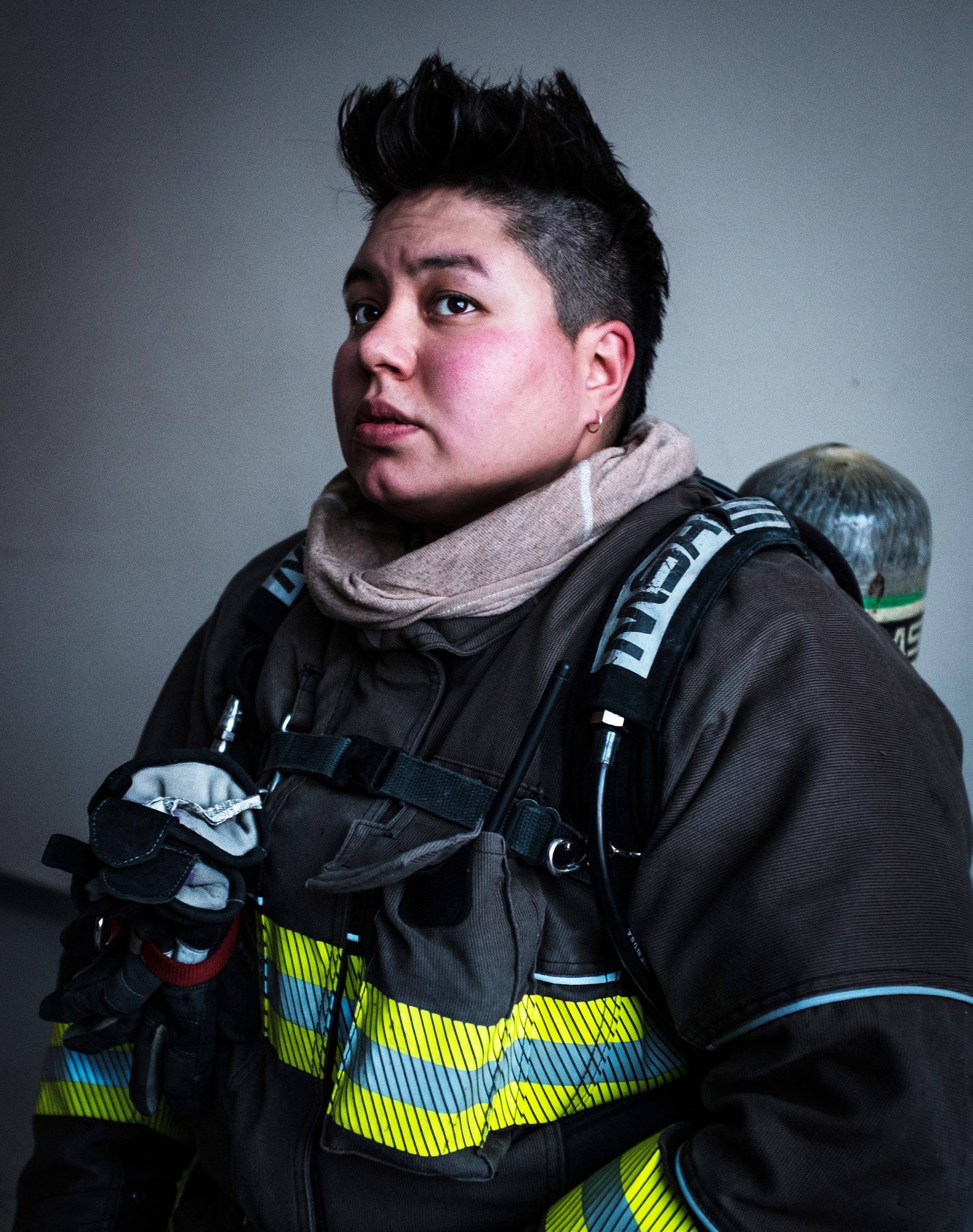 PHOTO BY WERONIKA MURRAY
PHOTO BY WERONIKA MURRAY
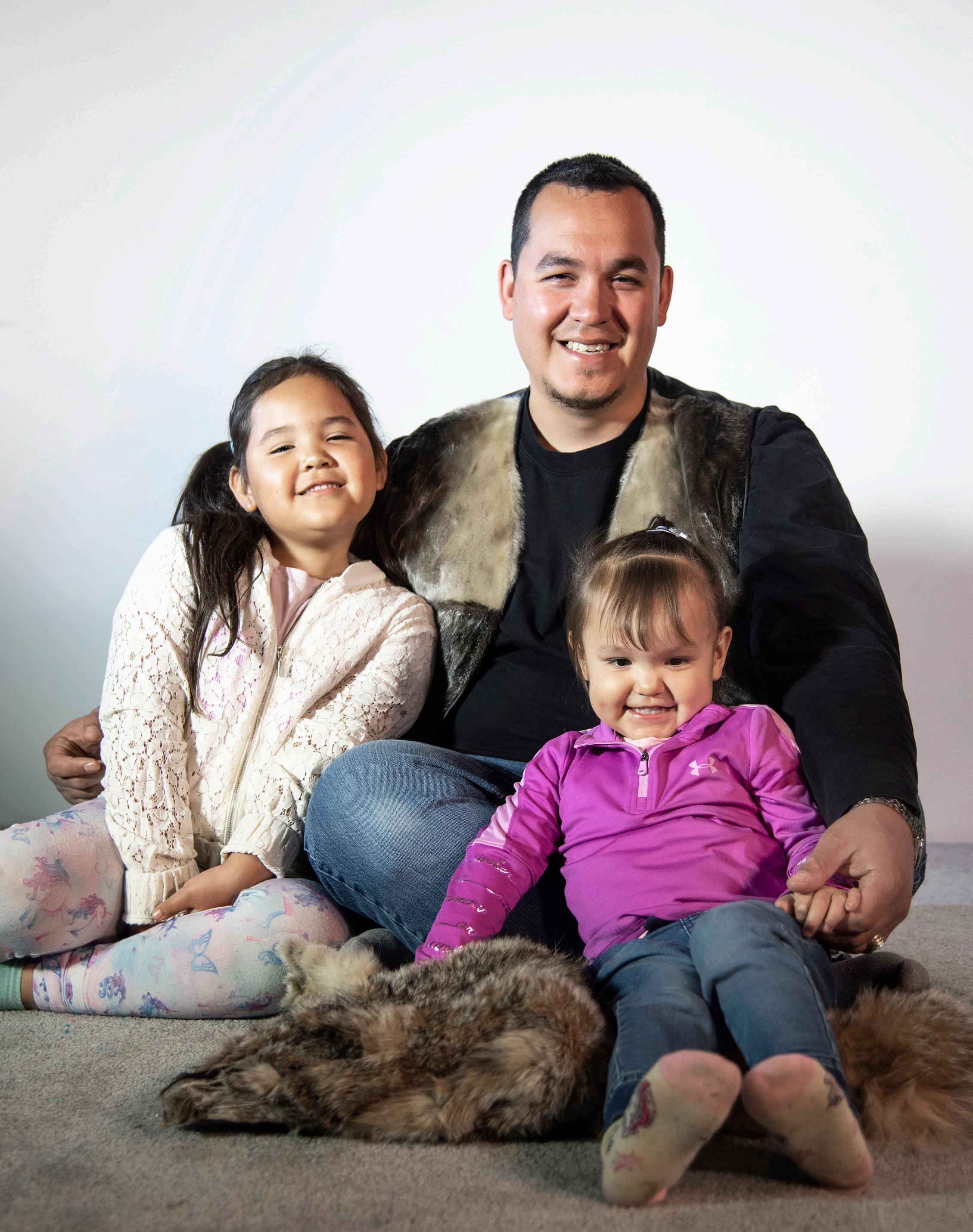
Dwayne Drescher
Adjgaliaq, Iñuuvingmiurunga (inhabitant of Iñuuvik). Ilihautrirunga Iñuvialuktunmik nutaqqanun (JK-6) Iliharvingmi (East Tree Elementary). Nuliaqaqtunga Muskoday First Nationmi Saskatchewanmin qairuaq. Atinga Deanna, aahiin pingahunik paniiraqaqtuguk. Atingik Ketarah "Agnaguluuk", Korah "Kaniq", Kyriahlu (piipiiraq aniruaq Julymi).
My name is Dwayne Drescher. I am from Inuvik, NWT. I am an Iñuvialuktun Language Instructor at East Tree Elementary School, teaching students from Junior Kindergarten to Grade 6. I am a husband and father of three daughters: Ketarah, Korah, and Kyriah (who just arrived in July). My wife’s name is Deanna, and she is from Muskoday First Nation in Saskatchewan.
INUUHIRIKTUQ HEALTH & WELLNESS 15 UQAUHIQ / LANGUAGE
I always had a knack for my language, especially when we returned to the Arctic after my parents pursued their education. Prior to that I did not know about diferent dialects, but I knew what I was learning in school was diferent from what I was taught as a child. You see, I grew up learning Sallirmiutun (previously known as Siglitun) as a young child, but began to learn Uummarmiutun throughout junior high, high school, and adulthood.
After high school, I still had an interest in Inuvialuktun, and began learning it on my own by reading the dictionary and grammar books. I ended up practicing on my dog, Siiku (a variation on siku, or ice), and soon he did not listen to English commands and only wanted to be commanded in Inuvialuktun! So, my parents and brothers had to learn the Inuvialuktun dog commands, and my friends thought it was cool and began speaking Inuvialuktun to my dog, too.
Anyways, a college professor caught wind of this, who was working with some Elders on a new program and approached me at work one day to tell me about the Aboriginal Language and Culture Instructor Program. Tat fall, I began the program with a dozen fluent speaking students and completed the program 2 years later. I want to say that I finished as a fluent speaker, but I would be lying—instead, let’s just say I got better at understanding, speaking, and writing my language, not to mention how to instructionally teach Inuvialuktun.
As an Inuvialuk with mixed blood, I think knowing Inuvialuktun helped me with my identity in that it rooted me into my culture and traditions. It is a real honour to say that I now teach my language to my people as a career.
When I was a young man, Inuvialuktun was considered “at risk” of being lost because the percentage of fluent speakers was low. Today, that percentage is even lower, as our fluent speakers, or Elders, are passing away. I want to challenge myself to become one of them fluent speakers, and to take it even further—I want to motivate and inspire others to want to learn, speak, and understand Inuvialuktun as well.
Inuvialuktun is important to me because it is a part of me, and it is a part of my children— and I do not want that to be removed. I want my children to one day say, “I’m an Inuvialuk
and can speak Inuvialuktun,” and teach it to their children.
I was fortunate to learn how to teach any Indigenous language, even before I became proficient in my Indigenous language. I also studied how to teach in general, any subject at any grade level—so in other words, teaching is ingrained in me. Right now, the GNWT is on its third draft of a piloting project for a new NWT Indigenous Languages curriculum document called “Our Languages Curriculum”. Tis is available online for anyone to see. I encourage people to look at this document, as it is amazing, especially that every school in the NWT is following it, even with diferent languages. Tey have a website specifically for this and you can view everything on: www.ourlanguagesnwt. com. Check it out!
Tey encourage us to tie in the Inuuqatigiit (‘Te Curriculum’ from the Inuit Perspective) document into our teachings, and I do this willingly—as it gives examples of diferent activities I can do with the students.
How do I go about teaching Inuvialuktun? I know this is a simple question, but I had to state the above mentioned: I simply speak Inuvialuktun and try my best not to include English—especially in my writing. I use illustrations a lot. I sing to my students often and have them sing too. I try to incorporate body language in a form called “Total Physical Response”, whereby you do actions as you say the words. I also try to get students to use “survival words” in Inuvialuktun (for example: Huna? – What?; Qanuq? – How?; Taifaarung – Say it again; Atchu! – I don’t know).
Tis COVID-19 pandemic and this “Continuity of Learning”, or learning from home, has made my role very challenging. Most of my students are considered ‘emergent speakers’, which is classified as before the ‘beginner’ stage.
Tis means that writing for the majority of the students is kept at a minimal, and learning is largely orally assessed, or spoken. So, I had to go out of this “norm” and attempt to teach without being there in person. Tis new approach weighs heavily on the parents/guardians, so not only am I teaching the students, but trying to teach the parents/guardians to teach Inuvialuktun to their children as well. I started by giving out as many resources as I could scrounge up,
16 AUYAQ SUMMER 2020
and then I tried writing Inuvialuktun in ways that people can easily understand. I first wrote it the way it is supposed to be written, and then I broke it down into syllables (Qanuqitpit? – Qan/uq/it/pit?), and then I wrote it in a way I assumed they would say it in the English phonetics (Qanuqitpit? – Canukhitbid?). Doing this is extra work, and if not done right, it can be confusing. So, I thought about creating videos to help the students and parents in their learning "Inuvialuktun from home" experience. Ten, I posted these videos online for all to see, and that’s how “Inuvialuktun with Ilihautri Adjgaliaq” was made.
At the moment, the YouTube channel’s purpose is to help the students with their homework packages. Tere are many families out there where Inuvialuktun is simply not spoken at home, and the YouTube channel is meant for them to utilize as a teaching resource for them. My goal is to get Inuvialuktun out there for people to hear and see, speak and sing, and eventually, read and write.
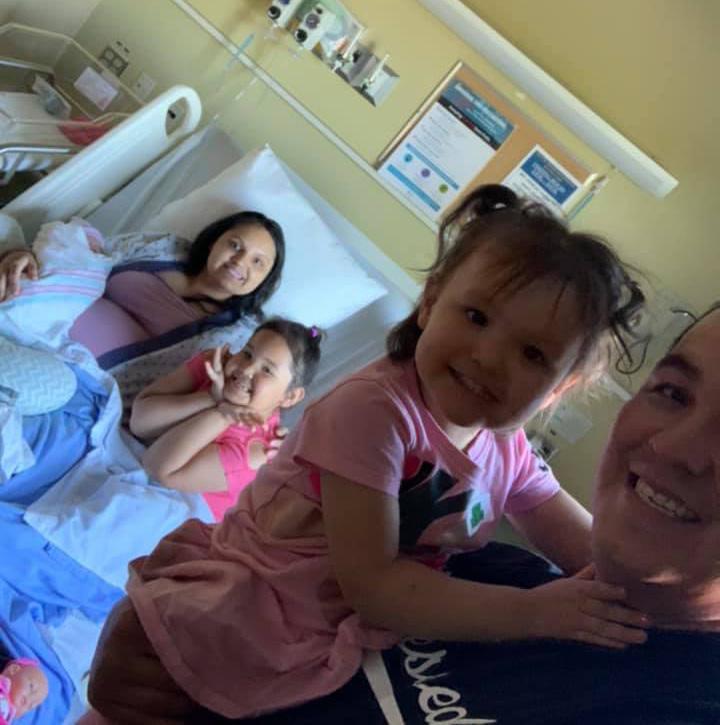


It is a public viewing webpage, so I feel that, with time, I may gear away from curricular-focused content. Tat being said, it will still be a language learning channel—so, it would all tie back to the curriculum regardless. As the channel continues to grow, videos will change in style, but no matter what, Inuvialuktun will still be the main focus. Another goal would be to keep the channel interesting, fun, and interactive.
8 Be patient: chances are you are learning along with them.
8 Repetition: try to say the letters, words, or sentences as many times as you can and as ofen as you can. I
ofen refer back to the sound vowel chart to help me with my vowels, and pronunciation.
8 Speak Inuvialuktun all the time and everywhere you go— Inuvialuktun is meant to be spoken, so try to use it as much as you can.


8 Listen to the old videos on Tamapta, Suaangan, and Tusaayaksat, and try to pick of what they are talking about. Hearing the language is just as important as speaking it. Go to my YouTube page, and follow along! (Inuvialuktun with Ilihautri Adjgaliaq)
8 Look into joining evening Inuvialuktun language classes, and practice with other people of all diferent age groups.
8 Call your teachers and ask for help. It is what we are trained and paid to do, and we love our jobs!
DWAYNE'S TOP TEACHER TIPS
INUUHIRIKTUQ HEALTH & WELLNESS 17 UQAUHIQ / LANGUAGE @ DWAYNERD
| Dwayne and Deanna welcomed their third daughter, Kyriah Grace Drescher, in Inuvik, at 4:39 p.m. on July 8, 2020—with a full head of hair.
 PHOTO BY KYNWILL GORDON-RUBEN
PHOTO BY KYNWILL GORDON-RUBEN
Alice J. Thrasher
REVITALIZING SALLIRMIUTUN WITH TEA, MAKTAK—AND FACEBOOK
I started doing the lessons through Facebook statuses at first. It took me a while to become comfortable with sharing it because I wasn’t sure if many people would be interested in following along and learning with me—publicly through social media. But I was wrong—there were many people who enjoyed the statuses as well as my videos, and the feedback is what kept me encouraged to keep on doing what I was doing. I’ve made a lot of mistakes while on my language journey, but I’ve learned from them. I used to be shy to speak our language, but my journey has taught me to let go of that and to speak it without being afraid of getting criticized or judged for making a mistake or
saying stuf wrong. It’s a part of the process of learning a language.
Our youth are starting to wake up and are hungry to learn our languages and traditions. Tey want to feel that connection with their Elders, with their land, with their identity, and they want to be able to express themselves the way their grandparents and great-grandparents once did. I decided to share what I learned in Inuvialuktun by sharing statuses, videos and creating quizzes to make it a little more fun in hopes of getting other members interested in wanting to learn it. Especially for those who lack the resource of having someone fluent who can teach them. So, I created the Facebook
INUUHIRIKTUQ HEALTH & WELLNESS 19 UQAUHIQ / LANGUAGE
Ublaakut! I returned home a little over a year ago because I missed home. I missed the food. I missed being surrounded by aspects of my culture, as well as our people. If there’s one thing I always held with me while I was gone—it was my pride in being Inuvialuit. I always shared that aspect of me with newcomers. I love our culture, and I especially love our language. It’s beautiful.
page ‘Tea & Maktak’. I wanted to show them the beauty of our language.
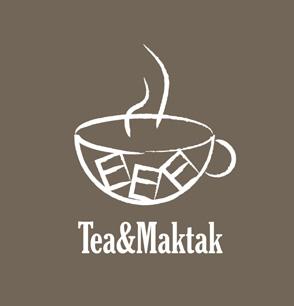
I believe it’s important for youths’ voices to be a driving force in the resurgence of culture, language and community empowerment because other youth will follow. Revitalization and advocacy on all fronts are needed from a multitude of generations and the youth group is full of potential.
I found the year of immersing myself into aspects of my culture to be very fulfilling. Whether it was learning my language, listening to the beat of the drums from the drummers and dancers, or learning a tradition that is otherwise known to be ‘asleep’ in the Western Arctic, I no longer felt disconnected. I felt balanced.
I am currently taking the Indigenous Governance Degree program through Yukon University, and within the course load there are preservation courses; I'm currently taking the Language Activism course this summer and will be taking the Language & Culture Protection course this fall. In Language Activism you're required to partake in studying activists and being an activist yourself, whereas in the
Language and Cultural Protection course it equips you with the knowledge to observe what areas of language protection can be improved and what shortfalls exist so that we can work on mitigating any further impact on our language and culture. Te program itself focuses on Western and Indigenous Worldviews as well as issues Indigenous people face, and language is one of them. I love the content they cover— very relevant to the North.
For parents who want to teach and learn Inuvialuktun with their kids: I would encourage them to start of small, but to also incorporate sufxes; that way, they will learn how to put sentences together. When you incorporate sufxes you not only learn how to create sentences, but you learn objects and actions as well. Also, listening to music produced in the Inuit dialogue is good for practice because the similarities between our dialects are plentiful. I would recommend artists such as Riit, Twin Flames, Aasiva, and the Jerry Cans, just to name a few.
 LEARN MORE: You can follow Alice's Facebook group, "Tea & Maktak", for the latest updates, videos, and other Inuvialuktun content.
LEARN MORE: You can follow Alice's Facebook group, "Tea & Maktak", for the latest updates, videos, and other Inuvialuktun content.
20 UPINRAAQ SUMMER 2020 @ AJULIA_ 02
LEFT: Alice Julia Thrasher reviews some Inuvialuktun words with her son, Jéth, in their Inuvik home. Photo: Kynwill Gordon-Ruben
SOBRIETY STORIES

We asked readers about their experiences with sobriety on Facebook, and were completely (positively) overwhelmed with the beautiful and thoughtful responses. Here are your inspiring Sobriety Stories.
*Responses edited for clarity.
INUUSIT / PROFILES
28 years and 2 months— incredible journey. Congratulations to anyone who can do this, it's very hard at the beginning. I did go back to higher education as well: four years of computers, PC engineering and have my BSc, in criminology, feminist and religious studies, beginnings of law in small scale societies. I am retired now, and I am a visual artist, old style acrylics.
—AGGI ETTAGIAK
I drank anytime it was available. I never realized how much I acted so diferent and unkind; also for the people in my life that I have said so many hurtful things to that I don’t remember. I had so much time to think about shutting it out of my life—which I didn’t care and never realized how rough it was until I asked myself: what do I get out of it? (OMG—embarrassing.) I fell of the wagon once in 6 months when I think of the days I have missed and how I felt and what has been happening revolving around alcohol. I am healthy, happy and more active in things I never paid attention to today. And I am grateful for my future husband for standing beside me every step of my obstacles. My thought of my past.
—Joanne Green
I hit my rock bottom the summer of 2017. I’ll be 3 years sober on August 6th. I have 2 kids. Afer my frst year of sobriety, my mom was diagnosed with cancer; I lost her in March 2019 and I stayed sober through it all. Kinda short version of my story. I’m grateful to be sober and for the life I have now.
—Evangeline Kapotaon
Going on like almost 20 years. I've had the odd glass of wine or bottle of beer in that time for social reasons. But compared to who I used to be, alcohol has no place in my life. I've had a six pack of Belgian beer in my fridge for over 2 years. No desire to touch them.
—Scott Dillon
Sober much too long, but I do feel better and ofen get asked if I long for it or if I “need a shot.” Nope never think of it nor desire for it. The choice is mine alone, and if I want to have a “shot”, I’ll have a shot. Again, my choice! No one else but mine, stay happy, eh.
—Herman R. Kaglik
When I graduated high school! Sounds great but that was only 5 years ago. Wanted to teach my children it's never too late to finish school and then thought about teaching them to celebrate an achievement without alcohol. Made a change and don't miss any of it!
22 AUYAQ SUMMER 2020
—ELIZABETH AREY
Parties were introduced to me at the age of ffeen. I thought it was cool to follow my older cousins to parties, only to fgure out in the long run it was just for their protection. Make sure no one bothered them. I carried the parties within me for a good 18 years before I realized how much of my life could have been diferent. I struggled by my lonesome to stop drinking. Still to this day [I] have a strong urge to drink. It’s been easier since, I realize how badly it has [afected] me. Not only me, but the people who were younger than I was. I wish I didn't carry on this addiction to others. I am sorry to the ones who did. I wish things can be diferent for all of us. Each and every one. It's a waste of precious time and money. My little boy is my savior. I look at him and I think you will not see what I seen. I will not expose you to such evil. What they call spirit water.
—Crystal Kongayona
I never like to count the days, weeks, months or years. I am just happy to say it’s been a good long stretch since I tasted alcohol. One of the best personal choices I’ve made for a better tomorrow.
—Janet Elias
I'm going on 5 months sober. Before that it was once in a blue moon. I used to like my occasional drink in moderation. But I choose to be sober because I found a man that is going on 4th year of sobriety. Together we choose to live a sober, clean, and healthy life for my daughter, and our future children. I don't want my children having to recover their childhood because of drinking. We choose the life we want to live. And we choose to be sober.
—Janeen Chelsey
20 years for me, and 6 months...since my frst granddaughter was born and she was 3 months and 3 weeks too early, so I really had to pray for her to live, and locked myself in my room for 3 days straight to do that. I told God that I would quit. Afer the fast, my mind was so clear. I just [knew] exactly what to do, and that was break up with my boyfriend/lover who was an alcoholic. My granddaughter who is 20 now, is alive and well, and healthy. I fell twice but got back on track.
—Clara Bates
18 years and not counting. I started at a young age of 11 or so after a tragic accident. Progressed worse as I got older; in trouble at school and law. Time away from family while incarcerated. Sobered up briefly to work, spent money ‘til I was broke.
Relationships and children, them children I am proud of. Took me to the bottom of the barrel and a visit to a hospital. I am set free now. Living a sober life and helping others in addictions. Giving back. I love life.
—JOEY AMOS
I envisioned my future with alcohol, married and with children. And I did not like the idea of coming home late drunk, banging and yelling around, waking up my kids and scaring my family. I was 26 years old when I had that vision, and that’s when I decided to put down the bottle. Since then, I’ve been 8 years sober. I’m married now to a wonderful wife who is also about that sober life. We have three beautiful, smart daughters. Oh and during my journey, I also got my degree, started my career, and next school year will be my ffh year as an Indigenous educator! Things are only getting better from here! Thanks to my sobriety.
—Dwayne Drescher
Almost 13 years drug-free, almost 12 years alcohol-free and almost 11 years tobacco-free; love the lifestyle. My Hubby and I live happy, joyous, and free. My 100-year-old Grandmother, the late Persis Gruben, told me I was a good example to my Community of Tuktoyaktuk. Made me feel blessed.
—EDNA GRUBEN
INUUHIRIKTUQ HEALTH & WELLNESS 23 SOBRIETY STORIES
 PHOTO SUBMITTED by STARLA SHORT
@ STARLALOHA
PHOTO SUBMITTED by STARLA SHORT
@ STARLALOHA
Starla Short
I am fascinated with a healthy lifestyle; I enjoy challenging my myself and setting health goals. With COVID-19 afecting my career, along came down time and minimal activity. I took this as a perfect opportunity to partake in a 28-day health challenge with my friend Brian, who was more than willing to join me. We chose to eliminate certain bad habits, such as processed foods and alcohol. We checked in on each other’s wellbeing each day, talking truthfully about what was on our minds. We felt as though we were thriving so much that we decided to extend the 28 days into 40!
According to psychologists, it takes 21 days of conscious and consistent efort to create a new habit. After the challenge was complete, Brian and I grew closer and picked up some new habits we are proud to say we are maintaining and using in our everyday lives. We are now looking into other challenges, since gyms are opening up in Edmonton; we plan to live a much more healthy lifestyle, be it physically and mentally.
Finding a friend to embark on such a journey with has helped us maintain accountability and made this challenge that much more rewarding as we had the feeling of connectedness. Even with Brian living in Inuvik and myself in Edmonton, we were able to show our friends and loved ones that if I can do it, so can they!
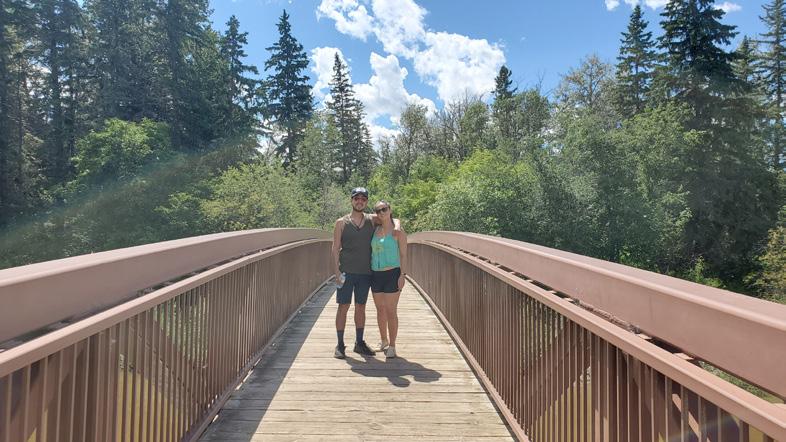
We can start with what we have from where we are at this very moment. A glass of water or a small walk can go a long way, and by consistently engaging in these small healthy activities each day, we will see major changes not only in our appearance—but in relationships with loved ones and acquaintances as well, because with self-care comes self-love.
I will leave you with one of my favourite quotes from Louise Hay that I find inspirational: "I choose to make the rest of my life the best of my life.”
THE 28 DAYS OF SOBRIETY CHALLENGE
INUUHIRIKTUQ HEALTH & WELLNESS 25 SOBRIETY STORIES
“Every time you eat or drink, you are either feeding disease or fighting it."
Brian Kowikchuk
Hello, my friends and family, near and far. Hello to those I have yet to meet, those I probably will never get to. I sit here and think about the 28 Day Sobriety Challenge (that evolved into a 40 Day Challenge) that Starla and I completed. I am now sitting with experience, confidence, and a sense of courage to speak about health and wellness that was manifested in the process. In the previous edition, you were a part of the realities and importance to stabilize consistency of the Inuvialuit culture. People utilized art therapy to communicate their emotions, messages, and sense of wellbeing.
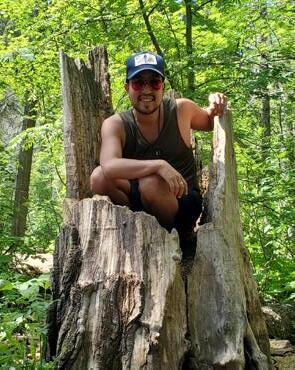
Te few words I will leave you in this article will be of the same nature, but in a diferent form. I once wrote about how water comes in diferent forms: ice, water, rain, and air. So does love—the diferent languages of love. Love does not always come in the shape of a heart. It comes in the way we give our children a sense of security, the food we give and take, the ingestion of social media, kind words, checking up on your naanak and taatak. A shaman once spoke that the definition of poison is ‘too much of anything’. Te purest form of love is given. Te thing about self-love is, when it is given to yourself, you then have more for others. Tat, in turn, is not poison. It is power.
Starla and I were becoming synchronized in those 40 days, and even more so now. Recogniz-
ing internal battles, we became warriors of our own. Tere is no greater battle than one with yourself. It is so easy to lose. Especially if you have nobody but yourself to convince you won. Together, though, we were able to encourage our growth together and cheer each other on. During COVID-19, being home alone for two weeks after my return home from Alberta was isolating enough. You are not alone if you have a goal, a friend, a destination. Reflecting back on the halfway point, our sense of communication was better. We became addicted to searching for more things that made us and the people in our circles feel better. We started ‘vibing’. Music! Food! Cofee! And do not get me started about chocolate. I was kind of annoyed with myself for neglecting all good basics. With all the dealing of intergenerational trauma from residential schools in the past, it was the sweetest escape, just to sit and convince ourselves that we are more—we are worthy. Not saying we never believed that about ourselves, but to really sit and listen to the inner voice was a conversation well worth any kind of commitment.
Tere is always going to be times when you will have distractions, or be the distraction. So, distract yourself with good things. I hope my (more than) few words have helped your emotional development. Remember—believe in yourself. Tey have no choice but to believe with you once you do. All the best!
THE 28 DAYS OF SOBRIETY CHALLENGE
26 AUYAQ SUMMER 2020 @ KOWIKCHUK
Tanis Blake

I remember having multiple babysitters and much of my time was spent with relatives, but my parents made darn sure we were well-taken care of and that we had a safe shelter over our heads.
At the age of 16, I had my first taste of alcohol but hadn’t started my addictions until I turned 18. I liked the feeling alcohol gave me. It made me a whole diferent person; it instantly became a part of me. And I would always turn to alcohol because it made me feel powerful and in control. Te withdrawals took over my life! Eventually, I felt hopeless, sad, angry, and depressed. It was at that point in my life when I would abuse alcohol daily for about a year or two. It was a constant battle to feed my addiction every single weekend. I drank from anger, I drank from emotions, I drank to run from my problems, and I drank because at the time I thought I was having the time of my life. If you’re like most drinkers, you’ve likely surrounded yourself at some point with a group of people who also drink. I’d argue that many of us gravitated to a group of friends who have drinking habits that align with our own, and we did this because we didn’t want sober friends.
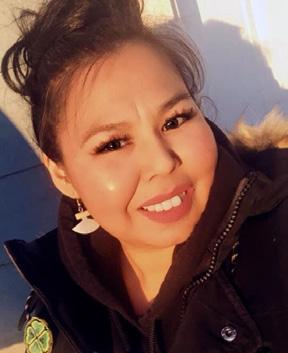
In 2008, I moved away from home to start over and tried to improve my alcoholism, by keeping myself busy with work and focusing on myself. I still had a few drinks here and there, but not a lot like I used to when I lived in my hometown. I had more control over the withdrawals, but still had the same feelings as before, while abusing both drugs and alcohol.
Back in 2010, I met my husband Brent! We met while sober and afterwards I continued drinking until I moved to Fort McPherson. We would have a couple beers here and there every few months, and finally in June of 2018 we called it quits for good. My life was no longer compatible to the life that I had been living as a drunk. I’m happier, healthier, and a better mom. Alcohol stole fourteen years of my life, and this year of 2020 I am celebrating two years of sobriety—two years since I first started seriously questioning my relationship with alcohol and considered a life without it.
Te life I had before I quit drinking was a lot like Groundhog Day. I was always waiting for it to begin and always reliving the same stuf, day after day, year after year. When I finally
MY JOURNEY TO RECOVERY
INUUHIRIKTUQ HEALTH & WELLNESS 27 SOBRIETY STORIES
My name is Tanis Blake and I’m 33 years old. My sobriety date is June 16th, 2018. My younger years haven’t been the easiest because of the alcoholism in our household.
walked away from booze at 31, my life opened up. I can honestly say that sobriety is the best thing I have ever done for myself. It was my jumping-of point into a life I knew I had buried inside of me. While making the decision to be sober was the best thing I’ve ever done, it has also been one of the hardest. Not only because not drinking is hard, but also because we live in a society where most everyone around us drinks. Instead, I started a sewing business, which provides so many opportunities for myself and my family.
As I sit here writing this story, I break down with tears from thinking of all those years I missed out with my loved ones. It is very heartbreaking...
But I am grateful for the person I am today, living in a clean and sober environment. To start the process of accepting and acknowledging the things we carry inside—the things about us that we are too scared or ashamed to share—these are things that you and only you alone can begin to fix.
When you can look inside, really take care of the pain, rejection, humiliation, disappointment, and shame, then you can really begin to build your life to be one that feels content. You can address a number of mental health issues
along the way: navigating children, bereavement, and general life. But wow—it has made me so resilient. Tings that would have sent me into a complete spiral before barely phase me now. I am content in myself. I do not seek validation or approval from other people to feel complete. I carry the feeling of ‘I am enough!’ in my heart, and I remind myself daily of how strong I am—how I got through so much and flourished.
For those who have not yet begun healing those dark parts, or for those who are struggling: the hard work pays of. Life can be stable. You can be content.
And to those out there who are struggling with addictions: just know that help is out there wherever you turn—you just can’t be afraid to ask for it. Life is so much more beautiful than the darkness in which you have been living.
I am grateful for my sobriety. And now, I’m grateful for my life because it’s one that’s worth living. Mahsi’ cho and quyanainni to my family—and especially my husband. We are in this together and taking each day as a blessing. Here’s to a lifetime of sobriety.
@ BLAKERS.04 28 UPINRAAQ SUMMER 2020
Te life I had before I quit drinking was a lot like Groundhog Day. I was always waiting for it to begin and always reliving the same stuf, day after day, year after year.
THE NAMES OF MY FAMILY: Ayauniq is my grandmother’s Inuvialuktun name; Gunewyoung is my Dad’s Inuvialuktun name; Gwichi’inuk is Gwich’in and Inuvialuit together as one word; Akak (Okkok) is my grandfather’s Inuvialuktun name; and Akuluk is my Inuvialuktun name.

PANDEMIC PERSPECTIVES
 ARTWORK BY ALEXANDRA ALEEKUK
ARTWORK BY ALEXANDRA ALEEKUK
HOW'VE YOU BEEN KEEPING BUSY DURING COVID-19?
With COVID-19 happening, there’s tons of time to travel inward. I’ve been connecting to myself by learning to be more mindful, learning breathing techniques, and learning to move and live more in tune with nature. I have been learning to let nature heal and have also been using art in all forms such as: painting, stick and poke tattooing, harvesting, gardening, and learning to dance with fire and fire fan flow! (A fire fan flow is a device used to created visual efects with fire, usually by lighting large torches on fire and twirling them around while dancing. Most people associate this activity with street performers or music festival attendees.)
HOW HAVE YOU BEEN TRYING TO MAINTAIN A SENSE OF CULTURE?
Staying connected with culture starts with staying connected to myself; keeping a strong sense of self gives me more space to breathe and explore new parts of my identity. I like to stay open to knowledge exploration and I think as Inuvialuit that's a big part of who we are, always learning and exploring.
WHAT WOULD YOU SAY TO INUVIALUIT WHO ARE HAVING A DIFFICULT TIME COPING?
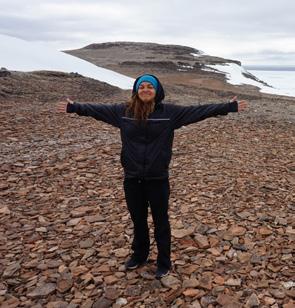

I too struggle and it's a battle that's always evident. However, staying honest to it is an important part of the progress. It’s okay to struggle, ask for help, heal, grow, and evolve. It can't be done alone, and support is always needed; if you feel you have no support, I am here through these words. Try loving yourself first and focus on filling your cup before trying to fill anyone else’s.
f ALEXANDRA'S PANDEMIC PLAYLIST
} Apes of the State
} Days n Daze
} Wookie Foot
} Nahko and Medicine for the People
} Fever Ray
} Lost Dog Street Band
} DUB FX & Sahida
} Aspara
} The Jerry Cans
} Silla and Rise
} A Tribe Called Red
} Bob Marley
} Sublime
} NOFX
} Pat the Bunny
} Stick and Poke
I’ve decided to ask my two courageous, beautiful sisters some questions about how they’ve been coping with this pandemic. How do they see the challenges that we all face, their individual challenges, and coping with isolation?
—Interview by Kyle Natkusiak Aleekuk
Alexandra INUUHIRIKTUQ HEALTH & WELLNESS 31 UQAMAAQATIGIYAA / TALK WITH
 PHOTO SUBMITTED by KAILIN ALEEKUK
PHOTO SUBMITTED by KAILIN ALEEKUK
Kailin UQAMAAQATIGIYAA / TALK WITH
HOW IS YOUR LIFE LIKE AS A FRONT-LINE WORKER?
Well, to be honest, at first it was a little alarming. Not knowing what the day to day was going to look like and the uncertainty definitely weighed on my family and me. As we got into the first few weeks of the pandemic, it really started to become surreal for us. I've been working throughout this whole pandemic and [it was] shocking to see everything that wasn't considered essential be shut down. No trafc to fight on the roads and no one walking in the streets at 5 p.m. It's weird when you live in a city with a significant amount of people and the streets are empty. It was like something out of a movie. Society is programmed to go to work, make money, and come home. Tat's the norm. No one ever tells you how to handle life through a health crisis. Never did I anticipate that going to work could mean putting my family and me at risk just by leaving my home. It was scary to think about, but it had to be done. As a mom, it's my job to make sure my family has everything they need to live comfortably even if it means putting myself at risk whether there’s a pandemic or not. I still have to go to work and come home and do whatever it takes to keep them safe while trying to keep myself safe, too. Honestly, I think it's a small price to pay. Not everyone has a strong immune system to fight this virus. Life is precious, so why take risks when you can just take the extra steps to help keep everyone else safe, too? I think Alberta Health Services took
the appropriate measures at the right times because our numbers of infected are very low compared to other parts of the province. A constant comfort has been my job that I am very grateful to have and the good people I work with. I work for Nurse Next Door, which is a home care service providing support for administration, as well as scheduling caregivers with clients. We have been providing care 24/7 throughout this pandemic and it has definitely been a privilege for me to be a part of this hardworking team of people.
DESCRIBE WHAT IT’S LIKE COMING HOME AFTER A DAY AT WORK. ROUTINES, FOOD, TIME WITH FAMILY… HOW IS THAT MANAGED WHILE PRACTICING HYGIENE AT A GREATER LEVEL?
Coming home has always been my favourite part of the day just because I get to see my son and my husband. Not much has changed for them because they are at home, but for me, it’s a little diferent. Tat means changing out of my work clothes as soon as I get home and washing my hands before I even touch either of them. Our son, Alexander, is 22 months old and doesn’t understand what is happening right now in our world, so I never deny him of the afection he needs. We try to keep things as normal for him as possible. Trevor and I just really make sure we take all of the necessary precautions and make sure everything is clean INUUHIRIKTUQ HEALTH & WELLNESS 33
and sanitized for our son's sake and for ours. Other routines definitely were shaken up as well. Taking Alexander on walks was quite the experience. As any Mom of a two-year-old would know, social distancing can sometimes be a little bit of a challenge. Alexander loves to run and, of course, we let him, while also respecting other people's space. We try to pick times when the walking paths aren't too busy —just to be safe.
Te three of us would usually grocery shop together as a family but now it's mostly just my husband Trevor going into the stores with gloves and a mask on while Alexander and I wait in the truck. We will continue to practice this until we feel it is safe enough to venture out again. It's a small price to pay for safety and we don't want to take any unnecessary risks. Even if people think things are going back to normal, things will never be the same after this.
HOW DO YOU MANAGE YOUR STRESS THROUGHOUT THIS?
I definitely thought that this was going to be an area that I would personally struggle with, but it actually hasn't been that difcult. Maintaining some kind of routine is really important, especially if you have a family and a little one. Tey need consistency and routine and we have been very diligent about that. We are so grateful Alexander's such a happy little guy. Spending time with him and Trevor is a huge stress reliever. I get to be in the moment with my family and forget the outside world. I also find it important to listen to yourself and your own needs. Yoga helps me a lot, too, as I have often struggled with anxiety and also decreased body strength. It's something that not only helps me focus mentally, but also physically helps me build my strength back
up. Tere is no deadlier combination than that. Plus, my son likes to try and do yoga with me and it's adorable to watch. It's motivation to keep doing it.
Also, music is a go-to for me and it always has been. Everyone has that one song they can go to that helps them feel better. Like my Grandma always says, there is a song for everything—and that's something that has always been comforting to me and has stuck with me ever since I was a kid. Being kind to myself mentally in these ways helps manage my stress. Whether I'm doing yoga or listening to music or even just taking 5 minutes in silence to myself, I try and find some kind of time for self-care. It's important to love yourself and I continue to do that every day. It’s also really important to stay in contact with friends and family during these times. We are social creatures by nature, which must make this experience hard for a lot of people. I like to Facetime with my Mom and stay in touch with friends and family. We are all just doing the best we can right now, and I feel lucky to have friends and family to connect with because I’d go crazy if I didn’t!
WHAT’S YOUR FAVOURITE QUARANTINE DISH EATEN SO FAR?
My husband Trevor is an amazing cook. Alexander and I are pretty lucky to say the least. I'd have to say my favorite dish that Trevor has made so far is ground turkey enchiladas with cheese sauce; they are so good that they are literally restaurant quality. He also makes rice mixed with enchilada sauce as a side dish and it’s so good. It's almost a weekly meal in this household!
34 AUYAQ SUMMER 2020
@ KAILINELIZABETHH
ARTWORK BY ALEXANDRA ALEEKUK
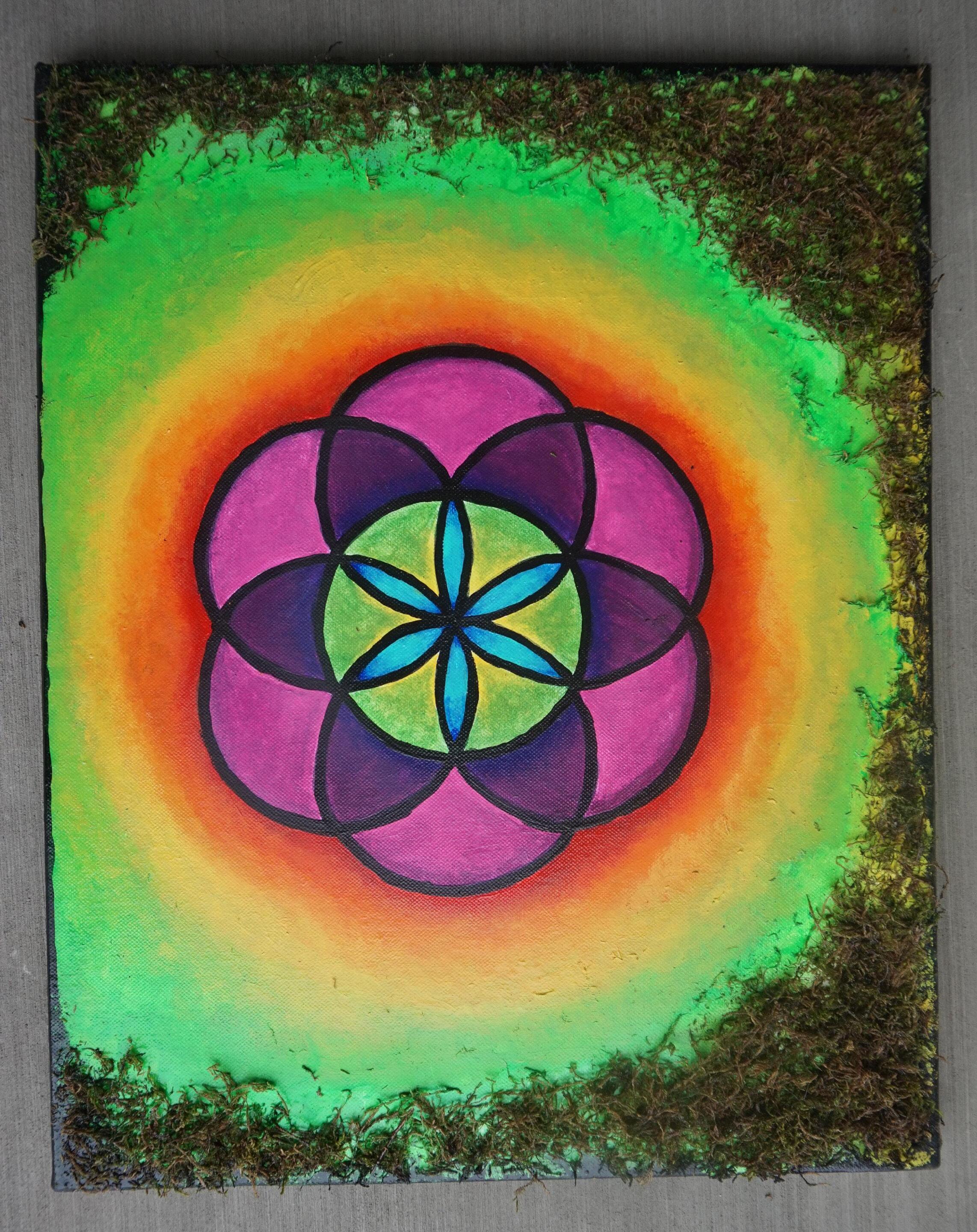
 WORDS & PHOTOS by KYNWILL GORDON-RUBEN @KYN_TOMMY
WORDS & PHOTOS by KYNWILL GORDON-RUBEN @KYN_TOMMY
 LEFT : Pat Kuptana tweaking his self-made goose calls—his pastime of choice when on the land—while on the lookout for geese.
LEFT : Pat Kuptana tweaking his self-made goose calls—his pastime of choice when on the land—while on the lookout for geese.
PIKSALIUQTAA / PHOTOGRAPH SIGLIALUK—COASTAL
NEAR TUKTOYAKTUK 37
ABOVE : Cole ‘Nunga’ Felix demonstrating his specklebelly goose calling in-between shooting, while Michael Krengnektak watches on.
CAMP
 BELOW : Nathan Kuptana and Kolton Gordon-Ruben pluck the frst catch in preparation for fresh goose soup in the blind.
Words & Photo: Kynwill GordonRuben (@kyn_tommy)
BELOW : Nathan Kuptana and Kolton Gordon-Ruben pluck the frst catch in preparation for fresh goose soup in the blind.
Words & Photo: Kynwill GordonRuben (@kyn_tommy)
TYRONE RADDI'S STUFFED GOOSE

1. De-bone the goose.

2. Thin out breast and season with whatever you’d like.
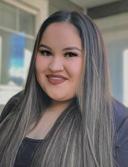
3. Once deboned, you can also put a layer of pancetta then a layer of Gouda cheese.
4. Put a layer of stufng inside the goose with bacon, celery, and small cubed apples. Add whatever else you like here, too, such as onions, gizzard, lots of sage, and cranberries.
5. Wrap the goose in parchment paper, then in tin foil, and cook. You'll have to fip it every 10 minutes on fre, or cook at 350oC for 1.5 hours. Good stuf
ALAINNA CARPENTER'S BANKS ISLAND TOMATO VEGETABLE CARIBOU SOUP
1. Fry the caribou meat in garlic powder, seasoning salt, Montréal steak spice, and diced onions.
2. Add water afer the meat is browned.
3. Boil for a good hour and a half; add a little bit of beef stock, carrots, rice, and macaroni shells.
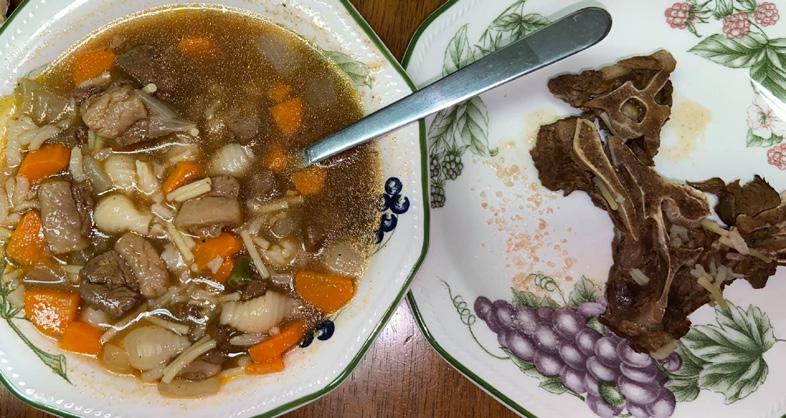
4. Add two packets of tomato vegetable soup mix in a separate bowl with a little bit of cold water. Mix it with a fork to take clumps out.
5. Add the tomato vegetable mix to the boiled water.
6. The soup is ready to eat 5-10 mins afer Step 5 (make sure the noodles and shells don’t get soggy).
MAMAQTUQ! DELICIOUS! 39
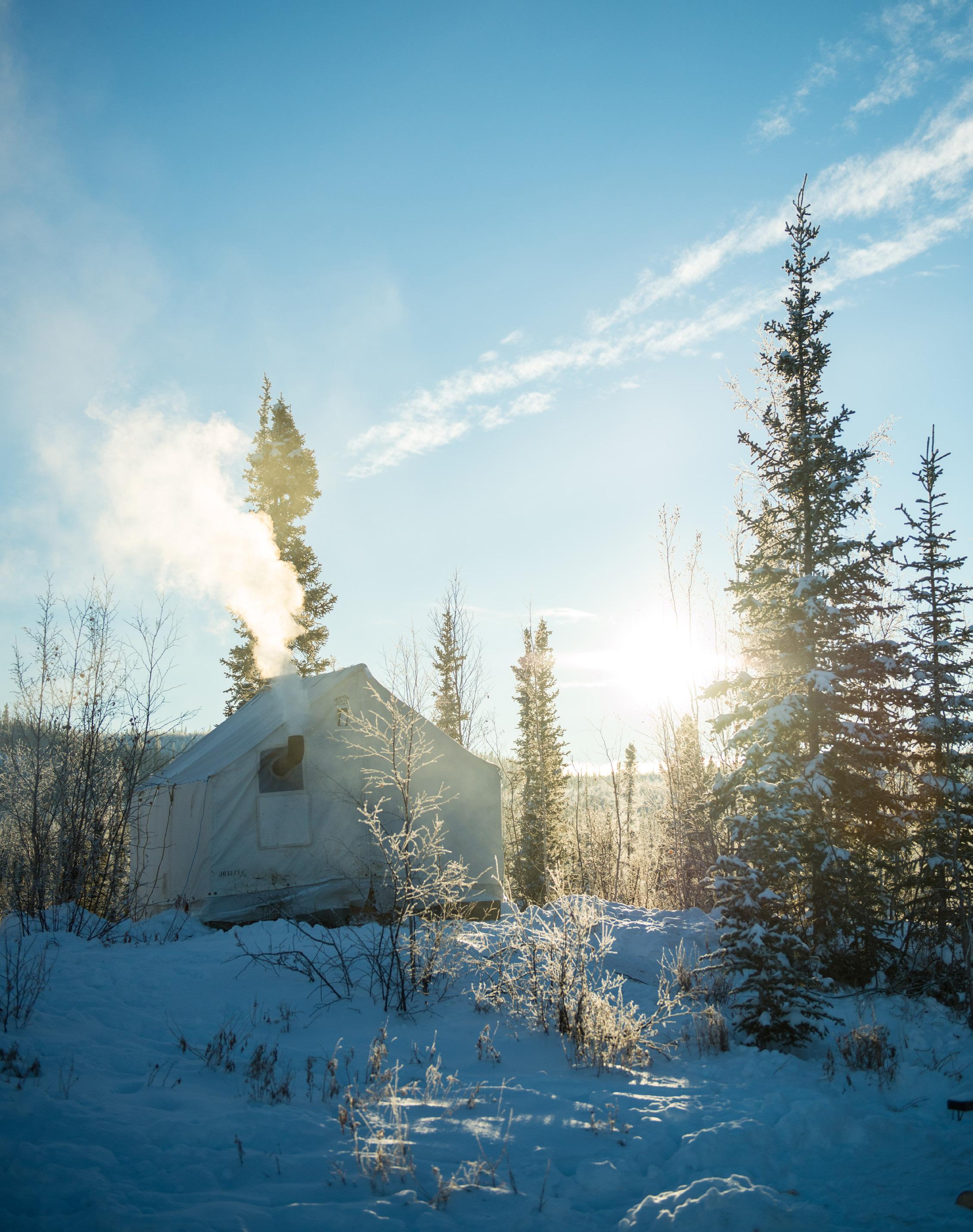 Leadership retreat views at the Project Jewel campsite, Gwich'in Territorial Campgrounds, October 2018. Photo: Shayla Snowshoe.
Leadership retreat views at the Project Jewel campsite, Gwich'in Territorial Campgrounds, October 2018. Photo: Shayla Snowshoe.
WESTERN ARCTIC YOUTH COLLECTIVE
Te original idea of this project was first discussed in October 2018, when Indigenous youth shared the value of gathering in the Beaufort Delta region on an annual basis. A leadership retreat for the Inuvialuit Regional Corporation’s (IRC's) Regional Youth Advisory Group (RYAG) and Gwich’in Tribal Council’s (GTC's) Regional Youth Council (RYC) was coordinated to introduce both groups to share their objectives and priorities, build relationships, and discuss potential collaborations for upcoming years. It was the first time both groups were brought together in that capacity.
41
Ultimately, the priority was creating ongoing opportunities to support and prepare youth to be positive changemakers in their communities, as they experience unique and complex social realities in remote and isolated communities of the Western Arctic was the priority. The frst collaborations took place in 2019—a youth gathering at Midway Lake in August, and a hide culture camp at Project Jewel’s campsite in Gwich’in campgrounds in September. As of March 2020, the Western Arctic Youth Collective (WAYC) became an ofcial project of Makeway Charitable Society.

COVID-19 has unfortunately postponed our initial launch and programming that was intended to begin in summer 2020. However, over the month of August and September, WAYC will begin hosting virtual programming for youth ages 18-35, so stay tuned!
In the coming years, through on-the-land gatherings, cross-cultural exchanges, retreats, and ongoing trainings, we hope youth will expand their:
leadership skills;
critical thinking skills;
presentation and facilitation skills;
consultation, engagement, negotiation skills;
fnancing, budgeting, and evaluation skills;
relationship-building and networking skills;
traditional and cross-cultural knowledge;
social and environmental justice;
anti-racism knowledge;
and increase their overall confdence, selfdetermination and self-awareness.
Te conversation continued imagining what an Indigenous youth-led initiative can do based on core values collectively shared in the region.
I have heard and witnessed the value of youth gathering together on-the-land; it is vital to their identity and sense of belonging when creating spaces for programming. I myself am fnding small ways to relearn and incorporate precious teachings and knowledge I have been fortunate to access, but I have learned that so much work internally needs to be acknowledged, loved, and nurtured. Youth are becoming more and more vocal in these shared spaces of the amount of grief, trauma, sadness, sense of hopelessness, frustration, and anger that they carry, and how challenging it is to cope with in a good way. They share the overwhelming amounts of pressure to be leaders, advocates, complete high school, be sober, break toxic cycles, attend college, have a family, practice their culture and language, as well as learn their history and traditions. Many of the participants shared that they witness and experience lateral violence on social media and in their communities daily. And unfortunately, the loss to addictions, violence, and suicide in our communities is a constant tragedy. Through WAYC, we hope to create spaces for youth to thrive, build meaningful relationships and connections, and help contribute to positive changes in our communities that we love and cherish. —

ALYSSA CARPENTER
(ABOVE) Delegates discuss the cycle of grief collectively experienced in their respective communities, at Rock River, during the Midway Youth Leadership Retreat, August 2019.
Photo: Asad Chishti.
(LEFT) Group photo at Midway Youth Gathering, August 2019.
43
Photo: Asad Chishti.
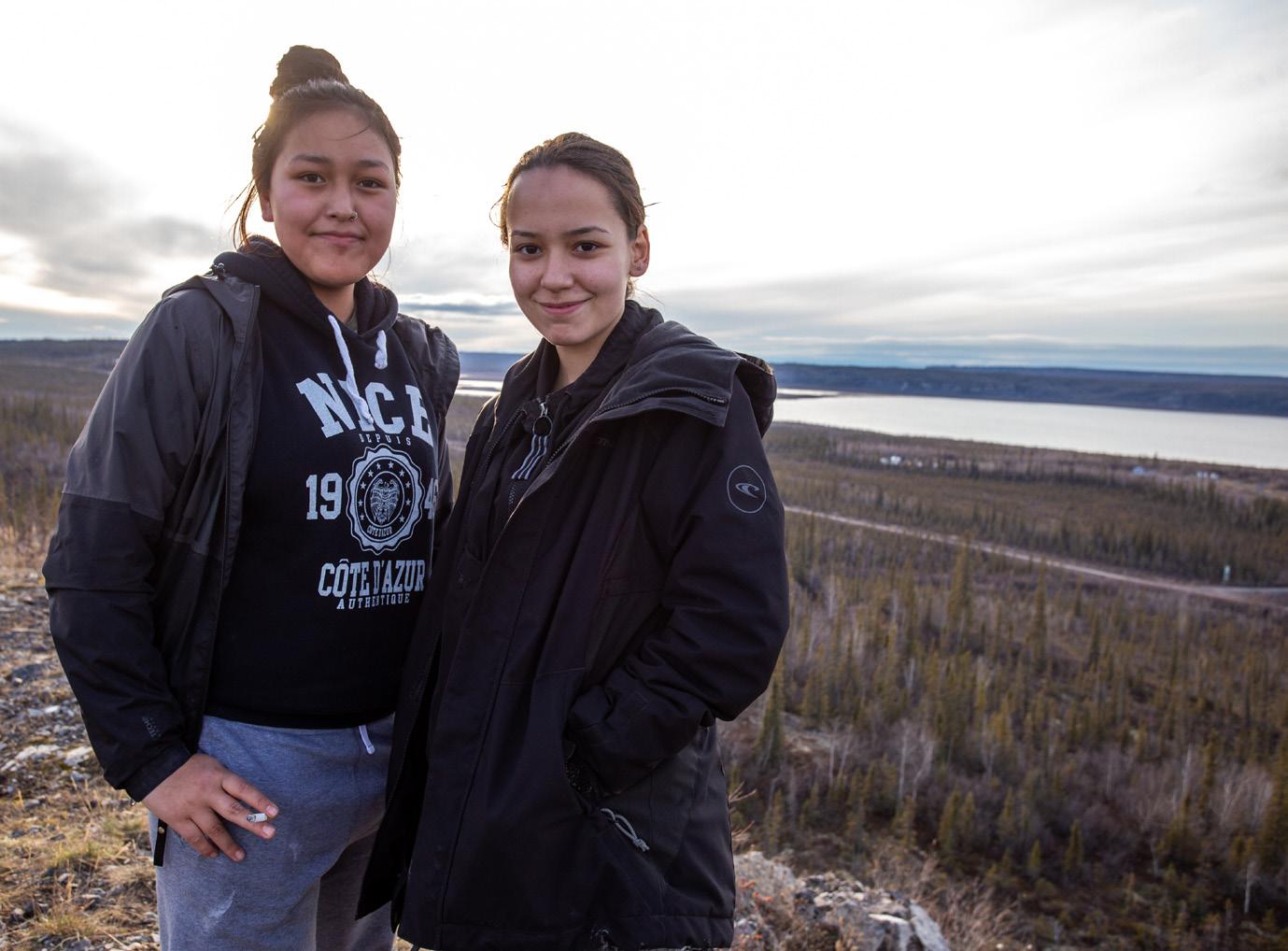

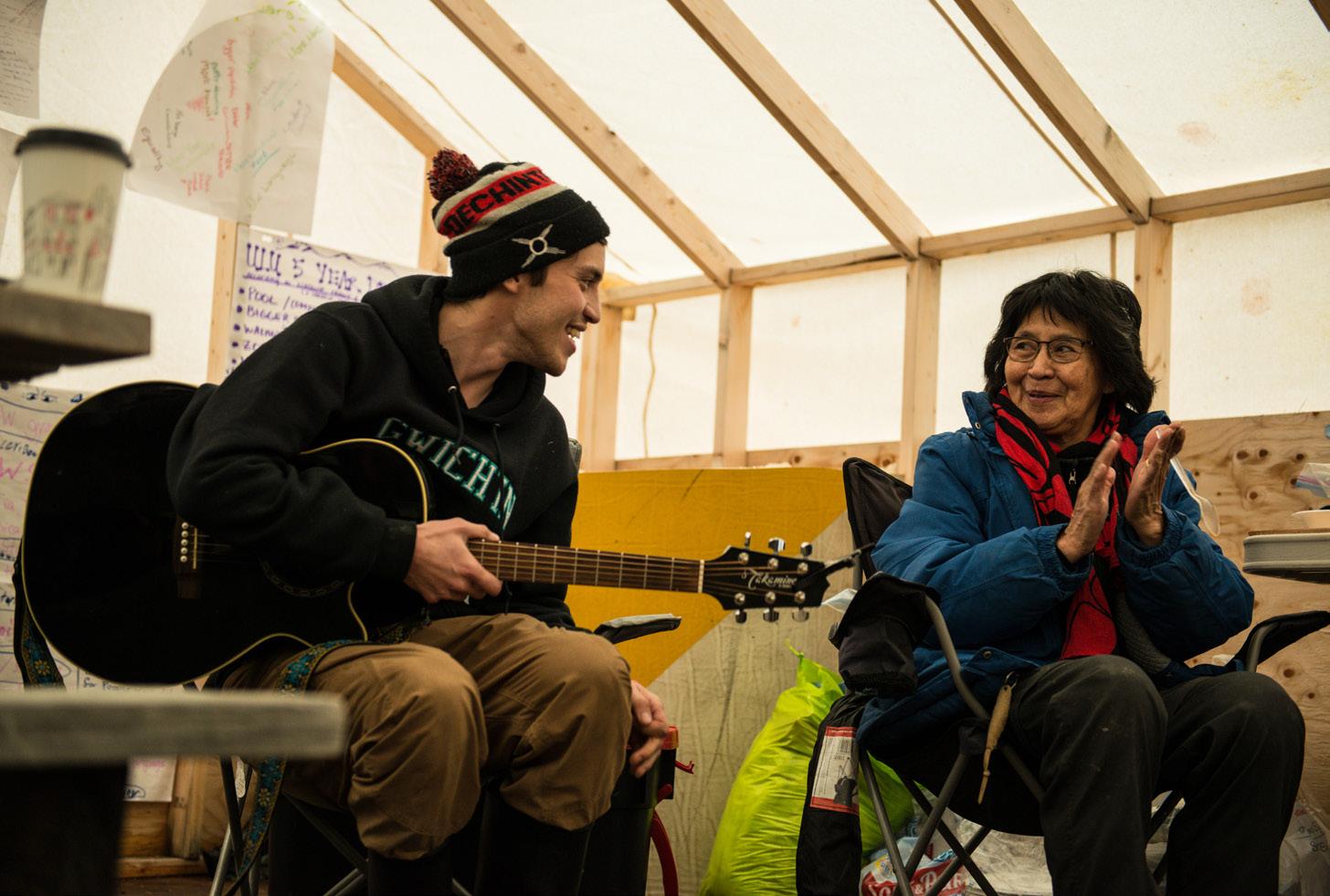
 (RIGHT) Peter Greenland entertains Elder Sarah Jerome at the Youth Leadership Retreat, October 2018. Photo: Shayla Snowshoe.
(BOTTOM RIGHT) Elaine Elanik plays with Dani-Mae while she picks berries, at the Midway Youth Gathering, August 2019. Photo: Shayla Snowshoe.
(DIRECTLY BELOW) Karissa Kimiksana and Natasha Ross enjoy the hike and views at the Project Jewel campsite, Gwich'in Territorial Park, at the Youth Culture Camp, October 2019.
Photo: Shayla Snowshoe.
(BOTTOM LEFT) Stringer Kasook listens to wise words and advice from Elders and previous leadership, at the Midway Youth Gathering, August 2019. Photo: Shayla Snowshoe.
(RIGHT) Peter Greenland entertains Elder Sarah Jerome at the Youth Leadership Retreat, October 2018. Photo: Shayla Snowshoe.
(BOTTOM RIGHT) Elaine Elanik plays with Dani-Mae while she picks berries, at the Midway Youth Gathering, August 2019. Photo: Shayla Snowshoe.
(DIRECTLY BELOW) Karissa Kimiksana and Natasha Ross enjoy the hike and views at the Project Jewel campsite, Gwich'in Territorial Park, at the Youth Culture Camp, October 2019.
Photo: Shayla Snowshoe.
(BOTTOM LEFT) Stringer Kasook listens to wise words and advice from Elders and previous leadership, at the Midway Youth Gathering, August 2019. Photo: Shayla Snowshoe.
ANONYMOUS TESTIMONIALS
UNBEKNOWNST TO ME THAT I WOULD BE STAYING UP HERE THIS LONG—here amidst the rolling hills and scarcely placed trees—I have been at Teenjur Van (Midway) for two weeks and now for another week. I do believe it is amazing that youth are now taking it upon themselves to learn and grow in their traditional cultural practices. You, my cousins to the North, and we to the South, have called this place home for thousands of years, for it is out here that we truly feel connected to our people. I do hope that as we begin to return, regain our identities, and immerse in our culture, we will also regain our language, for they are one and the same. Should one fall, we will then lose a vital part of our identities as Gwich’in, and as Inuvialuit. I did not expect to be here at Teenjur Van this long, but the thought of going back to Teetl’it Zheh (Fort McPherson) is now a distant thought.
MY NAME IS JEANNIE GRUBEN; I LIVE IN TUKTOYAKTUK, NT. I work with the Regional Youth Advisory Group (RYAG), and my initiatives are mostly On the Land programs to get the youth and Elders together to learn our traditions and language. This is very important for their mental health, physical health, and well-being. Unfortunately, we as youth face a lack of motivation and lack of activities. However, I have been a part of a few On The Land programs and small workshops—they have helped me understand how to fnd myself and who I wanted to be. I want the youth in the region to feel seen and heard, because they have so much respect and are great listeners. Being in multiple youth groups, I want to help my community and others who need my support.

“I felt rejuvenated. I needed this experience to keep me going. I rarely sleep or rest when I am home in my community or when I represent my community. It is exhausting work, but I do it because I love my people, culture, and land. I have never slept so good, laughed so hard, ate so much, and drank so much good tea in a long time.”
“It is hard to reconnect with my cultural identity. I don’t know where to start. I feel overwhelmed. I feel like I am alone when others around me just want to continue living and accepting what we see in our communities. I see the cycle of drinking, taking drugs, abusing one another, violence, and poverty—when does it end? I want to change but I need help. This weekend inspired me. It gave me hope. I know I am not alone in this.”

“I was in the middle of nowhere and it was the place to be. I loved the people, the fresh air, the mountains, the fre crackling, and laughing constantly. I lef my berries, so you must do this again and invite me.”
“I made lifelong friendships here with everyone from a baby to an Elder. I am forever grateful that I was welcomed with open arms and hearts to be on the land and in this territory.”
“I love the opportunities that our council provides us, but we need more support to achieve our objectives. This camp gave me a boost of energy and motivation to stay on track and committed to representing my community on the council. Please do this more for us as it’s challenging work and we face many criticisms. This experience really helped me connect more with my council and other youth interested in what we do.”
“I feel like I found a circle of youth that I can relate to in ways I didn’t understand until we were there together. It is challenging to think positively in my community, as there is so much toxicity or anger. I believe us coming together shows the potential in young people and what leadership can really mean in our communities.”
“I loved the exchange of folks from the North and across the country. It was a truly inspiring and rich experience that I will cherish. I think more individuals need to come and experience the North like I did. I will forever be grateful for being invited, accepted, and loved in this space created by these youth.”
“I just spent a week at Midway Lake for two youth events. It was an amazing time and I am so grateful for the opportunities I am given to live my passions and share that with others. You know it was a good time when nobody wanted to leave. A lot happened in our home communities this week and we felt the heaviness for our friends and families, but being on the land to grieve and release what we needed to truly made a diference. We laid tobacco and shared prayers for those impacted by the losses, and I will continue thinking of them. My heart is heavy but full at the same time. So much stories, much-needed cries and laughs, and amazing food. Mahsi for this good life.”
ARLYN CHARLIE
45
JEANNIE GRUBEN
 A spectacular berry-picking afernoon, close to the Yukon border, during the Midway Youth Gathering, in August 2019.
Photo: Shayla Snowshoe.
A spectacular berry-picking afernoon, close to the Yukon border, during the Midway Youth Gathering, in August 2019.
Photo: Shayla Snowshoe.
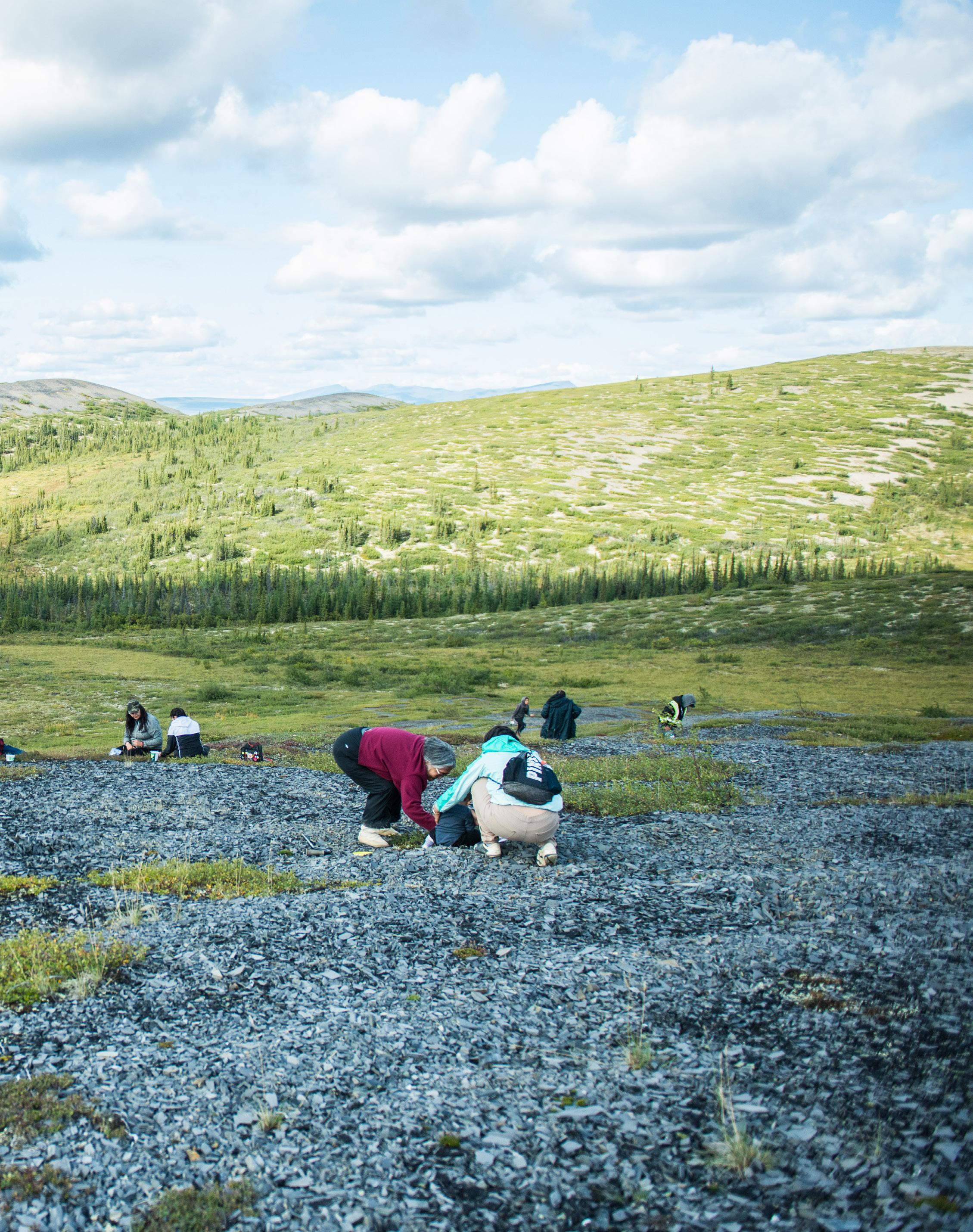
As a young Gwich’in woman who has recently moved back to her ancestral home, I have been overwhelmed, quite literally, with how amazing it feels to be out on the land. When we share space and create space on the land with babies, youth, and Elders, our spirits thank us. When we take the time to learn alongside our teachers and mentors on the land, and when we ourselves are upheld in the roles of teacher and mentor, a beautiful cyclical way of living and loving in this world becomes apparent.
As someone who has been actively working alongside youth within personal, community, global, academic, political, sustainable, inclusivity, and empowerment spaces for over a decade, I am beyond excited and honoured to be involved in forming the new Western Arctic Youth Collective (WAYC) that will serve Inuvialuit and Gwich’in youth directly within our own region. No longer will we be looking outside of ourselves and our region, but rather relying and building upon the strengths, passions, and pure talent Western Arctic youth possess.
I feel like I never get the chance to share such a big sentiment—but truly, the youth and community I am honoured to work with inspire me daily and push me to do better in my work and personal life. Looking back at all the youth I have worked with over the last decade, all while being a youth myself, I now see many of these people engaged in: post-secondary education, training and certifcation programs, traveling and living internationally, working within all sectors and felds, leading our peoples governance and land stewardship, starting and building strong families, and generally living full, healthy, and happy lives.
Watching youth demonstrate so much lateral love and kindness, strength, and vulnerability when participating in the on-the-land camps has been incredibly worthwhile and emotional. To hear their struggles, but to watch them fourish, feel connected to one another, their camp tasks and to the land, has been what all this work is about—this work is about and for the youth. It also happens to be work that feeds my own soul and spirit.
Haii cho for letting me share some of my personal thoughts on youth empowerment and determination. We are so proud of the steps taken to get us here and are looking forward to the next exciting steps as we work through strategic planning, creation of a Steering Committee, and the building and nurturing of strong community partners and relationships.
I also could not end this without honouring my late jijuu, Annie Norbert. She truly was a strong, talented and funny Gwich’in woman who forever connects me to my ancestry, teachings, and the land, who gave my art practice breath and life.
The Western Arctic Youth Collective (WAYC) will create and ofer programming decided by a youth steering committee and community consultations annually. WAYC is currently recruiting interest for steering committee membership and will begin networking and forming partnerships regionally, territorially, and nationally, with similar organizations. The deadline is August 31st, 2020. To reach WAYC, you can send an email to waycdirector@gmail.com or follow WAYC on Instagram @waycwayc
— NIGIT'STIL NORBERT
48
When we share space and create space on the land with babies, youth, and Elders, our spirits thank us. When we take the time to learn alongside our teachers and mentors on the land, and when we ourselves are upheld in the roles of teacher and mentor, a beautiful cyclical way of living and loving in this world becomes apparent.
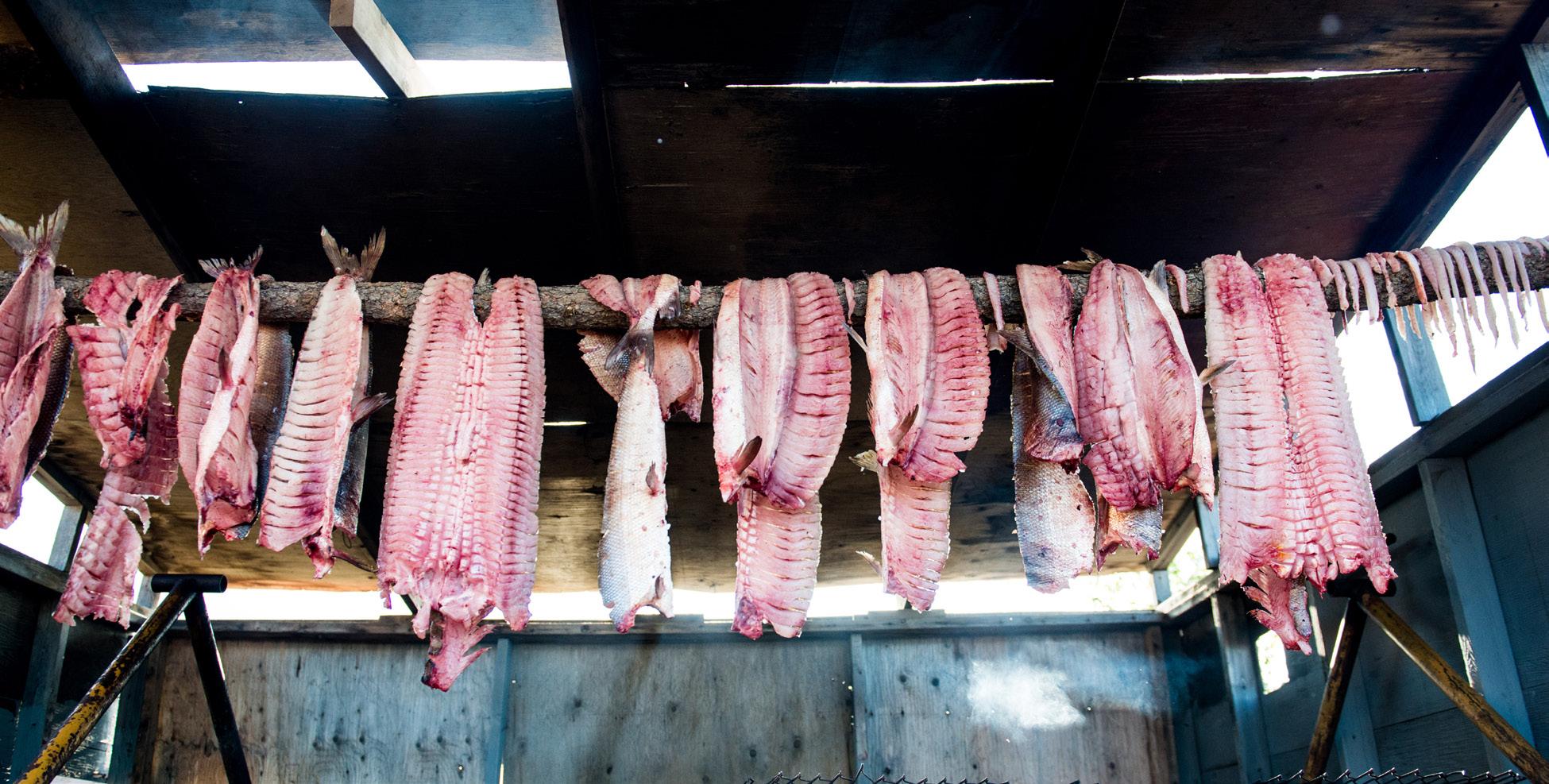
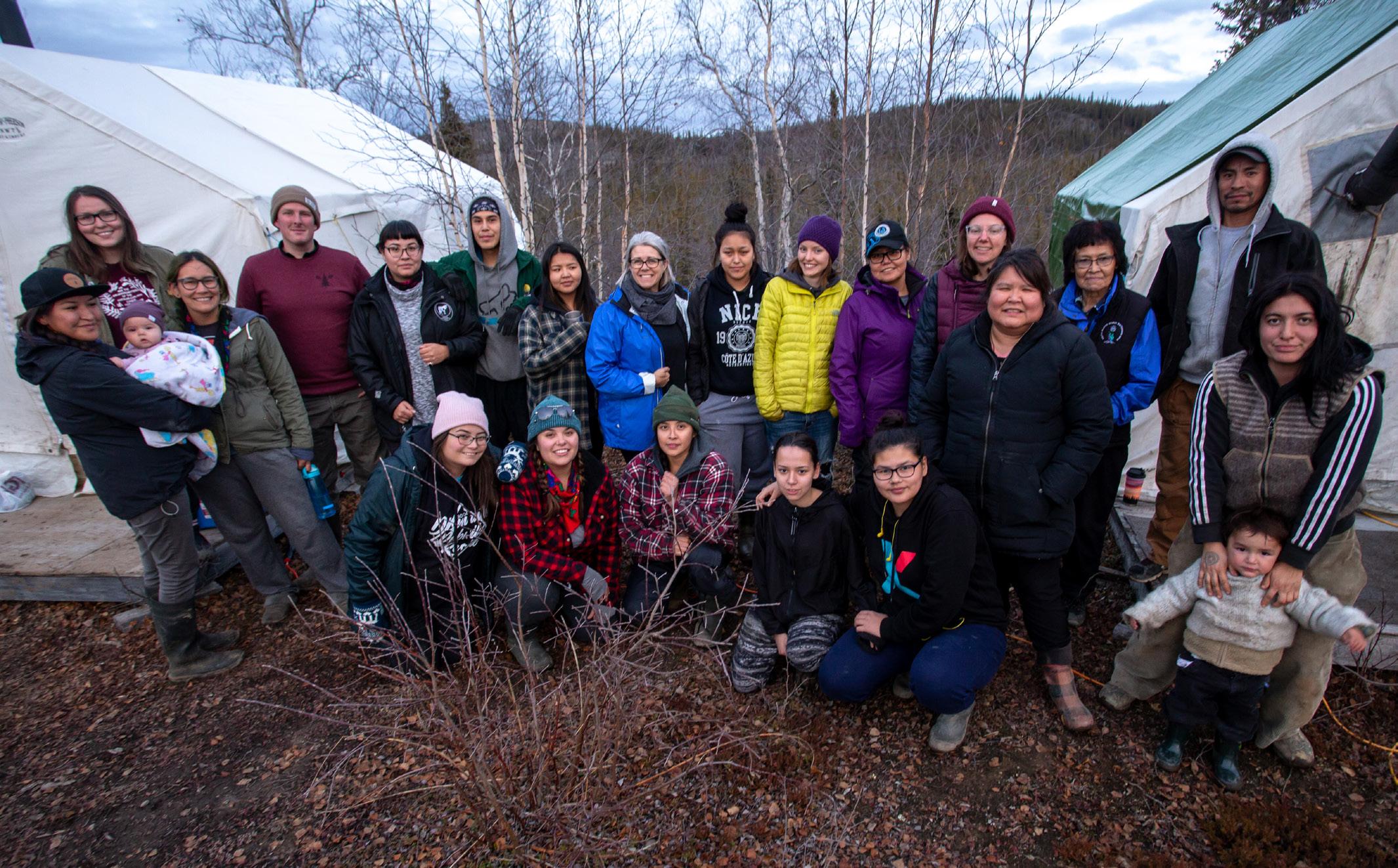 (BELOW) Smoking dry-fsh. Youth caught and prepared the fsh, guided by teachings from Elders Alice & Ernest Vittrekwa. Midway Youth Gathering, August 2019. Photo: Shayla Snowshoe.
(BELOW) Smoking dry-fsh. Youth caught and prepared the fsh, guided by teachings from Elders Alice & Ernest Vittrekwa. Midway Youth Gathering, August 2019. Photo: Shayla Snowshoe.
49
(ABOVE) Participants from the Youth Culture Camp, at the Project Jewel site, Gwich'in Territorial Campgrounds, October 2019. Photo: Ben Powless.
RECALLING MABEL
WORDS BY JAMES LUMSDEN
Those first memories that I had with her seemed to have just always been there. Te yellow Sony cassette player and recorder which never seemed to break. We would record conversations on blank tapes that we would constantly play over and over again. Mabel would also take photographs, lots of photographs. She couldn’t keep up with how many flashbulbs she would actually go through with the small Kodak camera that she purchased from Direct Film. I still remember their logo; a Day-Glo style orange and red bird’s head, two-dimensional, looking upwards to the right. She would develop the film into both photos and slides, and we had a mini slide viewer powered by one single small light bulb and two double-A batteries. Tankfully, I still have the viewer, the slides, along with a boxful of old pictures. Whenever we went out to see a movie or go to the circus, we made scrapbooks out of construction paper, stapled together page-by-page into large handbooks. We would find newspaper clippings of whichever show we had most recently seen and add them to each new scrapbook with scotch tape which would both brown with age, filling pages in between with arts and crafts cut from felt and pasted together with Elmer glue. Everything we did together at that age—for both of us I realize now—really felt magnified. Not just captured and documented—but fleshed out. As if every single memory could be brought back to life. In fact, for me it was. To this day, I still keep every memento and souvenir that I can from outings that I go to. And I guess this is why.
50
Dedicated to the loving memory of Randal "Boogie" Pokiak (1949–2020).

In a word, this is how to describe Mabel Nagooyoak Pokiak Lumsden: colourful. To say nothing about vibrant. She was that too.
Life and memory with her as I knew it started for me in that one-bedroom apartment in Ottawa, two years after I was born in 1975. It has taken me my lifetime to understand that Mabel’s life actually began in the early spring of March 7, 1941 on Banks Island, Northwest Territories, where she was born and raised on the land out of our home community, the Hamlet of Tuktoyaktuk.
I wish I could go on about her life before attending residential school.
Life on the land, surrounded by large family. Speaking the language. Learning how to prepare country food. Mabel did try to pass the language on to me from a very young age, but it never stuck. Really, I’ve never been the type that could sit down and study for very long—and yes, the south is the south. When in Rome. Mabel settled in Ottawa with family in the late 1960’s after graduating from nursing school in Winnipeg. Looking back, she did manage to show me how to track as if we were still on the land in this concrete jungle.
I was 8. Te year was 1983. I couldn’t get enough of seeing Return of Te Jedi at old Somerset Teatre. I’m pretty sure Mom understood this and had to have used this to her advantage to help convey her somewhat

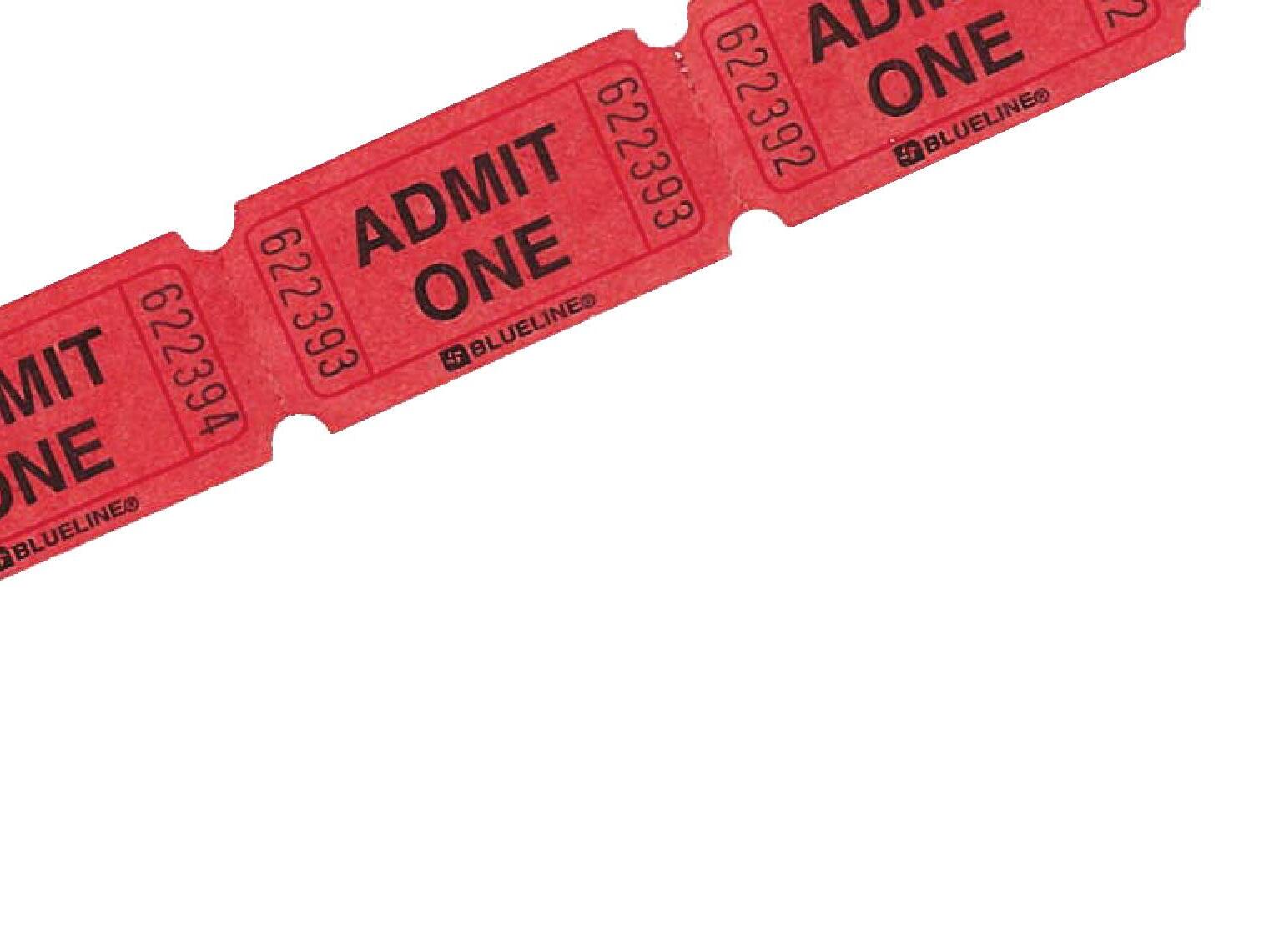
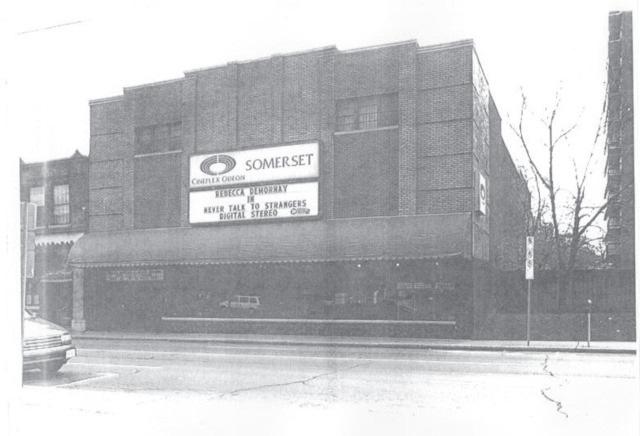
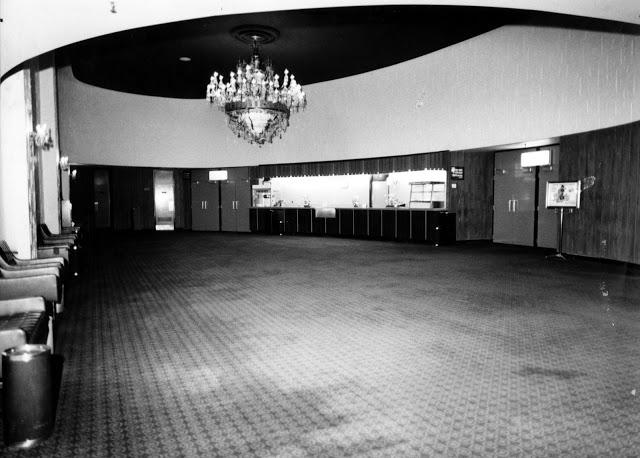

special spiritual beliefs on me. I was a Star Wars nut. But eventually, she probably got so tired of me asking her to drag me to the theatre throughout that summer that she ended up letting me catch the bus on my own to see the show—one bus trip there and back. Route number 2. Keep in mind—this is not something that you do with an 8-year old in this day and age. But, back then, what she did was give me enough change to catch the bus and back, enough for the movie fare, and enough for a popcorn and a pop—along with a spare quarter in case I got lost.
“I’m showing you how to find your way there and back,” Mabel explained, “You know the bus stop to get there. Remember where you get of, the bus stop to get home is always
52
right across the street from where you got of. And dooooon’t stop for or talk to strangers. Call me by payphone if you get lost. And if you lose the quarter, dial ‘0’ for the operator and make a collect call home.” 745-4848 was our number, so I was of. Tat summer I must have made that trek at least five times and exaggerated that number up to ten with time. Mom never minded exaggerated numbers; it was just how one communicated with others at the time. So, ten.
I’ll never forget the last trip I took to Somerset Teatre that late summer. I arrived for the 4 PM show. Te film had been in the theatres for a good and long run. Tere I was alone, 8 years old, the only person in line. And I stood in line thinking the show would still be screened. Te


ushers had to console me through my hard sobs that there were not enough people in line to show the movie. I was devastated, of course. On the bus ride home, I cried the entire way and went running to Mom to let her know what had happened. It felt like I would never be able to see that movie ever again.
I was expecting mom to berate me for being so sad and selfish. I’ve never been one to take bad news very well. She really didn’t have much and I was always busy asking her to get me things she really couldn’t aford. But instead, when I arrived home and told her what had happened, she said: “James. If you give me the money back for the movie instead of trying to keep it, we’ll go and see the movie together tonight at 7 PM.”

“But the movie is gone now, Mom! It will never be shown again…”
“It will be after supper for people. Tey’ll show the movie one more time, James.”
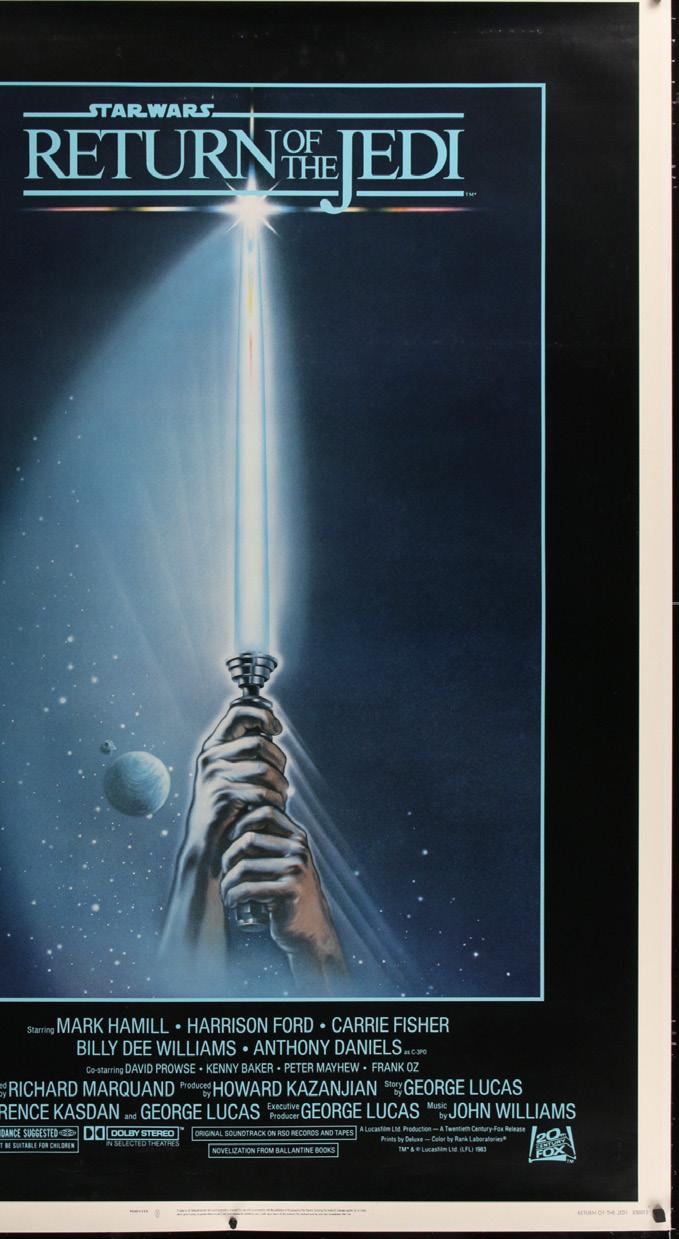
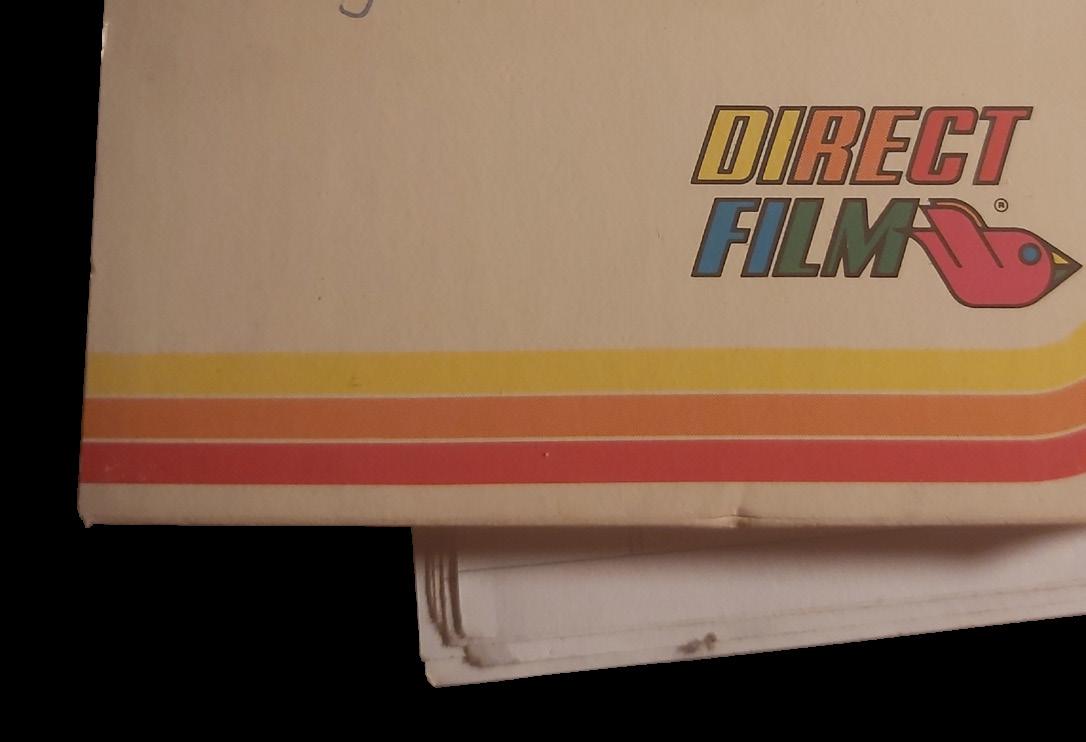
And even though I didn’t believe it until we got back to Somerset Teatre, sure enough it was. And honestly, the same ushers that had consoled me just three hours before were happy to see me back with her. At eight years old, I felt complete. I saw too that mom was right. Tat was the last screening of the movie in the city that evening. It was a Sunday.
Just like life on the land, in simple respects. One has to be patient. Timing is everything. And don’t be afraid to turn a whale hunt into a caribou harvest when there are no whales to be harpooned.

53
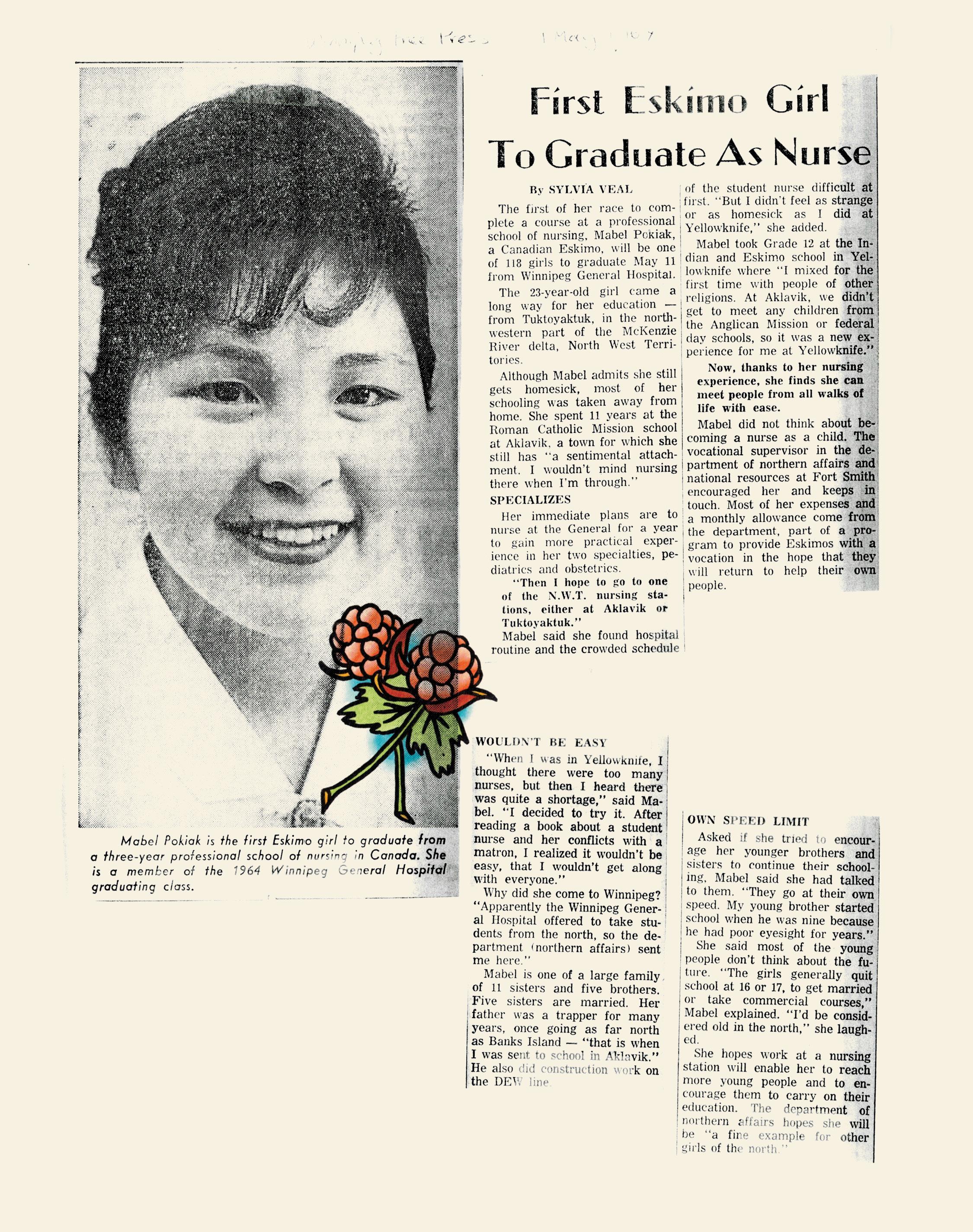
T
ere are many other memories I have of Mabel, and it’s not all perfect, of course. Nothing in life really is. She had hard health problems including a serious thyroid condition which hindered her physically, mentally, emotionally, and professionally, along with a family of her own to love and maintain through being a single parent with myself. A family who loved her back and today feels afected by her absence. She was indeed deeply afected by the 13 years she spent inside the residential school system. Mabel attended Immaculate Conception in Aklavik between 1947 to 1958, and from 1958 to 1960 she was in residence in Yellowknife at Akaitcho Hall and attended Sir John Franklin/Indian and Eskimo School. Sadly, Mabel passed away of heart failure as a result of Type-2 diabetes on August 6, 2012. Here, speaking from my heart, she had to raise a kid in me that always found a way to make life that much more difcult, right up to 37 years of age. I was a handful and a half and didn’t quite know it at the time.
But the great memories, those of getting me into house league hockey to keep me active, the heart conversations we’d always have, finally playing softball together which she thoroughly loved and endured despite my bad managerial decisions (of which there were plenty), her taking care of a child in me growing up with asthma…those outweigh everything else. Everything. Seeing Mabel attend courses regularly at Algonquin College from the early 70s going forward and finally receiving her degree in Legal Secretarial with honours in 1987 when she was 46 was very inspiring, to say the least. It is especially inspiring for me, at 45 years of age today, with my own General Arts degree at uOttawa to complete.
Finding out there was information at her old alma mater of Winnipeg General Hospital’s School of Nursing (WGHSN) gave me a glimpse
of the young woman she was, and the aspirations she held with becoming the first Inuit Registered Nurse (RN) in Canada. Tese particular graduation photos and quotes from 1964 showcased a vibrant young Inuvialuk woman. Te world in front of her, she brimmed with life at the time. She had the intent then to bring her studies back home with her, I learned from one of her newspaper interview quotes. Finally seeing Mom in this light was a very huge eye-opener. In the end, Mabel adapted to life down south, and really did so to the best of her ability.
Mabel really was such a smart person. And sympathetic. She could always adjust to her surroundings and let herself be an active participant in wherever her feet would take her. She actually walked quite a bit to get to wherever she had to go. Which leads things back to what this accomplishment means, in that grander scheme of things. Te thing that the world of work has taught me about the gut instinct and the big picture.
Trough various media sources, the accomplishment of graduation into the nursing profession by Indigenous women has been well-documented at this point. Edith Anderson Monture, Mohawk, RN, 1914. Jean Cuthand Goodwill, Cree, RN, 1954. Ann Tomas Callaghan, Cree, RN, 1958. Janet Spence Fontaine, Cree, BSc in Nursing, 1965.
55
Tese particular graduation photos and quotes from 1964 showcased a vibrant young Inuvialuk woman. Te world in front of her, she brimmed with life at the time.
. Mabel Lumsden is pictured with the Winnipeg General Hospital School of Nursing's (WGHSN) Graduating Class of 1964—in the fourth row, third from the lef

1 IN 118

If we can put a hold on the term ‘first’ here at this point, that leaves only more room for truly notable accomplishments in the field of nursing and the health care field. It was the 1960s, a period of real change. For all communities. For the Indigenous community. For the Inuit community.
Mabel Nagooyoak Pokiak Lumsden. Inuvialuk. RN, 1964.
At this point, I’m only able to put into context what this meant at the time. I won’t go on a pedestal and point out that systematic racism, the old notion of manifest destiny, and the core concept of colonialism, all still exist. Tey most certainly existed in 1964. It was the high point of the residential school era, which really was terrible and incomprehensible enough. Stereotype, stigma, bias—these were what every one of us who entered from this truly inhumane system into the workforce had to endure. Ask any of the above who are still here to tell their story, or their relatives for those that have passed on, and I’m sure they will tell you. All were strongwilled and strong-minded individuals who must have known what they were all trying to accomplish. Look them up. Teir stories are all there to be told now.
Seeing Mabel’s final transcript from WGHSN made me take a step back in a moment of awe I have rarely ever experienced. Making the simple Google search in 2018 to find her original
Winnipeg Free Press article from May 1, 1964 at the Ottawa Public Library from an innocuous American website actually made me feel the same way as I did seeing Return of Te Jedi in the theatre 35 years earlier. Seeing the article also helped me ask questions. Who was this person, a mere 11 years before I was born? And why did she become a nurse? Mabel was an astute student who would have had a choice in whichever field of study she wished to pursue—and doors were beginning to open. Gender bias aside—and it was very prevalent within the field at the time—how come nursing?
In 1958, the hamlet of New Aklavik, which served for five years as the new administrative centre for the region, was renamed Inuvik. In 1960, Mabel graduated from Sir John Franklin/ Indian and Eskimo School in Yellowknife, and it was this same year when Inuvik General Hospital opened. It would have required new staf immediately—staf that were already in touch with the needs of the region. Trough encouragement and funding by the Department of Northern Affairs and Natural Resources in Fort Smith, Mabel enrolled in 1960 into the Winnipeg General Hospital School of Nursing (WGHSN). After three years of training and a small leave of absence, Mabel was among the 118 members of WGHSN’s graduating class of 1964. Here her timeline of hospitals she worked at remains clear, choosing to stay at Winnipeg GN for an additional one year to gain further practical experience in her specialties of Pediatrics and Obstetrics. She then went on to work at Inuvik General Hospital as well as diferent cited and uncited locations including Tuktoyaktuk and Ottawa.
Today, in 2020, the numbers could very well bring this to light. According to the Canadian Indigenous Nurses Association (CINA), in a recent census titled “Aboriginal Nursing in Canada (Professional Occupations in Nursing,
58
Seeing Mabel’s final transcript from WGHSN made me take a step back in a moment of awe I have rarely ever experienced.
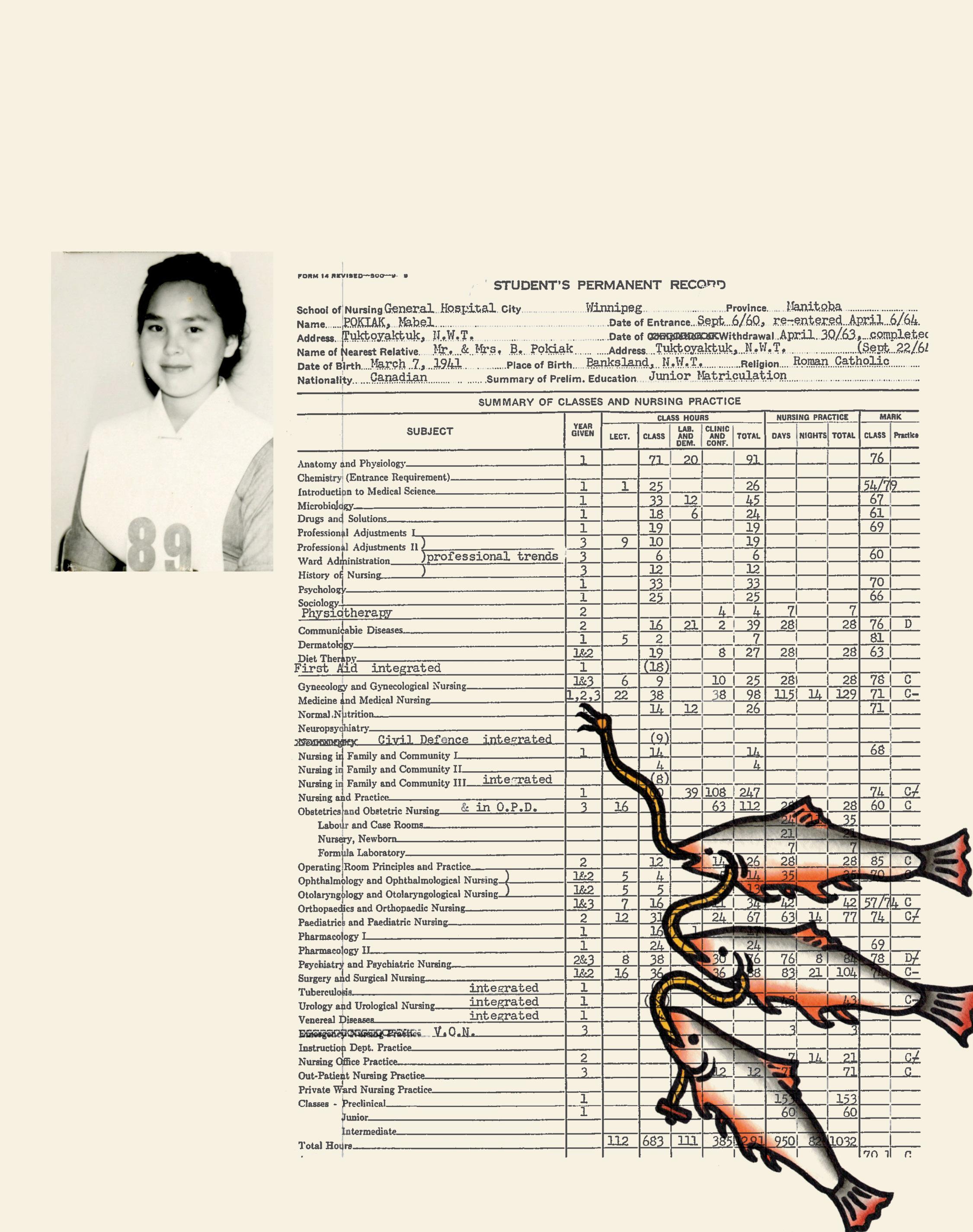
NOC 2016-301)”, there were 125 Inuit Registered Nurses in Canada as of 2016. It was also reported by CBC North on August 8, 2018 that Inuvik Regional Hospital went from a contingent of 1 full-time resident doctor to 11 within a span of 6 years. Tis was considered a milestone for health care in the area. While this was a significant development, CINA continues to address this as an issue, citing the 2015 Truth and Reconciliation Commission of Canada’s Call to Action #23—calling for an increase in the number of Aboriginal professionals working in the health care field. According to the CBC article, there are still stafng challenges that the Beaufort Delta Region has to face. Most notably, this includes vacancies for nursing positions as a result of factors such as burnout, which is the primary consequence of being understafed with permanent resident nurses to begin with.
It has been 56 years since Mabel Nagooyoak Pokiak Lumsden helped begin the process of bringing resident health care to the North by finishing her nursing diploma in 1964 and working north shortly thereafter. Today, COVID-19 has become the global issue which has
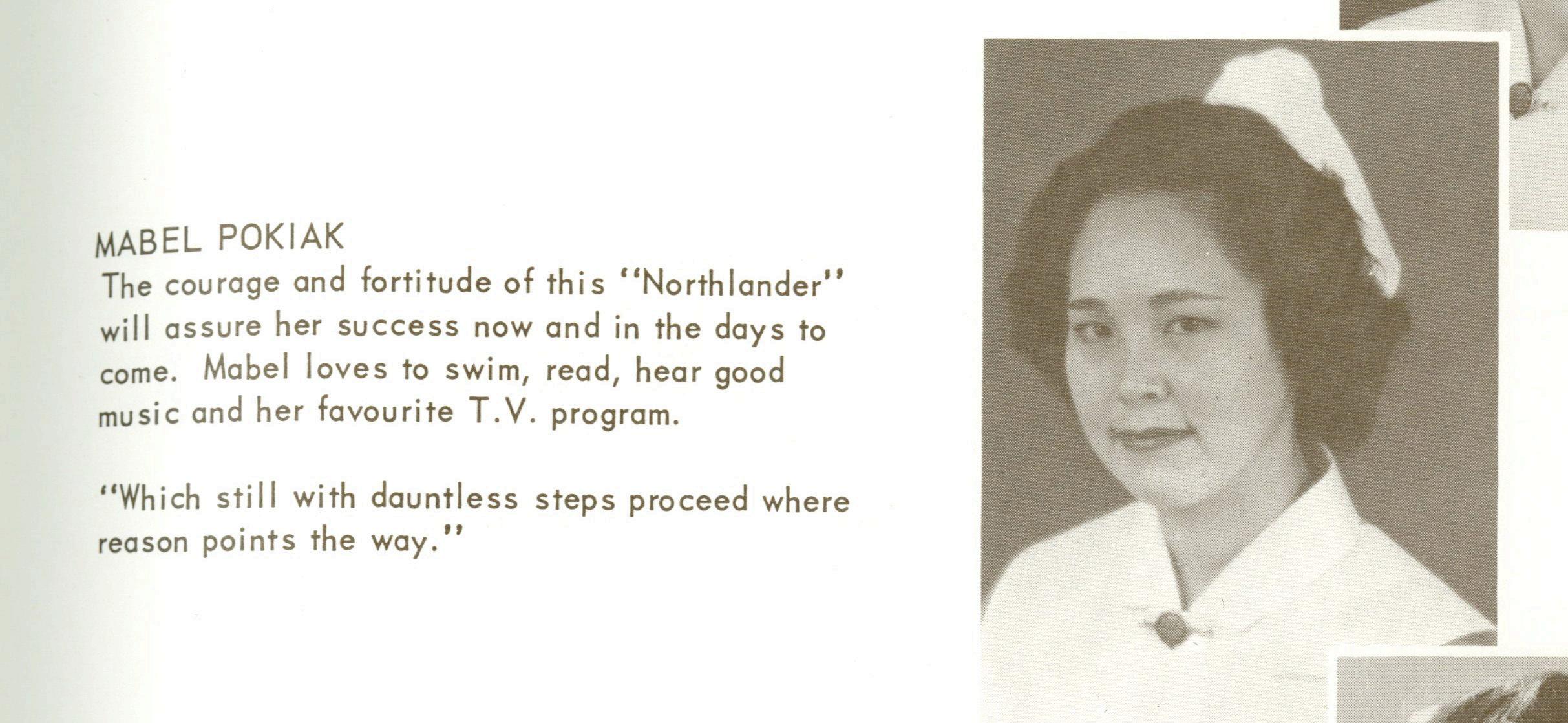
highlighted the essential needs of Indigenous and remote communities such as the Beaufort Delta Region, along with the needs of other areas in Canada, North America, and around the world. Many of these areas have been afected very adversely by the pandemic; Navajo Nation in the Southwestern United States is an unfortunate prime example of this extreme type of adversity. Here, things cannot be taken lightly and must be noted for the type of infrastructure which an Indigenous and remote community requires for primary health care. Mabel’s early accomplishment was the beginning of highlighting what the core needs of a community are and how they can be reached. It also showed what is possible to meet a community’s essential needs. Mabel Nagooyoak Pokiak Lumsden was an all-around pioneer—the very first Inuvialuk Registered Nurse in Canada. Tis mark can always be looked to with the most genuine of pride through the lens of history, and it cannot end here. It’s time to find out more about the trail of hospitals which she worked at.
Always a student.
Tis is how I will always recall Mabel.
60
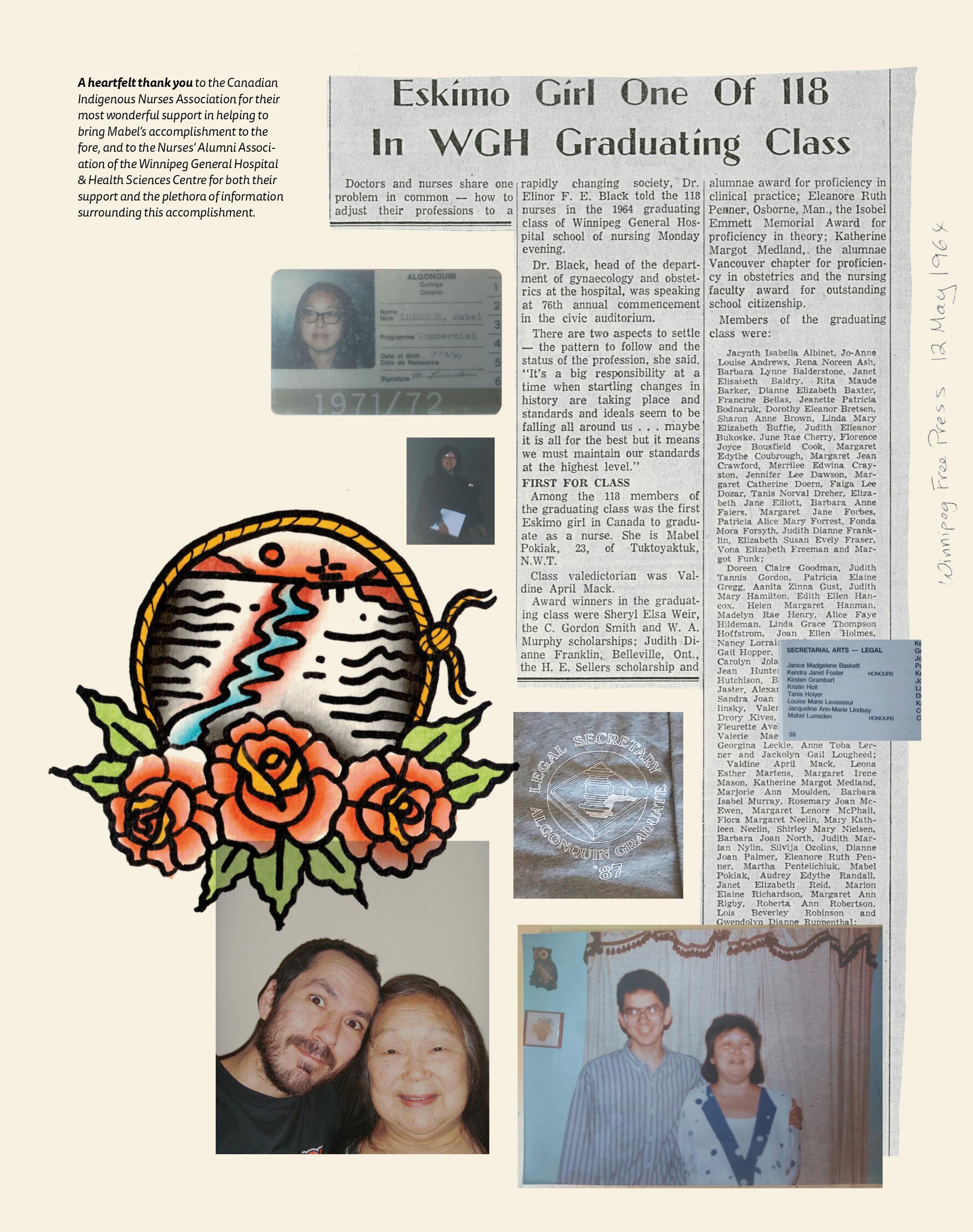
STORIES FROM THE FRONTLINES
Meet the Inuvialuit serving the Health & Wellness sector and dedicated to the selfess profession of healing others—way before the era of COVID-19
Dr. Noah Carpenter, originally from Ikaahuk (Sachs Harbour), is the son of Adjgaliaq (Fred Carpenter), who was the great Leader of Inuvialuit. Noah went to school at Akłarvik (Aklavik) and Iñuuvik (Inuvik), graduating grade 12. He then went to University [down] south and kept taking specialized education in the provinces.
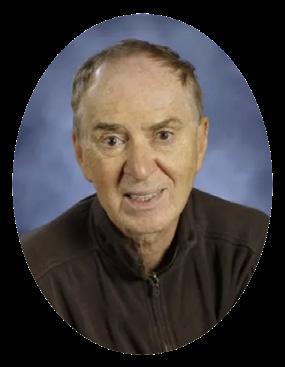
Noah became [the] frst Inuit doctor—and one of the top doctors in Canada. He is a [General Surgeon] with a very successful specialization [in Thoracic and Vascular Speciality]. Even while in big operation, while cutting bones, Noah never give up his nomadic Inuvialuk interest by listening to songs, as Sallirmiut.
Noah was an excellent example for many of our Inuvialuit and Inuinnait, [proving that one] can be successful as well in the education system of our time—both in the ‘new world’ society and with the Traditional Knowledge of our nomadic Inuit [culture].
Quana,
63
—R.K. Maharaaluk (Robert Kuptana)
 PHOTO BY MYRNA POKIAK
PHOTO BY MYRNA POKIAK
AMBER-JOY GRUBEN
I once cared for an Inuk man who did not speak any English— only Inuktitut. I know a few basic words in Inuvialuktun. I went in and introduced myself as Amber-Joy Dalgomik (my Inuvialuktun name) from Tuktoyaktuk. I pointed to myself and said, "Inuvialuk." So every time I went into his room, he would smile, point to himself and say "Inuk", then point to me, "Inuvialuk," and say something to his daughter in Inuktitut. She then said to me, “He's never going to forget you now.” It was a happy moment and I knew they liked me as their nurse when we built that rapport.
It gives me a sense of honour to care for the Indigenous population across the North, working here at Stanton Territorial Hospital. Although I do wish I were working at home in Inuvik, I am grateful for the experience I am getting here, and I still get to serve my people.
Making my Indigenous patients feel comfortable can be as easy as saying Quyanainni or Mahsi Cho! As soon as I say that, they usually look at me and ask, "Where are you from?" Then we get to talk about where we are from and what is happening during this time in our hometowns (e.g.
hunting season or carnival season). Some Indigenous patients I have cared for have said they are proud of me and they are so happy to have a local Indigenous person caring for them. That always makes me feel good and I know I am doing what I was meant to do in life.
I also have a great nursing team here on the Medicine Unit at Stanton Territorial Hospital. I completed my 2nd, 3rd, and 4th year clinical practicums here, and loved it so much that I applied to work full-time! We are the biggest unit in the hospital, being able to hold 24 patients. On a
65
Some Indigenous patients I have cared for have said they are proud of me and they are so happy to have a local Indigenous person caring for them. That always makes me feel good and I know I am doing what I was meant to do in life.
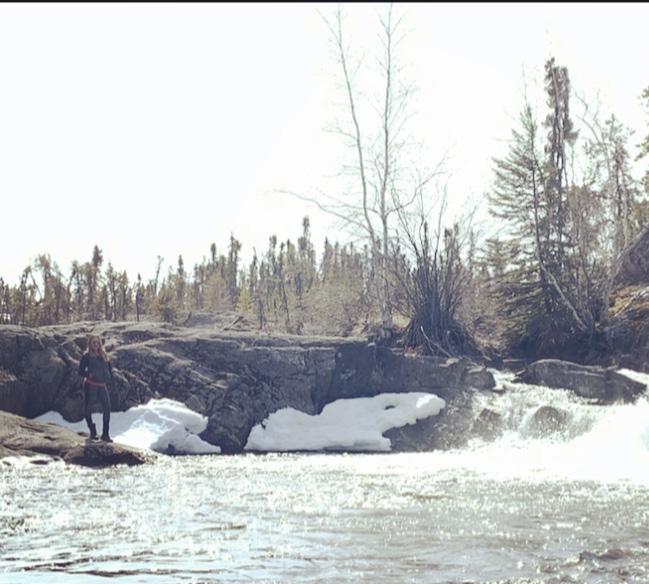
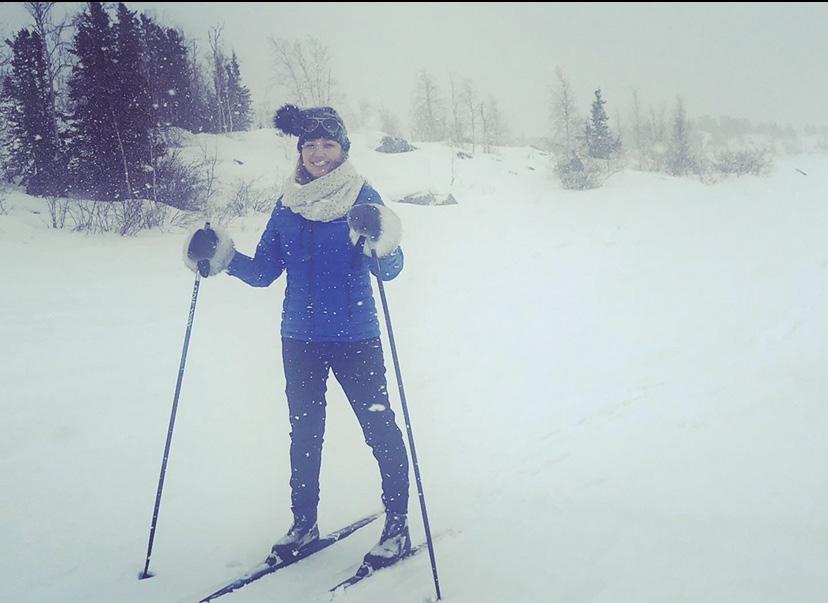


66
day shif I can care for up to 4-5 patients. On a night shif, it could be up to 7 patients. That being said, time management and prioritization are important skills to hold in order to care for your patients safely and efectively. If I need help with a task, my colleagues are more than willing to help, and there are no stupid questions. I am able to work in a supportive environment while simultaneously gaining solid nursing experience in the Acute Care setting.
It is defnitely a hard place to work with lots of challenges, but that is exactly what I like about it. I enjoy being busy on my feet. This is where work-life balance comes into play. When I pick up overtime shifs, it is important to listen to my body and know when I can mentally and physically work surpassing my scheduled shifs. If I fnd my body and mind to be "burnt out", I need to listen to it because if I do not take a break for myself to recharge, then I cannot efectively care for my patients. I learned that quickly, and I have had to say no to overtime shifs because I knew I needed a break to recharge—which is the safest thing to do for myself and my patients.
KEEPING WELL DURING COVID-19
During this pandemic, I have been making an efort to get outdoors more since I was no longer allowed to go to the gym. For example, I’ve been going on hikes along the Ingraham Trail here in Yellowknife. Along with this, when we still had snow and ice, I developed a hobby for cross-country skiing. I enjoyed it so much that I have decided to buy my own skis this winter, so I can continue to go when the season starts up again. Now that it is summer, I have bought a kayak and will go kayaking when all the ice is melted. Now that we are following the Northwest Territories’ plan to ‘Emerge Wisely’, I am hoping that baseball will start up soon. Mostly, I look forward to seeing friends, fnally!

During the quarantine, I felt that it was good for my mental health to get out of my apartment and go out to do some physical activity with my co-worker (obviously 6 feet apart). It was defnitely needed. If one positive thing came out of isolation, it is that I found new hobbies to keep my mind occupied. I found that I also Facetimed my friends and family a lot more; that helped with the loneliness since I live alone and that was hard considering I was not allowed to visit with friends and family!
I also picked up overtime shifs at work; socializing at work became important to me as it was really the only place where I got to see people. When I would get really down, I would pray about it and ask God for strength and remind myself it’s just a bad day—not a bad life. I am fortunate enough to have my health, and along with this, job security. Not only that, but my job is fulflling as I get to help people in their time in need; it’s funny to think as I was helping them, they were helping me, too. So, every time I was feeling really low, I would count my blessings and remind myself that this will pass and things cannot stay bad forever.
In closing, being healthy to me is getting enough sleep, eating healthy, drinking enough water, taking care of my mind as well as my physical health. It also means fnding hobbies that will keep you busy, while making an efort to socially distance when visiting with friends. Take the time to call your loved ones to tell them you love them; talk and check up on one another. Find that good work-life balance. Take care of yourself before caring for others. Make those connections with your patients, make them feel comfortable. Build trusting relationships with your colleagues—it makes for a good work environment. Things will get better; you just need to have faith.
@ AJDG 12
67
DANA FRANCEY
Afer that, I knew that I wanted to help others in a similar way. I’ve worked in diferent felds of social work, including medical social work, mental health and addictions, as well as child and family services.
My interest in mental health developed afer learning more about how mental health is impacted by historical trauma, such as residential schools. It took me years to see how the trauma I experienced impacted my own mental health and I felt that I could help others who faced similar challenges.
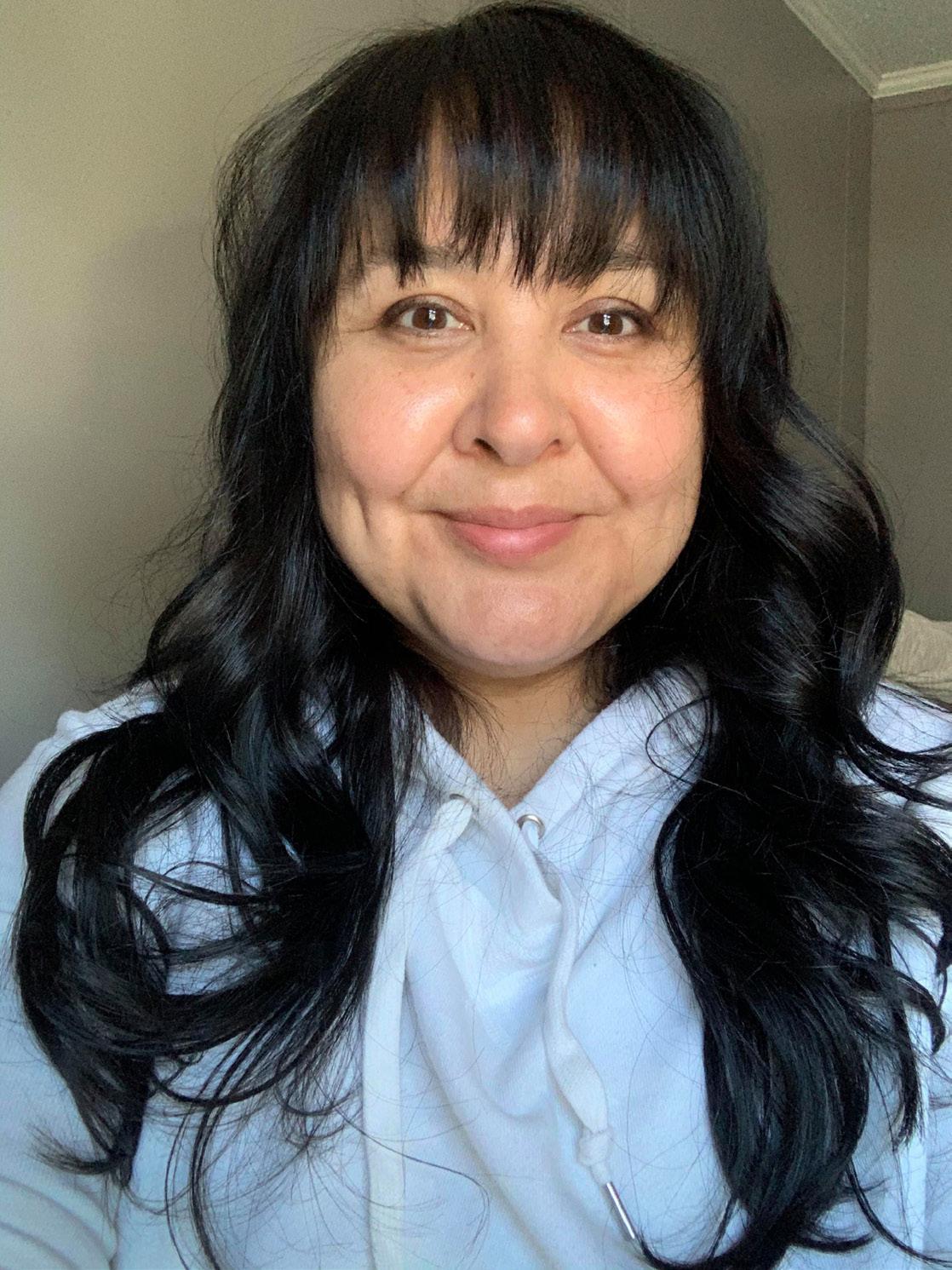
What was interesting for me was learning about how connection to culture and commu-
nity contributed to positive mental health and healing. Our Inuvialuit culture and traditions have kept our people strong. I believe we need to include culture in all programs for mental health.
To be a social worker in the NWT, you must have a diploma or degree. A diploma program is usually a 2-year program, and a degree is a 4-year program. To enter into a diploma or degree program, you must have good writing and reading comprehension skills. I struggled for years with my English classes and used to meet with my 2nd year English professor twice a week for extra help. It was a lot of work, but it helped me in all my other classes and my work.
68
My family has been impacted by intergenerational trauma and we experienced addictions, abuse, poverty, and mental health issues. I was helped by a social worker when I was a young teenager and it changed my life.
Most people think social work means working in child and family services, but a degree in social work can open so many doors in so many areas. Prior to COVID-19, I was working with the Indigenous Health and Community Wellness Division with the GNWT as a Senior Policy Advisor.
It is hard to pick one memorable moment, but one that stands out is when I was working as a medical social worker and I worked with an Inuit family. I was able to communicate and connect with this family in a way that the doctors and nurses could not. The family was more comfortable with me and opened up about issues that were impacting their health. I think, because I was a familiar face and understood the challenges of living in a small community, I was able to work with the family to fnd a support for their issues. As I was leaving the room, I heard the family say how nice it was to have an Inuk to talk to. This experience made me feel that I was making a difference in our communities—it felt really good.
COVID-19 RESPONSE
I was redeployed to Northwest Territories Health and Social Services Authority (NTHSSA) as part of the mental health response to COVID-19 in the Territories, and so when COVID-19 frst started, it was a little chaotic. It took me time to adjust to new policies and ways of working. I was able to manage by staying connected with my teams and being open about the challenges I was facing. I am lucky to be a part of two diferent divisions, with two amazing teams. I stay well with my work by setting up my own little workstation and being fexible to work and be with my family throughout the day. This means that sometimes I work late at night.
To stay well, I have worked hard at maintaining a routine for myself and my boys. I do better when they have a routine (bedtime, mealtimes, outside time), because they feel better when they know what to expect each day. Some days are a disaster and we sleep late, eat late, and so on, but I remind myself that it is not the end of the world. I try to be realistic and kind to myself so I can make mistakes. I also make it a point to spend time outside each day, even if it is only a few minutes. To stay connected with friends and family, I video chat and have done social distancing walks!
We wanted to come home to go on the land to stay safe, but couldn’t. It was so hard to stay home in the city because you don’t have any freedom like you do if you go on the land. We talked with family a lot and tried to keep busy with puzzles and reading. During the beginning of the pandemic I reread Taimani, specifcally about past pandemics and the rapid change in our region. Reading the stories of survival reminded me that our culture and people are so resilient and are able to adapt to anything.
Some days are easier than others and I have moments where I am not at my best, but I remind myself that it is only one moment in time. COVID-19 has changed our lives and it is okay to struggle as we learn to adapt to all of the changes.
MASTER OF SOCIAL WORK
I just completed my Master of Social Work, in Indigenous Trauma & Resiliency, through the University of Toronto. It is a blended on campus and online program that specializes on trauma informed practice and resiliency. What is unique about this program is that students are supported to embrace their culture in their learning and fnd ways to incorporate this into our professional practice.
It has been a lot of work and commitment to dedicate time away from my family to study and be on campus. The program challenges students to grow academically, professionally and personally. I could not have done this without the support from my partner and family.
DEFINING HEALTH AND WELLNESS
To me, health and wellness includes our emotional, spiritual, mental, and physical self. I think of health as being something we can take care of, and wellness as what we achieve when we maintain good health.
69
To me, health and wellness includes our emotional, spiritual, mental, and physical self. I think of health as being something we can take care of, and wellness as what we achieve when we maintain good health.
KAREN GRUBEN KINCER
My name is Karen Kincer nee Gruben. I am a registered nurse but am not currently practicing as a nurse, as I am currently selfemployed. I work with my husband making Native American crafs and dance clothes, here in the United States.


I am an Inuvialuk, born in Tuktoyaktuk, NT. My mom is Sarah McKay and my birth father is Vince Steen. My grandparents are Charlie and Persis Gruben and Paul and Elizabeth Steen. I was raised by my mom and my grandparents until I was 10 years old, when my mom married her husband. I was sent to attend school at the Anglican Hostel in Inuvik, and at the end of the school year, I was sent to Cambridge Bay, where my mom and her husband lived. During this time, I lived in Pine Point, Goose Bay, Louisburg, NS, Edmonton, and Yellowknife.
At the end of grade 11, I was sent back to Edmonton because there was a lot of alcohol, physical, and mental forms of abuse. Once I complet-
ed high school, I attempted to go into chemical technology at the Northern Alberta Institute of Technology but did not succeed due to my home life and intolerance to chemical odors. So, I moved to Yellowknife and worked as a temporary clerk for the government, before getting jobs in Inuvik as a secretary and court worker.
During this period, I became a single parent. However, no longer able to aford living in Inuvik as a single parent, I moved to Whitehorse, with my mom and her signifcant other. I got a job there as a government clerk, which included attending meetings, recording minutes, and transcribing. While I attended meetings, I had no input into them—this inability to give input was very frustrating.
70
@ KAREN_KINCER
Because of this, I decided I needed a career change—something that would allow me to think independently and support my family’s needs. I was reading a magazine when I happened to see an advertisement for a 3-monthlong pre-nursing program in Saskatchewan. I questioned if this was right for me.
I thought about all the nurses I knew and met. The nurse in Tuk who delivered me and followed my growth. The nurses I met in Edmonton when I would visit people from the Delta. The nurses who cared for me the many times I was in the hospital—when I was run over by a truck at 5 and spent 6 months in the hospitals in Inuvik and Edmonton, without any family; when I had hepatitis A at 8 and quarantined in Inuvik for 3 months; and, fnally, when I was poisoned at 9 or 10 during Home Economics.
I became friends with my cousin’s wife Michelle, in Inuvik. She had so much patience and love, and I wanted to be just like her. I decided “I can do this; I want to be like them. I want to help people.” So, I applied to the pre-nursing program and was accepted. I packed up myself and my son, and of to Saskatoon we went.
IN SASKATOON
The program ofered a little bit of all the nursing courses required in nursing school. It was tough, but the nursing instructors and counsellors were very helpful. It was during this time that my son started acting out; he did not take well to this move. We were staying at the YWCA when he became physically aggressive and I was questioned about being abusive. We were asked to move out of the YMCA. I was bafed about why my son was acting this way—it was not normal behavior.
We were soon invited to move in with one of the native nursing instructors. It turns out that my son was acting aggressive because he was starving by the time I picked him up from the

daycare. He has very specifc dislikes in his food and hates gravy and catsup. The workers were putting both on his food, so he wasn’t eating! And since he did not know how to make me understand what was happening, his frustration had turned to anger and aggression.
We eventually found a new daycare and I prepared his food instead. The instructor became friends with me, determining that I was not abusive. I was placed in an apartment and continued with the pre-nursing program. I fnished at the top of my class and was accepted into the University of Alberta on a conditional acceptance of completing the degree in 5 years (rather than 4). I agreed happily. I was funded to go to school from Indian Afairs in Yellowknife, and also received scholarships from the Inuvialuit Regional Corporation and Baxtor Corporation.
IN EDMONTON
I spent the next 5 years in Edmonton going to the University of Alberta and spending my summers in Whitehorse. I got support from my mom and her common-law husband, my roommates, and my fellow nursing students—especially the single moms. We would get together and study, make play dates, have sleepovers and babysit for each other. I also received support from my best friend from high school, who would even demand to have my son for a weekend during exams.
I received visits from a man named Gilbert Thrasher, who knew my extended family and got in touch with me. He would come to Edmonton and have me chaufeur him around Edmonton, and in turn, he took me and my son out for dinner, or just visited. He told me he was proud of me and just wanted to encourage me.
Another person, Dennis Allen, got in touch with me and would contact me to have my son spend the day with him and his nephew at the West Edmonton Mall “Fantasy Land”. I could not
71
aford to take my son on all the rides there, so I appreciated that Dennis would do this.
There are more people I could probably name but this article would never end. To those people: I want you to know that I have appreciated all of the support and help I received.
Once I completed my BScN, I was advised by the university that I was the frst Inuk in Canada to graduate with a Bachelor of Science in nursing. I was not aware of this prestige prior to this but I was so proud.
IN INUVIK
Afer graduation, I was recruited by the government of the NWT to work as a nurse in the Inuvik Hospital’s ER and clinic. Unfortunately, the equipment was older and not what I was used to and I became overwhelmed attempting to work there. It was agreed between myself and the administrator that I would work on the acute care foor instead to get more experience. It’s a darn good thing I did not know what I did not know and just did my best to learn and work. To give you an idea, the acute care foor encompassed pediatrics, medical patients, surgery patients, day surgery patients, palliative care, one long term care patient who was inappropriate with other long-term patients, labour and delivery, post-delivery care and neonatal care. I was advised that normally the nurses who worked here had to have two years of experience. I did not know this and believed this was normal for a new nurse!
During my frst year as a nurse in Inuvik… I was awarded with a medal celebrating me being the frst Inuk in Canada with a BScN. It was an honour.
I learned so much on the acute care foor. I placed nasogastric tubes, did complicated dressings, gave nebulizers, did EKGs. This was done in conjunction with an experienced nurse. It wasn’t until at another job that I learned I was supposed to get a doctor’s order for all this before completing the task. The doctors in Inuvik trusted that nursing staf knew what needed to be done and
did this without waking them. Of course, they were advised of what was done and why. I also was a lab tech and drew my own blood, and part pharmacy as we had to mix our own IV bags and reconstitute meds.
During my frst year as a nurse in Inuvik, I attended a conference with Indian and Inuit Nurses of Canada in Quebec City. There, I was awarded with a medal celebrating me being the frst Inuk in Canada with a BScN. It was an honour.
I continued to learn and grow as a nurse while working in Inuvik. I was sent on medical evacuations, became a charge nurse on nights and weekends, and became a go to nurse for labour and delivery. It was also during this time that I experienced a situation which I will never forget.
One day, I was working in the day surgery area where gastroenteric procedures were taking place. My grandmother happened to be the last patient. They were stretching her esophagus as she had a stricture which afected her ability to swallow. I monitored her vital signs, pain and checked on her. Once the local anesthetic wore of, I gave her a drink to ensure she could swallow. I was preparing her for discharge and had removed her IV when she told me her throat hurt. She was coughing continuously.
I told my charge nurse, who immediately checked my grandmother and contacted the doctor. The doctor came up, examined my nanny, and attempted to place a nasogastric tube in her many times without success. They had to medevac my nanny to Edmonton because the doctor had torn her esophagus when he stretched it. Once in Edmonton, they repaired the tear, but to do so they had to defate one of her lungs, repair the tear, surgically repair it, and re-infate the lung with a chest tube.
The charge nurse had to remove me from my nanny’s care. It is normally a policy that nurses do not take care of family—and I learned why that day. I was emotionally disturbed and did not function well for the rest of the day. I felt too guilty about almost missing the tear.
While in Inuvik I also learned some things they just can’t teach you in nursing school. I learned to have a warped or morbid sense of humour; this helps you get through some experiences so horrifying that this is the only way to process them. I learned that your idea of ‘help’ or ‘rightness’ will not necessarily match another
72
person’s idea. I learned to pick my battles. For example, although smoking is unhealthy, if you need a person to walk, you use their craving for a cigarette to get up and walk.
AFTER INUVIK
I lef Inuvik and moved to Whitehorse to live with my mom again. This time it was because I was frustrated with trying to fnd an adequate babysitter for my son. My son was becoming a ‘latchkey kid’ and I could not ‘latchkey’ a child at night when I worked swing shif in Inuvik. So, in Whitehorse, I worked in two diferent nursing homes.
It was during this time when I met my husband online. I moved to be with him in Nashville, Indiana. There, I got a job at a hospital in the next county, working as a medical surgical nurse on the night shif. I did this for 19 years, also working as a foor nurse, a charge nurse, foating to other units such as cardiovascular nursing, ICU, orthoscopic, and neurology. I served on committees and was a preceptor for many new nurses.
REFLECTIONS ON MY CAREER
Nursing has allowed me to provide for my family. My husband and I have sent our son to university where he became an engineer, and my daughter is currently in university. It has allowed me to be proud of the care I give, the autonomy I have, and my self confdence in the work I do.
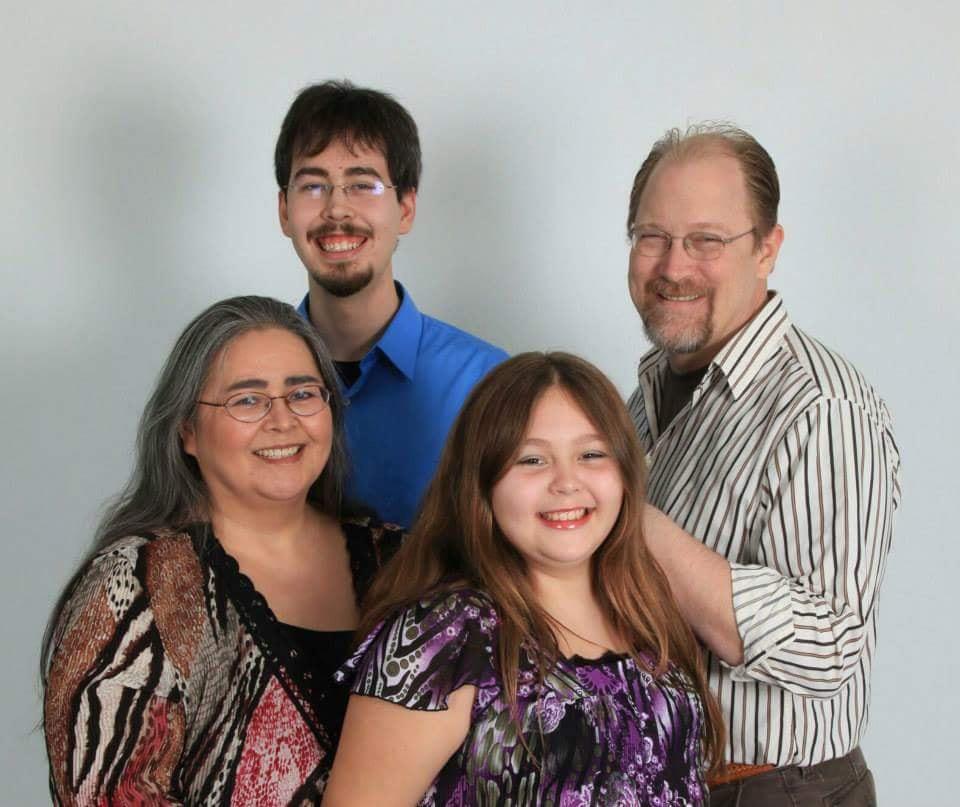
To me, health and wellness encompass physical, mental, emotional, social, spiritual, and
cultural aspects. Any and all of these components of a person are important, and if one becomes compromised, it then afects the whole person.
I want to stress that, as nurses, you must learn what the cultural norm of a person is. For example, I fnd it hilarious when I hear stories of nurses who do not know that non-verbal communication is a huge part of the Inuit and Gwich’in.
I recall a story of a nurse who complained that the ‘Native people’ were ignoring her when she asked a question. It turned out that they were wrinkling their noses for no, raising their eyebrows for yes, and shrugging their shoulders for “I don’t know."
Speak plainly, but in a way that patients can understand. For example, when I was delivering my son, it was taking too long, and he was becoming “distressed”. The doctor told me if I don’t deliver in the next 10 minutes, they would use a vacuum. I had no idea of what that meant. I did not want to have a hoover stuck up me to get him out, so I pushed hard.
Incorporate traditional knowledge. Did you know that a traditional Inuit and Gwich’in diet is very similar to the low carb/keto diet? Lots of protein, good fats, raw vegetables and fruits.
Due to my age, health condition and the infexibility of administration I have stepped down from nursing. I have not completely decided against working in the feld of nursing in some capacity, but I currently enjoy working with my husband. Quyanainni
73
To me, health and wellness encompass physical, mental, emotional, social, spiritual, and cultural aspects. Any and all of these components of a person are important, and if one becomes compromised, it then af ects the whole person.
AMANDA HAGENPOKIAK
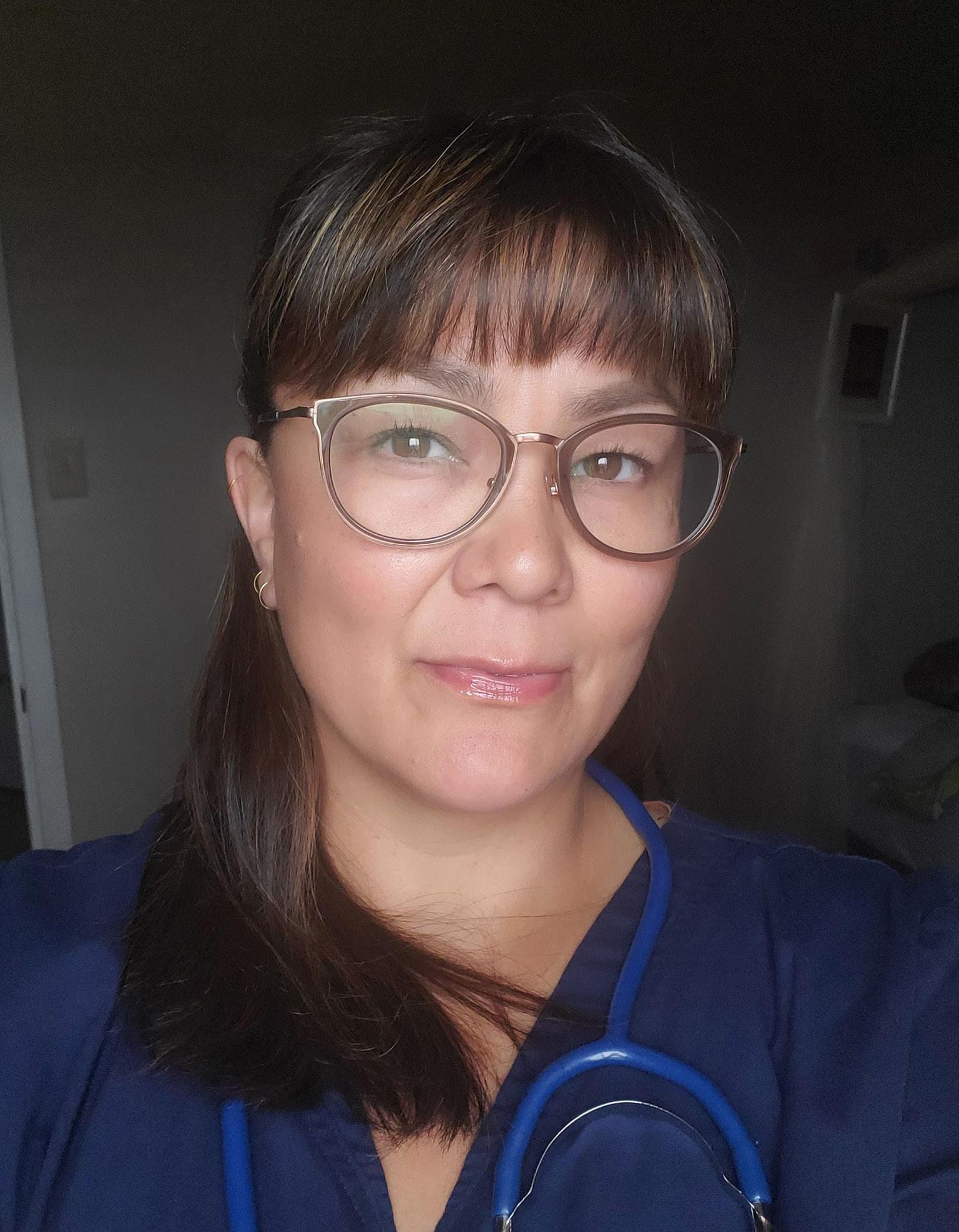
74
@ MRSPOKIAK
Personal Support Workers (PSW) work in a community health care setting—whether in a group home, or in a hospital, health care centre, or a long-term care setting. PSWs provide essential services to community members in need. Pharmacology factors into our work on a daily basis; PSWs with pharmacology are able to determine drug classifcations, highlighting the general characteristics of each class and understand the general explanation of how medications act on the body. We understand pertinent information regarding medication administration, routes, strengths, and terminologies.
When I was a fulltime student with a small child, it was challenging at times, but I had prepared myself for the journey. It included many late nights and early mornings. A strict routine and being organized was what worked for me. Each month my entire SFA cheque went directly to daycare fees; on top of being a full-time student I also worked on weekends to ofset the cost of living. If you really want something, you have to make some sacrifces. If you want it bad enough, you will fnd a way to make it happen.
One of the best moments for me during this time was when my daughter Tahira ran up to me at my convocation and gave me the biggest hug. I was so proud to be her mother that day. With a lot of hard work and determination—anything is possible.
I started working for Parkland Community Living and Supports Society (CLASS) during my studies in 2014. I have since moved on to the Supervisor position of the Billy Moore Group Home. What are my daily duties and tasks as Supervisor? Well, to name a few, I manage the overall program delivery following through with the goals, objectives, and values of Parkland CLASS, which is to improve the quality of life of people with disabilities through individual choice, dignity, and rights. I participate in staf recruitment, provide ongoing team development, and promote positive team morale and confict
resolution. I am responsible for the supervision of staf and scheduling of all appointments for individuals-in-service. I do bi-weekly payroll, monthly updates of staf rosters, daily recordings of the MARs (medical administration records), and I am also responsible for the quarterly reports.
Where do I see myself headed in the future of my career? I see myself continuing on in making a diference in the lives of our most cherished community members. When you love what you do, it's not a job. I have found my passion and I will continue on being of service. I enjoy being an essential front-line worker.
If you want to become a Certifed PSW with pharmacology: frst of all, do your research. Ask yourself, "Can I see myself working at this long term?" You really have to enjoy being in this line of work. Start looking into accredited colleges; for example, Aurora College in Yellowknife ofers this program. If you think this is something you want to make a career out of, then go for it. Once you hold the credentials, the sky's the limit!
What do ‘health and wellness’’ mean to me? Self-respect and discipline. If you go against the laws of physics, your health will decline. Wellness is an active process of making healthy choices towards a healthy and fulflling life. Health is a state of well-being in which every individual realizes his or her own potential, can cope with the normal stresses of life, can work productively, and is able to make a contribution to our community. Personally, ‘health and wellness’ has taken me years to balance! (laughs) So, this question is close to my heart. Thanks for asking.
75
If you go against the laws of physics, your health will decline. Wellness is an active process of making healthy choices towards a healthy and fulflling life.
LORNA CHANDLER
When I was hired, I took training both through the company that hired me and through Norquest College. I took their 8-month course option and I had paid training. Also, LFS paid my college tuition up front, and I paid them bi-weekly from my paycheck (it was a great option). This course can be taken [through most colleges].
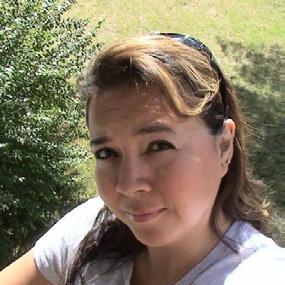
My most memorable moment working with Elders… It's more than just one really; it's been memorable from my frst day! I was nervous a lot at frst, but a lot of my clients are very patient and understanding. This made my job so much easier by having such wonderful people to assist everyday… which is why I look forward to each shif with such joy. I love what I do and love that what I do assists elders to remain comfortable and independent in their own homes.
I sanitize my hands before providing care, while providing care (between glove changes). I use lots of soap and water as well, and even after care. When I return home, I shower and wash my used uniforms (or scrubs). I keep updated through work a lot as well. I'm also wearing disposable masks. I've been social distancing when I'm of work and only go to the store or anywhere if I really need to. In Southern Alberta, we were lucky not to have had a lot of cases here.
To me, health and wellness mean: getting the sleep I need each night (in order to be able to perform well at work and have good mental clarity), to keep myself hydrated, and to eat properly. Exercise is pretty important as well; with what I do, I need to be in good shape as it can be a very physically demanding job most every day.
76
Ever since I was a child, I've always enjoyed talking and interacting with elderly people. Also, as I've grown up, I've just always liked to help people as much as I can, so I can say that I've really found the ‘best of two worlds’ in my career as a health care aide. I've enjoyed what I do for the last 5 years, since I started working with Lethbridge Family Services (LFS).
I have been a registered nurse for 18 years. I started as a general duty nurse and labour and delivery nurse at the Inuvik Regional Hospital Acute Care then afer a few years went to work as a home care and public health nurse for many years. In 2015 I moved away from frontline nursing and went into management where I was the manager of acute care, the emergency department operating room, endoscopy and the central sterilization room.
Nursing is such a rewarding career and there are so many diferent areas of specialties that you can do. There will always be work in this feld as there will always be people to care for. I have been blessed and it has been so rewarding especially to be able to care for, support and celebrate with families that you have known your entire life in my career.
In December of 2017, I decided to make a change and leave the GNWT and work for the Inuvialuit Regional Corporation as the Inuvialuit Health System Navigator. Here, I was able to work for the benefciaries and assist their health needs.
GNWT
RESPONSE TO COVID-19
I am happy that the GNWT has heard the concerns of residents and are ensuring they are focusing on protecting smaller communities by providing isolation centres in the regional centers as the communities do not have the capacity to deal with a COVID outbreak. They have also moved to virtual care to ensure that everyone has access to medical appointments and even telephone counselling. This is a way for
those who are not wanting face to face to continue having their appointments.
As a Member of the NWT Legislative Assembly (MLA), I have found myself working long days and responding to constituents as fast as I can; it decreases my constituents' stress when their questions can be answered quickly. This has caused me to become more tired—but that is a part of this job, so I try to get as much rest as I can when I can.
This is currently a global pandemic. although we do not have any active cases, we have residents that are continually coming and going out of the NWT and the ISR from all areas of Canada that do have active cases. Wash your hands frequently, use your mask in places you can’t physically distance, and if you are unsure if someone has travelled, practice physical distancing.

LESA SEMMLER
Health and wellness are not just about physical health where your body is healthy—it also includes mental health where your mind is also healthy.
77
EVELYN STORR
DIRECTOR, IRC HEALTH & WELLNESS DIVISION
COVID-19 had a huge impact on our division because we provide program delivery to communities. Because of all the restrictions, everything was just stopped. All the original plans, everything—we couldn't move ahead. The timing of COVID-19 wasn't the best because it was prior year-end, and people had program funds that were budgeted for; when COVID came, everything was put on hold. Thankfully our funders were understanding with the yearend activities, reporting requirements, and everything like that was taken into consideration. We communicate a lot with so many other agencies, departments, partners, and our people—so in the beginning of COVID, we had a lot of teleconference meetings!
One of our biggest concerns here was the mental health and wellbeing of our people because all this was so new. “You can't do this anymore; you can't go visiting…” [But this is] the way we are as a people. All of our traditional activities and events were all cancelled. People were thinking, “What are we gonna do?!"
That's why we provided initiatives to help Inuvialuit. Where's the best place to put people if you're gonna ask them to not do stuf they used to do? “On the Land” became a big thing. People of course were afraid—but they felt comfortable and safe
being out on the land, and that was the best feeling and place for them, and for their mental health.
I believe we have to be a part of the bigger picture; we are a part of a bigger picture. As Inuit, we share a lot of what other regions in the Inuit Nunangat are doing. I always try to see if we can adapt some of their ways and what they are doing. For example, there are lots of supports when it comes to households, especially in the area of groceries and cleaning supplies in order to maintain their homes; there's a lot of similarities.
HEALTH & WELLNESS DIVISION RESPONSE
The staf at our division have been very creative in trying to provide activities for families, children, on the land… We have been working overtime through this whole thing! You know, some of my staf, when they're at home working because their children are home, they have to take care of their family, and the work on top of that. People are working a lot, just because the computer is right there! It doesn't always end at 5, because we have deadlines to meet. It's been very ongoing, and we are pulling the team into areas that really don't relate to their job title, or what they would typically be focusing on. So, we're accessing the skills of everyone, and we have a team approach.
78
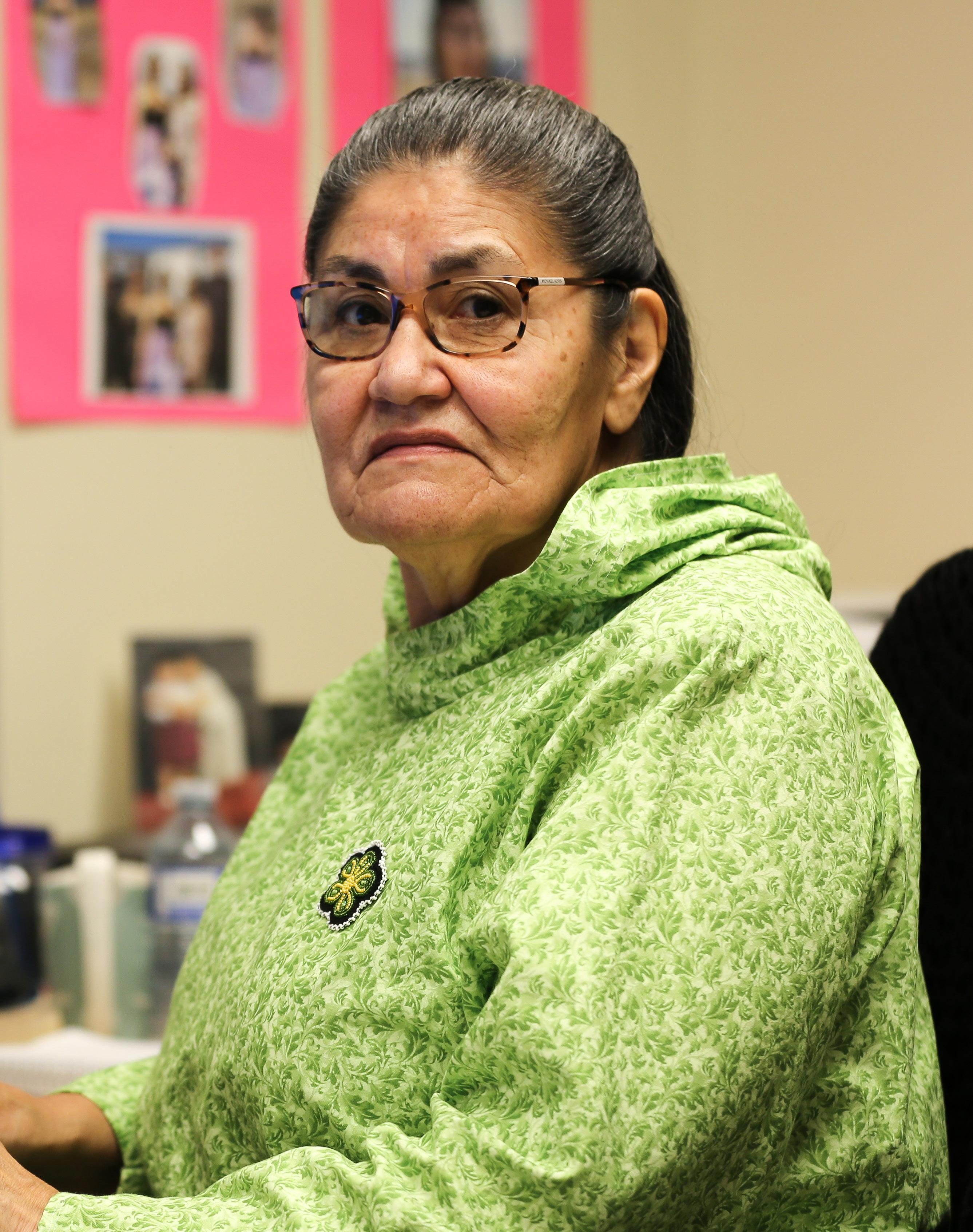 PHOTO BY STEWART BURNETT
PHOTO BY STEWART BURNETT
Yes, COVID is here, but we are still working hard to meet the needs of Inuvialuit benefciaries! Because this all has been over and above our work that we regularly do—with the additional support available for benefciaries—we have had to set up processes that are most efcient. What I have been doing, as Director of the division, is delegating and working to implement IRC's supports to benefciaries. I have to oversee that implementation is done in a timely manner and consider what the most efcient and best way is to implement the programs we are funded for, so that everybody gets support as soon as possible. We are not just dealing with just people in the ISR; we are dealing with all benefciaries. So, when we work with benefciaries outside of the ISR, we look at the best way to accommodate their needs, so they get their support in a timely manner. And of course, when something is new, you always run into these little bumps along the way. We just have to work through it. But our main focus is to support benefciaries. We ask: are we meeting the needs of benefciaries?
STAYING WELL DURING COVID
I think we have a pretty good team approach in ensuring everybody is taking care of themselves. I like to say: "Take a little breather here! Go and spend a weekend out on the land!" We can't do anything for anybody if we're not taken care of.
One of the other things I do constantly is making sure I connect with the fle leads and communicate with the staf regularly to ensure their wellbeing. And that's really important for me—is that I'm not just here to say, “This is what we're gonna do, and this is how we're gonna do it.” Our staf are all a part of deciding and seeing the best approach; so, everything is done to a team approach. There's a lot of team players! I think that's really important that people out there know that there are bumps along the way, but we work through it. So, the next time we do what we're doing, it gets a little better, a little easier.
Communicating with the staf to ensure that we're all fne is important to me—just to make sure. You have to be able to debrief with staf: “How are things; is this the right approach?” It can get overwhelming. When I can sense that we are running into issues with the implementation of initiatives, we just have to communicate and get input. It's just about having lines of communication open.
Personally, I go for my walks, and I’ve gone fshing! We're taking the time, hoping at 5 o'clock we can go home and have our time in the evening. That is the time we have to take for ourselves. We are available if there are emergency situations or issues—we will assist—but defnitely, I encourage my staf to take the time for themselves and I won't put anything on them afer fve, unless it's an emergency. I know that they have families and they need that time. My family and extended family are doing well. Some of them are out on the land, and I am keeping in touch with them.
THE NEW NORMAL
Personally, I think a typically bad situation like COVID-19—hopefully—can have some longterm benefts. People might not even notice that these benefts have come out of a situation like this. I really believe that families have been strengthened because they've been together. I think, this year, we've seen the numbers go up with families that have chosen to be out on the land—or what we call, "Springing Out". I think those numbers are high compared to other years, because of the support that was there and available for people to spend time out on the land. They got some good support, so they've chosen to spend the spring out there until the open water.
My recommendation moving forward is to keep checking the IRC website (irc.inuvialuit. com). They might hear little talks out there, but I always tell people to make it a habit to check the website. If there are any new or existing programs available, that's where the information will be. For those who don't have access to the website, they can check with their local community corporations, with staf who will be willing to help them.
80
I think a typically bad situation like COVID-19— hopefully—can have some long-term bene fts… I really believe that families have been strengthened because they've been together.
I think what people should be doing—and I know they are doing it—is adhering to the public health protocols. That's really important. Wash your hands! The messages we've been hearing across Canada are for everyone, whether you're a person from an isolated community or not. You still need to follow those things.
I think because of the way the kind of people we are—we like to socialize. I think that's been one of the biggest struggles: how do you stay away from your family? It's hard when you're not living in the same household, but you have to do it. And that's the top messaging that we want to continue to give out, even though our numbers are down.
I think our people are really concerned about what's gonna start opening and everything like that. We just have to adhere to what our Chief Public Health Ofcer and our Minister of Health and our government leaders are saying needs to happen.
People coming in from the Yukon were so used to travelling freely, so the 14-day isolation period now—can you imagine?! That's a huge change! We're not a big territory; people know who goes in and out, and when they see them out on the street, they can notice when people weren't isolating. And so, people were using the hotline number (811) to report their concerns, because they were concerned for their health.
If I had anything to say to our people out there: again, please continue to follow the public health protocols. We will continue to provide support for the health and wellbeing of all our benefciaries. That's the important thing, and that's the goal of our division—is that we're here for them if they need anything, and we just want to continue to provide that support for them. Even afer COVID-19, we're here for them. It doesn't end when COVID-19 ends—it's ongoing. That's the goal!
GIVING AND RECEIVING SUPPORT
This morning we had an email, and it said: "Hope you are well and staying safe in these crazy times. Just a note to say thanks for the amount that came into my account. It was a good surprise to get and I really appreciate it. My grocery bill has been going up since all of this, as everyone is eating at my place now! So, it's really helped during these COVID-19 times. Thanks again!"
The Health and Wellness Division would like to thank everyone for their positive feedback from the work that we've been doing. They are supporting us when we get a message like that. They don't realize how much that means to us— to keep doing the work that we're doing.
INUVIALUIT REGIONAL CORPORATION (IRC)
RESPONSE TO COVID-19
Inuvialuit Regional Corporation received $5,850,000 from the Government of Canada in direct, distinctions-based funding to address the needs of Inuvialuit in response to the COVID-19 pandemic. As a result, Inuvialuit Regional Corporation (IRC) is grateful to have been able to provide some contribution, with the help from partnering businesses, to support long-term activities on the land.
W DIRECT SUPPORT TO COMMUNITY CORPORATIONS
— program funding was increased to each Community Corporation (CC) to help in their response to community COVID-19 preparedness
W DIRECT FUNDS TO URBAN INUIT ORGANIZATIONS (UIO) — program funding was directed to Urban Inuit organizations to assist Inuvialuit in the cities
W FUNDING TO ALL ELDERS — every Inuvialuit Elder over 60 years received increased funds from IRC to help them meet their household expenses during the pandemic
W WOOD AND/OR ICE FOR ELDERS — IRC assisted Elders whose homes are fueled with wood, and provided ice for drinking water
W VOUCHERS — distributed for households in need of bulk food purchases and cleaning supplies
W FUNDING FOR COMMUNITY HARVESTS were distributed to all CCs
W SEWING PACKAGES — distributed by each community with thanks to Inuvialuit Cultural Resource Centre
W COUNTRY FOOD — distributed to all communities
W OTHER — fshnets, educational kits for children, frst-aid kits for households were distributed by each community
For more information about IRC's COVID-19 Response, please visit: www.irc.inuvialuit.com
81

SUSAN PEFFER
The majority of the projects here has been the Day School Applications and talking to Inuvialuit benefciaries about their wellness, too. People want to just share and talk; they're sad or they're feeling depressed. Lots of that. Lots of feeling isolated and alone. Nobody to talk to.
My conversations are not so much with the Elders, because they're actually not connected to anything, ah? No internet, no devices, nothing. So, it's mostly been 30- to 50-year-olds that I've been talking to. And I always feel for the Elders because they have no way of connecting. I fnally connected with one yesterday and she said she had to go to the hospital because she was feeling so alone. She lives alone already, with nobody to talk to, nobody to share with, no devices—like nothing. So, she had to go to the hospital. She didn't want to take medication… but she was so happy when they opened it up a bit for fve visitors.
So, in our program—that's what we do. We just reach out to people. If I see somebody who's saying, 'Boy, I'm going through a hard time!' on Facebook, I'll connect with them on Messenger and I'll ask them how they're doing, what can we do for them, and how can we help. It's an important job. Oh, for sure, I enjoy it though!
LIFE DURING COVID-19
Even for myself, I really felt stuck, too. So stuck! Because I couldn't go visit [my sister] Lillian, I couldn't go visit Valerie... or anybody! I just had to stay home. I wanted to cheat—like, I'm just
We just reach out to people. If I see somebody who's saying, 'Boy, I'm going through a hard time!' on Facebook, I'll connect with them on Messenger and I'll ask them how they're doing, what can we do for them, and how can we help. It's an important job. Oh, for sure, I enjoy it though!
gonna go [visit] anyways—but then I felt I can't do that, either. If I want people—especially my grandchildren—to abide by the law, I should be abiding by it, too! Like, boy—I couldn't wait to visit [afer restrictions lifed]! And I'm sure even the young people felt it, too, because they felt alone. It got really tiring for a bit—like I really got tired of doing nothing! Because I was so used to going, going, going! Driving here, doing this! I really got tired. [Self-isolation] was like, I went from the kitchen, to the table, to the couch... that was it! I thank the Lord for my space, because I was able to play my music, pray, sing. So, it helped me. Singing, music, for sure! Fellowship over the phone; lots of singing we used to do.
IRC RESOLUTION HEALTH SUPPORT WORKER 83
A COMMUNITY COMING TOGETHER
I think about the people out here—oh my goodness—I've never seen people so well taken care of. The homeless were taken care of. The vulnerable were taken care of. The Elders were taken care of. People in general with children were all taken care of. So, you can't say that there's no money for something. Really, ah! All the time we do proposals and programs, it depends on the budget, it depends on how much cash we have. But with this COVID? I was just like, wow! Everybody was well taken care of. Like, above and beyond. There was no poverty. There were no people that were hungry. Nothing! And that was amazing. So, if that can happen at this time, we should continue it! We should! Because the morale of the people—everybody was just so happy.
I could buy fruit, and I could buy vegetables. I had fruit on my counter for every day, which I never was able to do before! I went to the supermarket, I was picking…oh I never tried this for long time! Living on a budget, I go from payday to payday, so I can't always buy the extras, because I have rent and everything to pay. So, with the support of the community, I was just like, wow, I had fruit all the time in my house—like fresh fruit! Things I wasn't able to buy before—I was able to get them.
Thankfully there was no cases in Inuvik, unlike people in the city, how it spread really fast. Before all this COVID started, when I looked on Facebook, people would be chatting, “Gee, I got sick today! Boy, I got the fu today! Oh my goodness, I got this bad cold!”
Now with self-isolation, I never seen that, the whole time. There was no fu going around, no people with sickness! Washing your hands… those sorts of things!
We're such a huggy people! We're so huggy and loving! We just can't live without it especially here. So that too, now, is a diferent way, diferent perspective for us. We're so used to greeting each other like that. Hard, you know, it was! Especially when they said you just gotta elbow! Honestly.
GOING OUT IN THE LAND
During COVID, the town [of Inuvik] felt so quiet! Oh my goodness. There was just nobody and nothing around. No movement! So, I was glad when we went out to Lillian's camp. And that's the really good thing about all this, is people are returning to their camps—and they haven't done that for years! We were just sharing at her camp that we been too busy to think, "Let's go 'spring out' at our camp! Would have been too busy to do that!” But this made us come together. And it was the most beautiful time! It was really nice to be out.
People going out in the land, especially. We hear it many time and time again, from my sister Lillian and my brother Leonard: the land heals you. If you go out into the land, if you chop wood, if you go for a walk, that's going to heal you. That's what makes you feel good! And we were “stuck” for a long time, because of society I'd say. You have to work, you have to buy a car, you have to own a house… All that stuf, yes!
And even doing outside [Inuvialuktun] classroom now, it's so beautiful! When do we think of doing things outside more, you know? You don't think like that, you're just like: go to work in the morning, go home at night, [then] I'm not doing anything else tonight... you know like that? Because we're so distracted by time that we forget about each other and we don't check in with one another. I'm so glad—I'm really thankful—if our mindset can change to stay this way.
84
We hear it many time and time again, from my sister Lillian and my brother Leonard: the land heals you. If you go out into the land, if you chop wood, if you go for a walk, that's going to heal you. That's what makes you feel good!
The Health and Wellbeing of Ancestral Inuvialuit on Banks Island
Inuvialuit often say that they feel best out on the land. Fresh air, open space, and being in the landscape are good for the mind, soul, and body. Tose out hunting, fishing and gathering country foods tell us the same thing: that these are equally good for their health and their wellbeing. Here, we look at the health and wellbeing of ancestral Inuvialuit who lived at the site of Agvik, on the south coast of Banks Island, some 5-600 years ago.

INUVIALUIT PITQUSIIT INUUNIARUTAIT 85
WORDS by NATASHA LYONS & LISA HODGETTS
Agvik, which is located about 30 km southeast of Sachs Harbour, was excavated by an archaeological team from the University of Western Ontario and Sachs Harbour in 2014. Te site consists of winter sod houses and qarmat, shallow sod dwellings with an earthen floor and entrance tunnel used in the spring and fall. Based on the remains of plants, animals, pottery and artifacts, we know that the residents of this site harvested country foods, medicines, and technologies throughout their region.
Animal bones from Agvik tell us that the residents ate a varied diet. Natchiq (Ringed seal) was the main food harvested, along with tuktu (caribou). Tiriganniaq (Arctic fox) was also harvested in large numbers, showing that they played an important role in life on the island long ago, just as in more recent times when many Inuvialuit ran successful trap lines in the area. Kanguq (Snow goose), ukaliq (hare), nanuq (polar bear), aqitjgiq (ptarmigan), iqalukpik (char), and singayuriaq (trout) rounded out the menu, along with small numbers of a range of other species. Te large number of slate ulu blades and scrapers found in the dwelling suggests that the residents were processing lots of skins at the site, likely seal and fox in the spring.
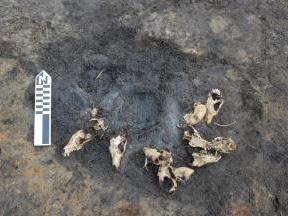
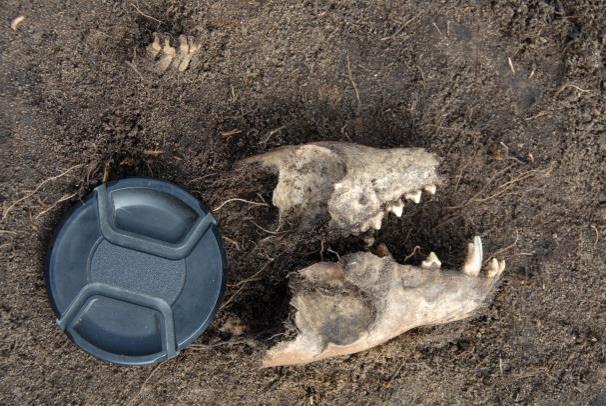

Based on small plant parts—seeds, wood, leaves and stems—lodged in the qarmat, sometimes stuck in seal oil, we also know how Agvik residents gathered, ate, used and stored the plant life around them. Tey ate spring greens like quaqqat (Arctic dock), and likely the roots of aiqqat (wormwood) and ipiq (Arctic bistort). Tey enjoyed uquit (bog blueberries) and kimmingnat (bog cranberries) and it appears that they used the leaves of uyauyaq
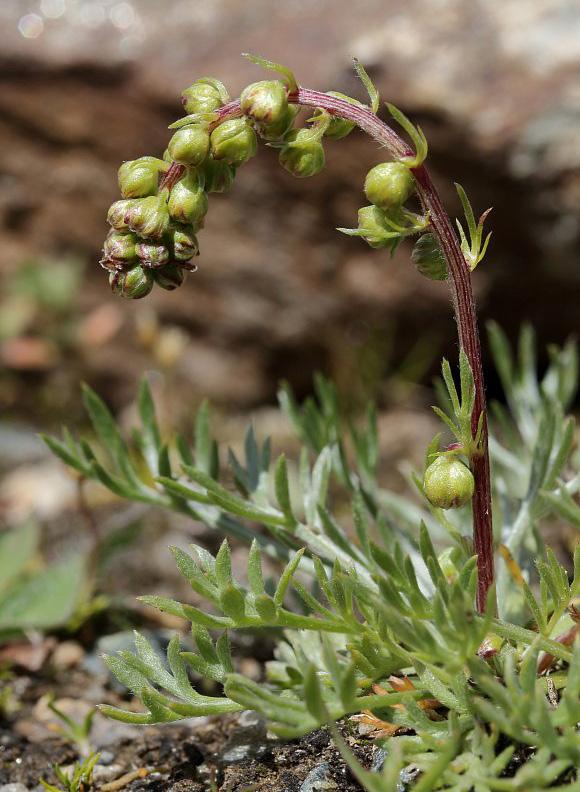
(mountain-avens) for tea. Medicinally, uqpiit (willows) may have been used for pain relief and wormwood for skin and lung conditions.
For over a thousand years, Inuvialuit and their ancestors have been harvesting throughout their territory. People lived at Agvik on and of for several hundred years, learning and following the annual patterns of wet and dry, warm and cool, light and dark. Tey learned the specific tastes of the local plants and animals, when and where they gather and ripen, what nutrients they provide and the ways they heal, and how to cure, store and prepare them. In the summer, they likely moved into the interior of Banks Island to hunt, and in the winter, they moved from their qarmat into their sod house next door for warmth. Te pottery and artifacts on site suggest they traveled to Victoria Island and the Mackenzie Delta, perhaps across the spring sea ice. Te remains they left behind reflect an active and successful livelihood, and resilience in hard times, much like what Inuvialuit Elders say about their own early days. Much of the knowledge that they learned from the land has been passed down through the generations to be used by present-day Inuvialuit for their own health and wellness.

To learn more or share your knowledge please contact us on Facebook at: @InuvialuitLivingHistory. Inuvialuktun plant names and knowledge are taken from Inuvialuit Nautchiangit. Many thanks to Doreen Carpenter and David Haogak for sharing their knowledge about Banks Island plants, Beverly Amos for checking the Inuvialuktun terms, and Laura Kelvin for sharing photos and connections.
INUVIALUITLIVINGHISTORY.CA

INUVIALUIT PITQUSIIT INUUNIARUTAIT
86 AUYAQ SUMMER 2020
( ) OkRn-1_238b nanuq tooth from Agvik, sized to scale. (BELOW, TOP-BOTTOM) Tiriganniaq skull feature; Tiriganniaq bones in hand; Tiriganniaq skulls and paw; Uquit; Aiqqat
0 AGVIK COASTLINE
AGVIK (OkRn-1) IS AN ANCESTRAL INUVIALUIT CAMP LOCATED ON TOP OF A STEEP BANK ABOUT 30 KM SOUTHEAST OF SACHS HARBOUR. Thule Inuit, a name archaeologists give to the ancestors of all Inuit, including Inuvialuit, migrated into the Canadian Arctic from Alaska around 1200 AD. Agvik has the remains of at least 13 houses, possibly as many as 15. Most of them cluster near a gully that leads from the top of the bank down to the gravel beach. Radiocarbon dates show that people lived at Agvik during at least two diferent periods, frst between 1400 AD, and again around 1550 AD. (Text: Lisa Hodgetts)


 COLLAGES BY KYLE NATKUSIAK ALEEKUK
COLLAGES BY KYLE NATKUSIAK ALEEKUK

PHOTOS USED WITH PERMISSION FROM FACEBOOK FOLLOWERS
On behalf of the Inuvialuit Communications Society and Tusaayaksat, we ofer sincere condolences to the family and friends of Mr. Colin Gordon and the community of Aklavik.

Colin was Aklavik’s representative on the ICS Board and always ofered great advice and perspective with ICS’s production.
May he rest peacefully.
INUUHIRIKTUQ HEALTH & WELLNESS 91
IN MEMORY
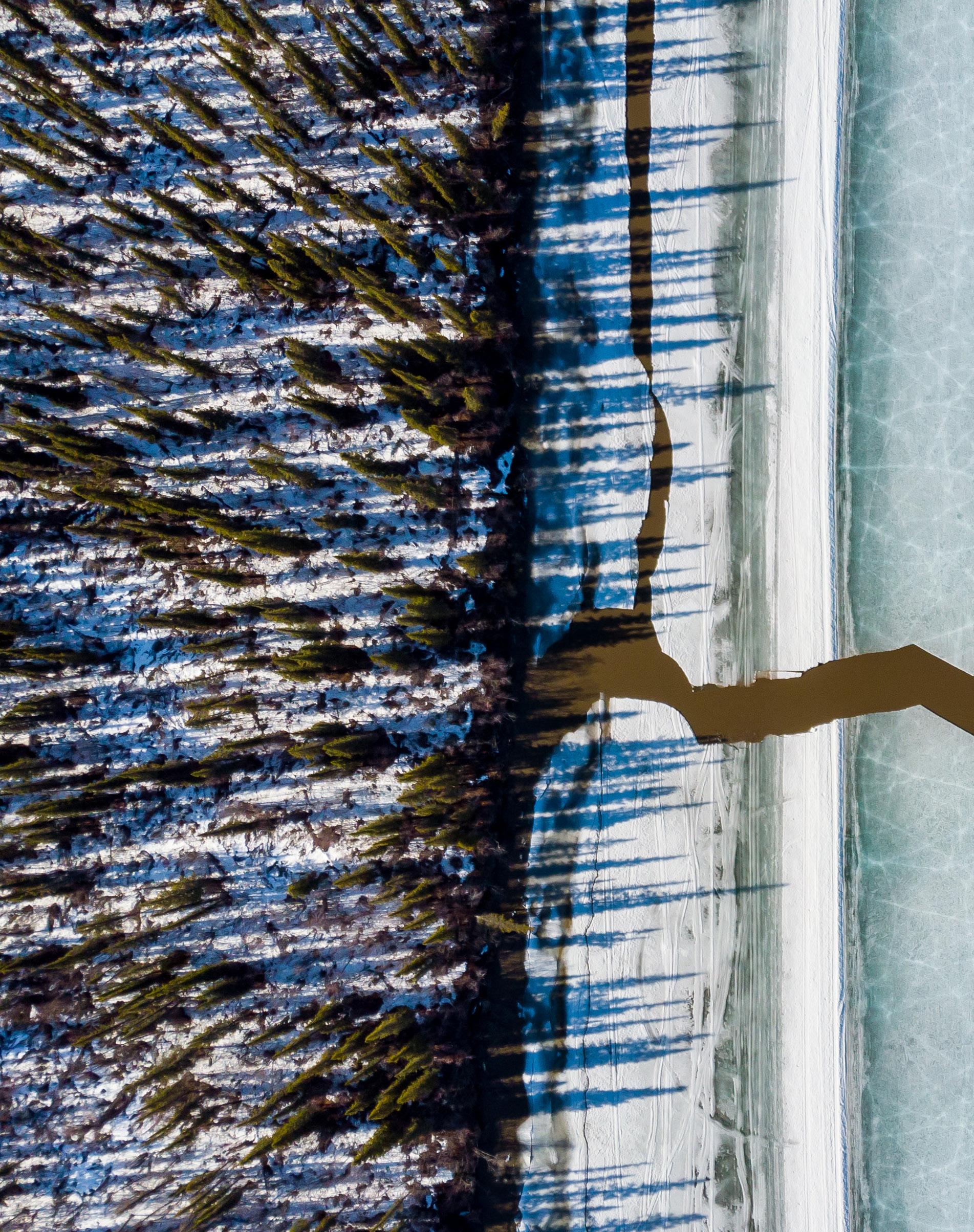
HOW TO GET GOOD
"When you habby, you gotta laughing it. When you sad, you gotta crying it. When you mad, you gotta talking it. When you don’t, he gonna piling it up inside. Just like ice jam, and he gonna busting it out."
 PHOTO BY KRISTIAN BINDER
WORDS by DENNIS ALLEN
PHOTO BY KRISTIAN BINDER
WORDS by DENNIS ALLEN
It was the end of May and the river had just broken up. Huge broken chunks of winter ice flowed down the river and everybody was sitting by the river watching them drift past. Spring was in the air. He was sitting on a bench smoking a pipe and looking quite content in his parky cover and rubber boots. He looked like he could answer some of my questions, so I sat down beside him. He spoke in broken English and I’m writing down exactly how he said it. Instead of saying “you have to get it,” for example, he said, “you have to getting it.” I told him who I was and shared a few memories of him and my dad back in the 'Pefer Hotel day' of Aklavik.
“What you think they mean when they say, mental health?” I asked the old-timer. He stoked his pipe with a match and watched some kids skipping rocks. He looked at me for a long time. Ten he jabbed my temple with his bony finger.
“You head,” he said. “You gotta looking it after you head.”
“How?” I asked him.
“You all the time worry, worry. Same time, you got no wood. You
got no grub. You got no tobacco. You bumming it steady. Just for worry.”
I guess what he meant was I was wasting my time dreading things that either were not going to happen, or had happened and I could not do anything about anyway. In the meantime, life was passing me by and I was not getting things done, like cut wood or hunt or work for food and buy myself tobacco. I had to gulp because he was right.
I recall one spring when I was laying around and worrying for nothing. I had a friend named Lonely Loreen who was not scared to tell the truth. He said, “Turn him over, he’s turning green on one side.” What he meant was that I was rotting from laying around and worrying.

I don’t like to admit it, but a lot of times, too, I was worrying about what other people were thinking of me. I would act one way for this guy, and act this way for the other. I really didn’t know who I was. And I wanted his advice.
“What about other people? Should I worry about what other people think about me?” I asked. Te Elder
When we think of health, we just think of our bodies, like our heart rate, blood pressure, and gizzards and stuff. But what we don’t realize, is that we have other aspects of health too, like mental, spiritual, and emotional health. I had no idea what that meant, until I asked an Elder.
struck a match on the bench seat and re-lit his pipe. He sucked on the pipestem a few times till a puf of smoke came out of his mouth.
“What other peoples is thinking it about you is none of you business,” he said.
“What?” I replied, not understanding his logic. He jabbed my head again.
“I can’t going it in you head and changing it.”
What he meant was, I can’t change what other people think. I have no control over their thoughts; some might think bad of me, for whatever reason, and some might think good of me.
“When peoples thinking it bad of you, they jealousy.” he said.
What I took that to mean was, when people try to put you down, they’re usually envious of something you have, like a certain personality trait. Maybe you’re popular, or kind, or talented.
“Lots of peoples is angry peoples. Tey trying hurting it other peoples by talking it bad about them.”
I thought about it and figured what he meant was that there are a lot of angry people in our communities, for whatever reason, and they try to hurt others to the extent they are hurting themselves.
“What do I do?” I asked.
“You loving it like you loving it you own kids,” he said.
“You mean to have compassion for them?” I asked.
“When you loving it other peoples, you loving it you self.”
I had to swallow hard. A lot of times I answered anger with anger. I didn’t realize I had a lot of anger inside myself. And whenever I felt threatened, my anger would come out. Te old man continued.
“When you fighting it peoples, you really fighting it you self.”
I had to ponder that one for a moment but came up with: when I’m an-
gry at someone, I’m usually angry at myself. I see something in them that I see in myself that I don’t like, such as jealousy, fear, low self-esteem, or shame. And when I show that anger, I’m only damaging myself.
“What about emotional health?” I asked him. He pulled out his cellphone, checked and dismissed a message, then put it back in his pocket. He pointed to the broken ice running in the river.
“You seeing it that ice,” he asked, “When nothing it is in his way, he gonna go all the way to ocean, but when something making it jamming up, he’s gonna piling it up. When he can’t take pressure any more, he gonna busting.”
He blew a snot rocket and wiped his nose with a rag from his back pocket.
“Inside here,” he said, pounding his chest, “When you feeling it inside here, you gotta letting it flow, just liking it that river,” he pointed to the river.
“When you habby, you gotta laughing it. When you sad, you gotta crying it. When you mad, you gotta
“My wife, he wanting it me to pick up loaf of bread” he said. “Hunaguuq?” he asked, meaning, “what did you ask?”
“What is spiritual health?” I asked. He thought for a moment, put his pipe in his coat pocket, and looked at me for a long moment.
“You gotta believing it in something. Something that making it you do good.” he said.
“Like what?”
“Like God, Creator, or what they calling it him, Mohama?”
I knew what he meant was Mohamed. I had to think hard.
“I’m not a Christian, or a Muslim, or anything for that matter. But I do believe that inside every man, woman, and child, is a shining light that guides us to do good,” I said. A cab pulled up and the driver rolled down his window. And with a Middle Eastern accent called out:
“Taatak, time to go home. Naanak is worried for you.”
Te old man put his pipe in his pocket and put his hand on my shoulder.
talking it. When you don’t, he gonna piling it up inside. Just like ice jam, and he gonna busting it out. And next thing, boom, you gonna fighting.”
I had to agree with him. Many, many times in my life I'd busted out in anger because I held in too long. And he was right—I hurt a lot of people. I had one more question for him.
“What they mean spiritual health?” I asked him. His cell phone rang and he spoke to somebody in Inuvialuktun for a moment before putting it back.
“Ten you gotta feeding it that light. When you feeding it, you spirit, he gonna come out.” He looked at me. “Taima?” (Are we done?) I shook my head yes. He hobbled over to the cab and greeted the driver.
“Shalom,” I heard him say, then he turned and winked at me.
“Qanuqitpit?” I heard the driver ask as they drove away.
“Pretty good, not bad,” the old man replied, “Pretty good, not bad.”
INUUHIRIKTUQ HEALTH & WELLNESS 95 HAVAARIKTUQ / CREATIVE
I guess what he meant was I was wasting my time dreading things that either were not going to happen, or had happened and I could not do anything about anyway… I had to gulp because he was right.
The Men in Mental Health
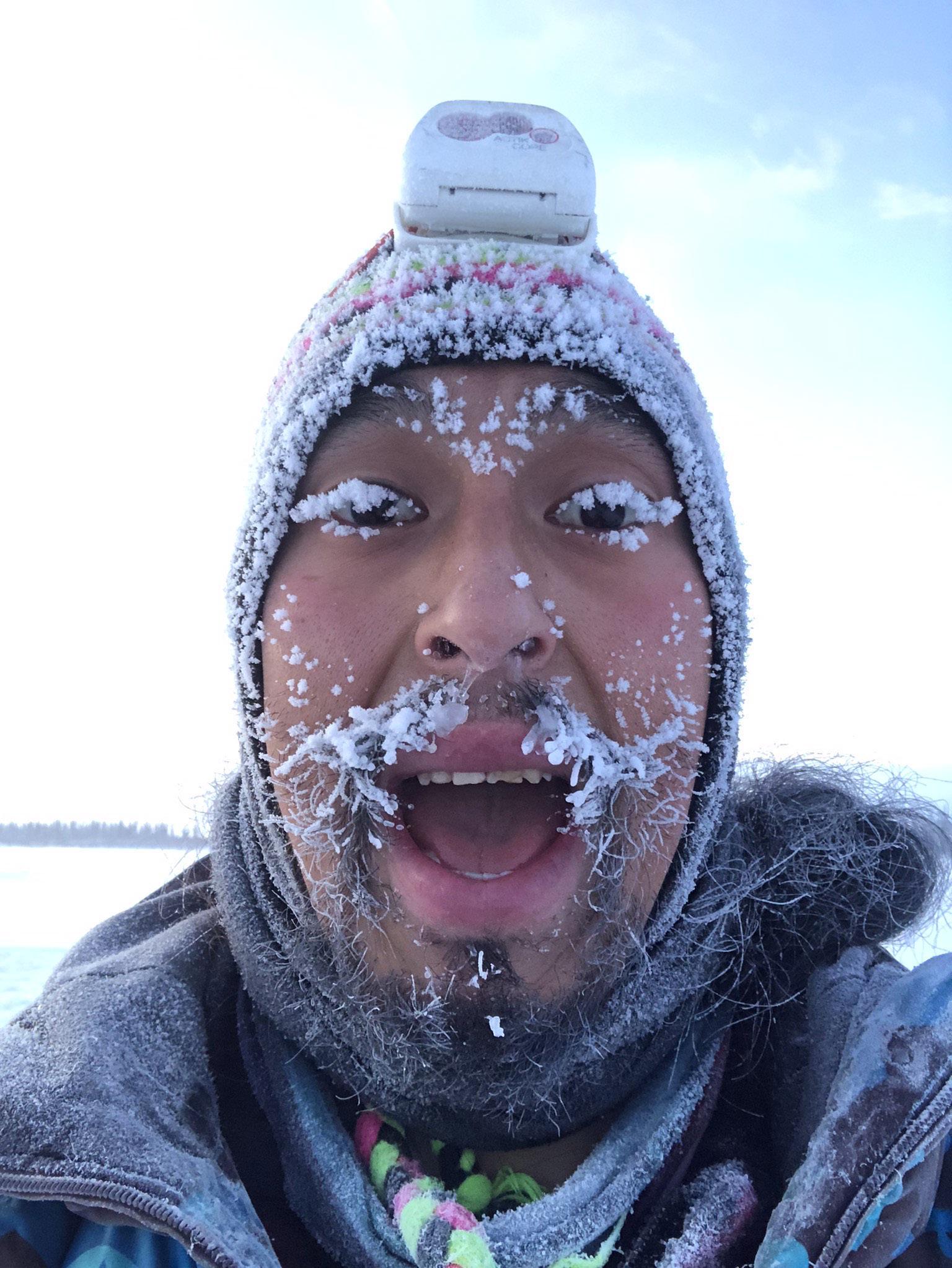
 WORDS by NOEL-LEIGH COCKNEY
WORDS by NOEL-LEIGH COCKNEY
I have been very lucky about how I grew up, hunting and fishing along the coast of the Arctic Ocean and at Husky Lakes (between Tuktoyaktuk and Inuvik, NT). In having this, it had reignited in me how my ancestors had to be. In my mind, my ancestors had to be both physically and mentally strong. Given where it is that we live, that makes sense—if we had a lapse in thought to go harvesting when we were running out of food, we would not have been here for such a long time. I am lucky in having this similar mindset.
Te human brain is a fascinating thing—we all have so many ways of problem solving, interpretation, insight, and actions. When someone has a troubled home life and continues to live in that environment, that is all they see and live and act. Despite having a troubled life or not, we all have our demons that haunt us, that start to bring us down in a rut, that tries to isolate us from those around us.
When I meet people for the first time, I am the shy and scared kid that I was growing up. It takes me a while to get to know people and for people to get to know me. It is only my good friends that I have been able to really open up to and be able to relax with. Tere are only a handful of people that I call good friends, but I am still friendly to those who
are friends, and those that I meet…don’t get me wrong. I have been this way because of the mindset that I have developed. I have kept a protected and guarded life, to keep myself from getting hurt, mostly mentally, although that guard is slowly disintegrating as the years are going on.
When you go down the dark hole of depression, it is just that—dark. It is diferent for everyone, but in the end it leads us all to the same point. It leads us to loneliness, despair, “rock bottom”, and for some, drugs and alcohol. You get inside your head, which brings you down into feeling like there is nothing out there for you, that there is nobody there for you, and that you will never be enough for anybody out there.
Some get inside their head so much that there is this voice guiding them to do something to silence it. To do something that will finally quiet all the voices—the voices that pull you in every direction possible. Voices that pull you toward your goals you’ve set for yourself as your life goes on. Voices that pull you toward certain people, voices that drag you to work and then back home. Voices that get you out of your bed. Voices that get you to put clothes on. Voices that bring you out your door, and voices that make you feel the loneli-
Everybody has their own way of dealing with their own state of mind. When I was about 12 or 13 years old, a very good friend died by suicide. After that had happened, even at a very young age, I developed a shield around myself to vow that I would not do that to my family.
INUUHIRIKTUQ HEALTH & WELLNESS 97 ITQAGIYAA / THINK ABOUT
ness, despair, and bring you towards the dark spaces. Tis voice that brings you to silence all those voices can be powerful in way too many ways. It’s not a voice that only silences those voices, it is one that brings so many questions to those that are left behind.
Te most dangerous thing you can do is be silent. To stay accustomed to the stigma that you have to be tough. To think that you are weak because you have feelings. To brush people of because they are yelling for help. What I want to say is that we have to break this stigma, to talk about your feelings no matter who you are, to seek out the help that you need, and to listen to those that need an ear to hear them out.
We all have diferent triggers that can bring us down into this dark hole, whether it is a word, a phrase, an action, or sight. Tis trigger can be absolutely anything.
When I was working down in the States, before moving back home, I led backpacking, rock climbing, and white-water canoeing trips
teaching those skills, along with leadership skills, basic camping, and group dynamics. When I met with those groups for the first time of a four-week, or three month-long course, the biggest thing I stressed was for that time we were going to be a family. All families have high points in living together, as well as low points. Being together for four weeks to three months long, 24-hours a day, people are going to get sick of each other, no matter how close you are. Being in such close proximity of each other, we don’t know what triggers people have, especially with those we are just meeting. As we get to know people, we start to figure out the quirks and buttons of those people. Tose quirks and buttons don’t necessarily represent the triggers, which is why communication is so important in bringing up these issues. Nobody is psychic; we cannot know that even a common word can trigger someone into a down feeling. Tis communication has to go both ways. One person has to muster up the feelings into a voice,

IT'S OKAY TO TALK.
CANADA-WIDE RESOURCES:
Crisis Text Line:
Text HOME to 686868 — https://www.crisistextline.ca/
Crisis Services: +1-833-456-4566
Text START to 45645, from 4pm–12am EST
NWT RESOURCES:
NWT Help Line: 1-800-661-0844

Kids Help Line: 1-800-668-6868
Child Abuse Hotline: 1-880-661-6868
Canadian Suicide Response: 1-833-456-4566
Residential School Support & Counselling: 1-800-464-8106
Beaufort Delta Legal Services: 1-800-666-0704
Crisis Line: 1-877-872-5925
Full directory of mental health & crisis resources: www.suicideprevention.ca/need-help/
and there has to be someone to lend an ear… not necessarily someone who ofers advice or suggestions, but someone to at least listen. No matter who you are, these things should not be bottled up. Eventually these feelings have to travel through your mouth, to be released from the cage deep within.
Everybody has their own way of dealing with their own state of mind. We have to find healthy releases of these feelings, though. We cannot go destroying life, in any way, shape, or form. When it all comes down to it, we all need space to digest our lives. To be able to efectively digest events that are happening, we have to have the right mindset. Getting to this right mindset is diferent for everyone. Some people need to be around other people, some need to be on their own, some need someone else to hear them out, some need to
scream, some need to breathe, some need to walk, some need to run, some need to sing, some need to write, and some need to create. On the other side of this, there are some who harm themselves to make them feel those feelings, some who need to mask those feelings with substances, and some who harm others because of that masking.
We are all human. Tere is no script written for us to go through our lives. We have to make things up as we go on, and we have to react to everything going on around us. We all have our highs and our lows. We all have people around us that appreciate us. We all have some kind of a purpose to our lives, no matter where you end up. We all have feelings. We all have to feel those feelings. You are not alone in having feelings. We need to break the stigma of “toughening up”. We are not alone.
INUUHIRIKTUQ HEALTH & WELLNESS 99 ITQAGIYAA / THINK ABOUT
We all have feelings. We all have to feel those feelings. You are not alone in having feelings. We need to break the stigma of “toughening up”.
To who you are,
To who you were,
To who was murdered or stolen.
To you,
To who you were and who you are today. You are not forgotten.
Our story is a little diferent but one of privilege and systems complex—and yet so vividly streamlined.
I read a periodical at my time at the Canadian Museum of History; it read of an Indian Agent that was in Inuvik conducting research.
Te focus was on one 16-year-old who clearly needed guidance and help. I won’t go into detail, as the words used to describe the events are despicable.
Who are you—a white privileged male—to speak her truth, her words, and description on what you saw, to outline a young woman and girl that needed love, support, and guidance?
When my grandmother’s and mother’s young adult lives were clouded by abuse, alcohol, and despair, society looked at them as less human. Tey dehumanized them to make it okay to rape and murder Indigenous women.
I never met my Naanak Eva. She was taken from us—no cause of death, no answers. My mother had to dig for answers to even find out where she was buried, and I know she was not alone in this, as it was a common practice at the time.
I’ve spent the past two years wondering what could possibly be causing my illnesses? What if there was an underlining genetic condition? Yet, to no avail, no words written or spoken can give us truth.
So today I say again: To who you are, To who you were, To who was murdered or stolen. To you, To who you were and who you are today. You are not forgotten.
WORDS BY MARY-ANNE FRANCEY
FASHION DURING A PANDEMIC
I’VE ALWAYS ENJOYED staying outside the box of what society views as the norm, so this season I am bringing to you what excited me during this pandemic that is completely traditional but also fashion-forward.
I have been on social media a lot more during this confusing time and it amazes me how creative my people have been! So many beautiful forms of art are online right now. My late grandfather Eddie Gruben used to quote Louis Riel to me and today it makes so much sense: "My people will sleep for 100 years, but when they awake, it will be the artists who give them their spirit back.” I believe this to be so true, especially during COVID-19. Te featured designers have been spreading positivity through fashion, giving us hope, taking our passed-on traditions, and making them fashionably modern—like an atikłuk onesie or beautiful crowns for Beluga Jamboree. From an amazing mother/daughter collaboration of earrings to a hair scrunchie— what a breath of fresh air during this lockdown!
I have also shared with you some of my She Was A Free Spirit earrings that will be available at Indigenous Fashion Week Toronto once it is back up and running (it is currently postponed because of COVID-19). I am always on the lookout for a fresh set of earrings. I am excited to share with you these beauties in this season's issue!

u SHE WAS A FREE SPIRIT with harp seal. Hangs 23" long. Will be featured at Indigenous Fashion Week Toronto (IFWTO). $195.
v YOUTH ATIKŁUK Christina King @feelthegentlebreeze, Tuktoyaktuk.
w GRANNY HANKY MOCCASINS. TeriLynn Mcleod, Aklavik. $300.
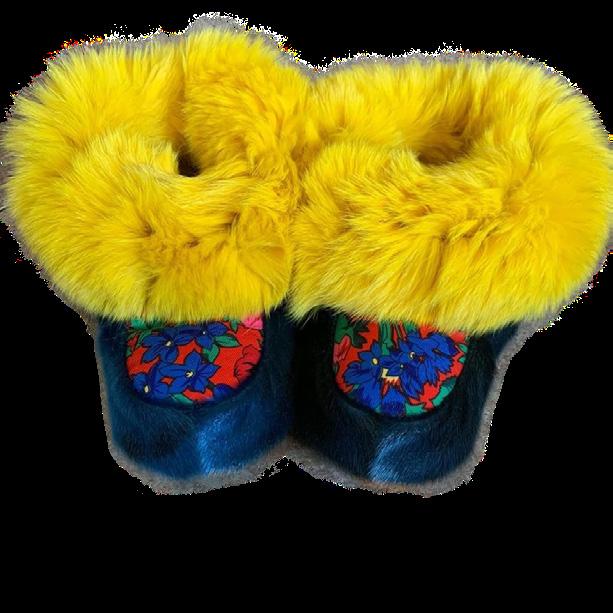
x TUK BELUGA
JAMBOREE KING & QUEEN CROWNS. Elizabeth Arey @arcticoceanmocs, Tuktoyaktuk.
y ULU FRINGE EARRINGS. Debbie Dillon @deltadebz, Inuvik. $60.
z INUVIALUIT ONESIE. Christina King @feelthegentlebreeze, Tuktoyaktuk.

{ INUKSHUK
BIRCH EARRINGS. Christina King @feelthegentlebreeze, Tuktoyaktuk.

| "SUNSET". She Was A Free Spirit, to be featured at IFWTO. $145.
} GRANNY HANKY SCRUNCHIE WITH MATCHING EARRINGS. Sallie & Alyssa Ross, Inuvik. $80.
102 UPINRAAQ SUMMER 2020
EJLUGT AANNURAAQ / CLOTHING
@
v w }
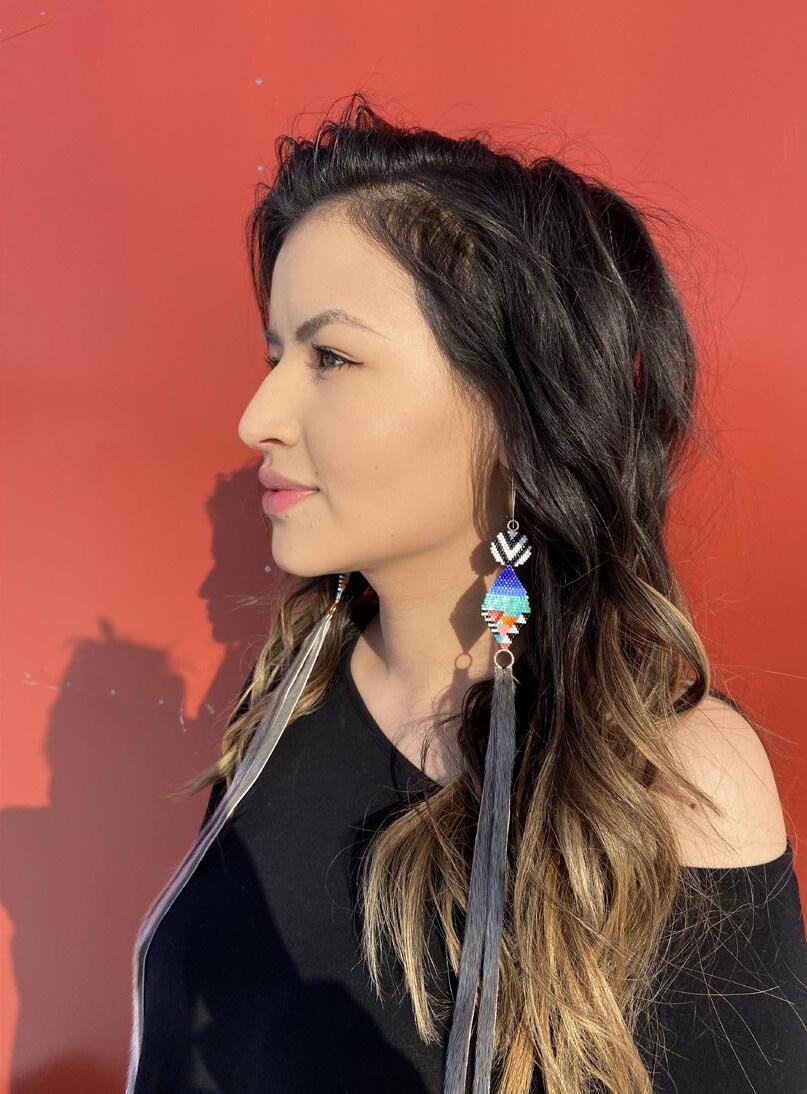

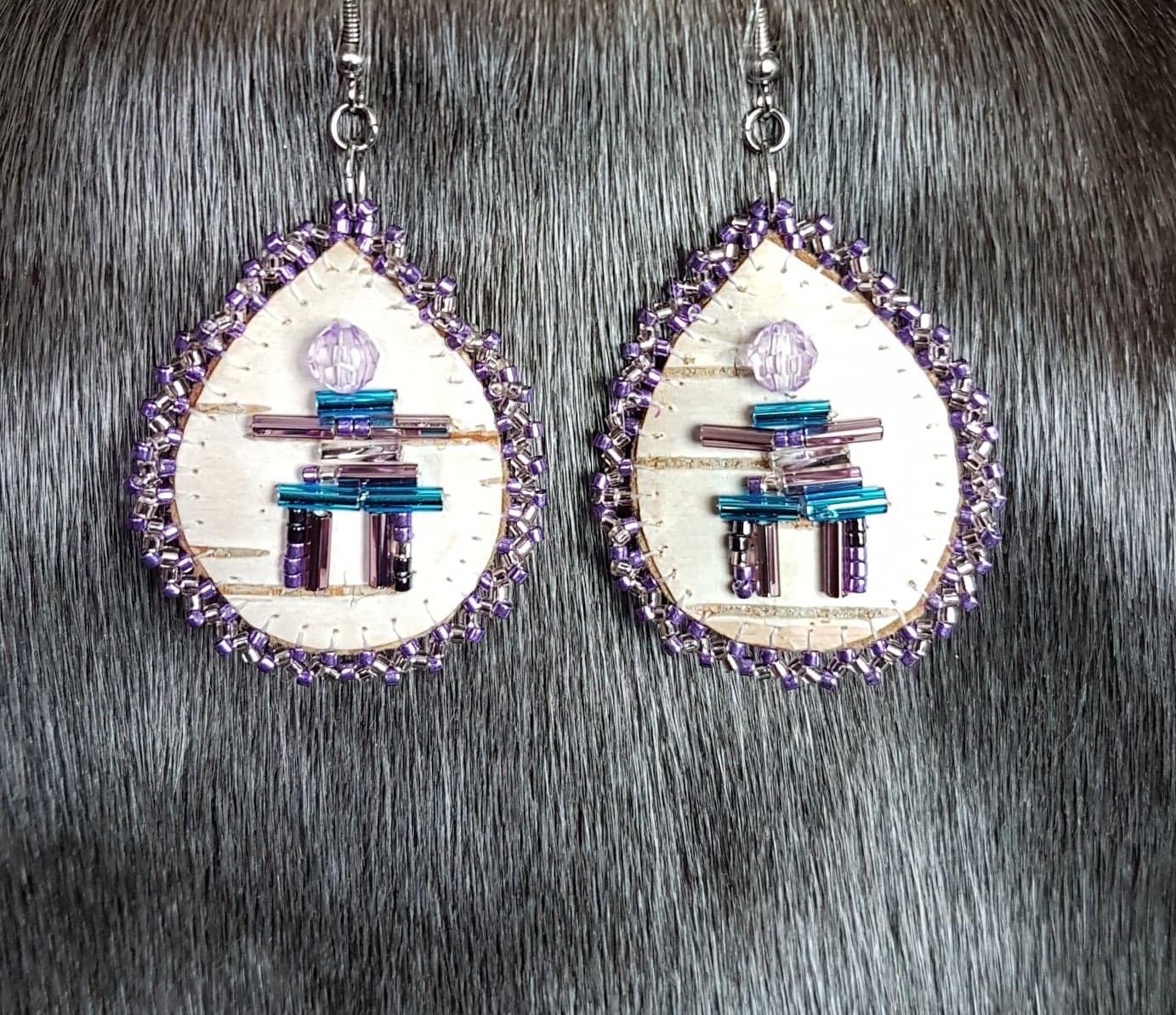

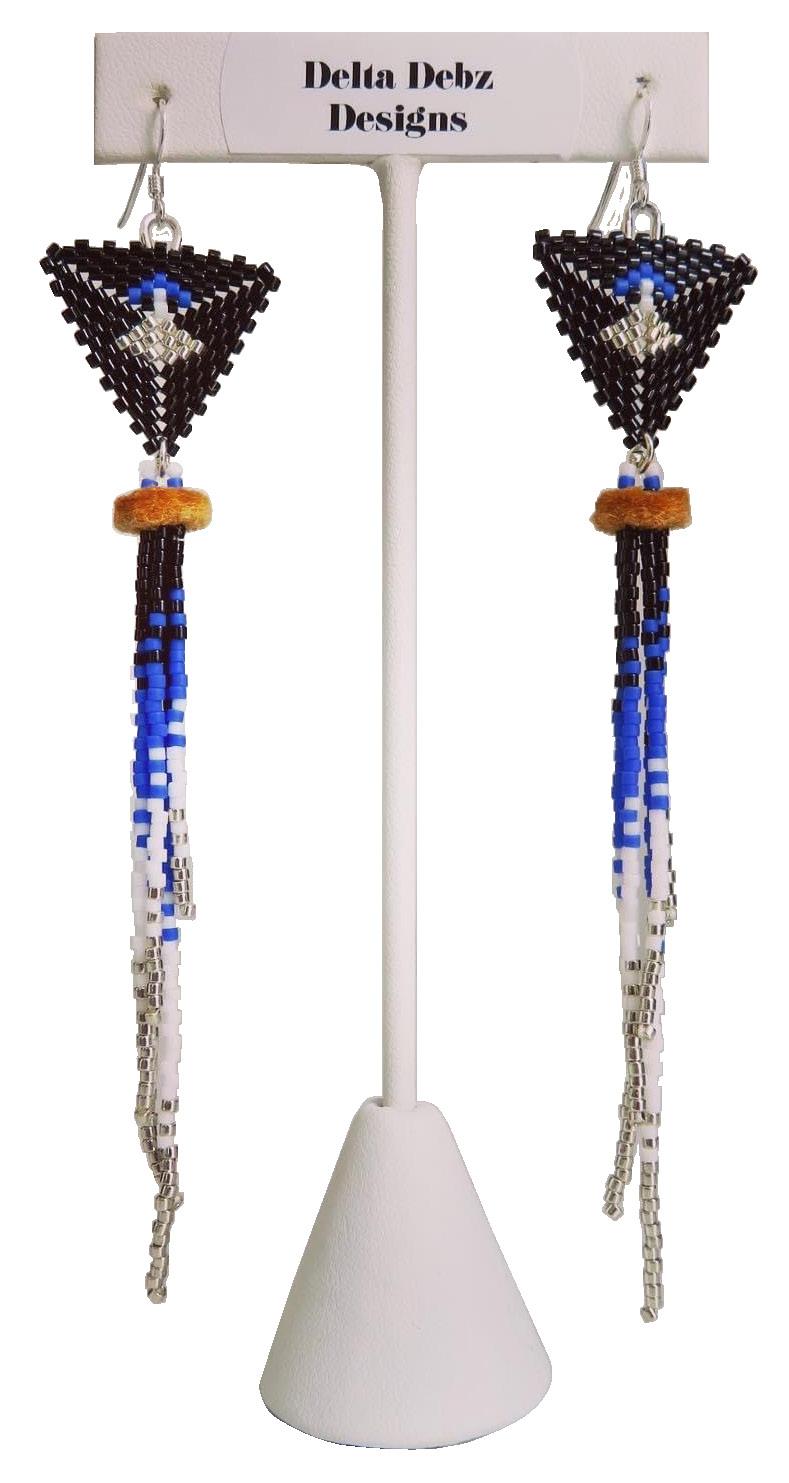
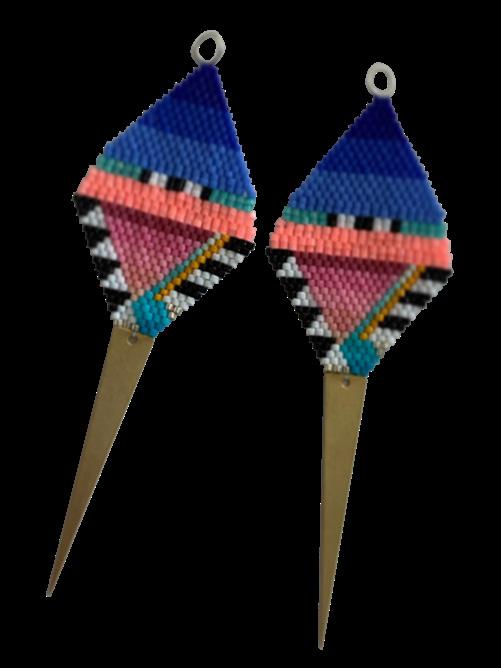

u x y z { |
Model: Sandra Blake
MASKING UP FOR CHARITY
WORDS & MASK DESIGNS


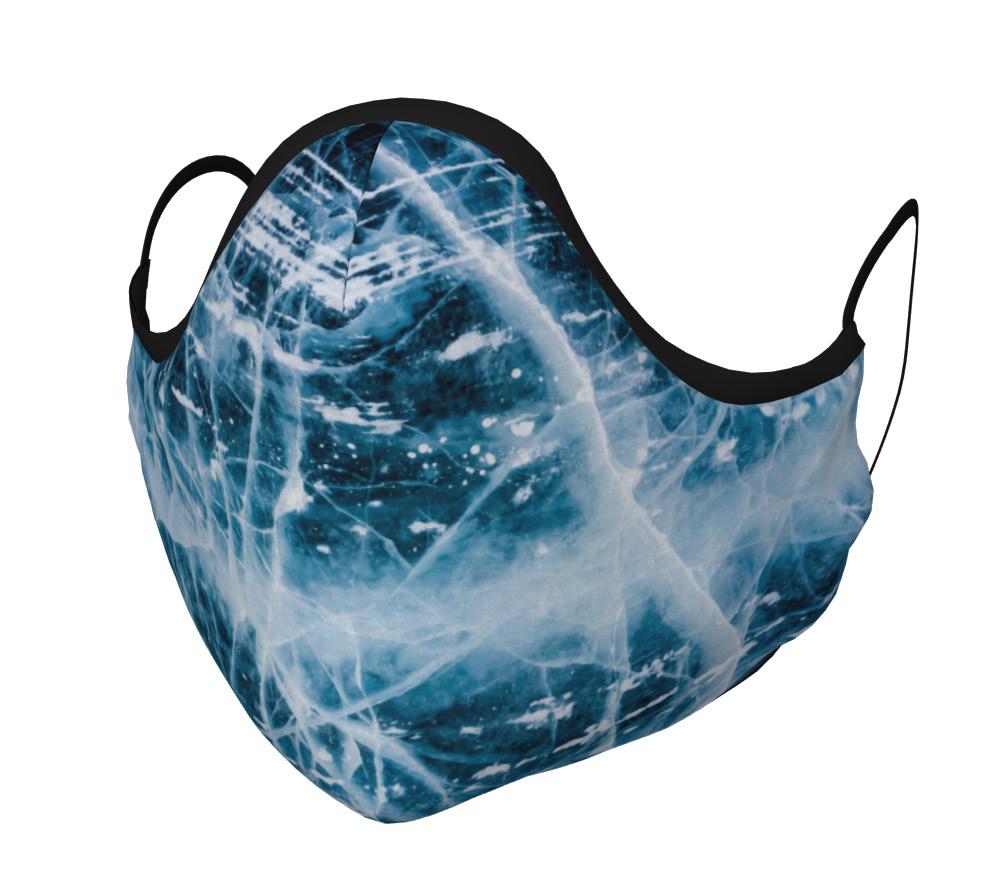 By KRISTIAN BINDER
By KRISTIAN BINDER
As soon as I was aware that people were making custom masks, I wanted to be involved with getting my photography and artwork on masks as well. I found a few places online that were doing that, but I was really hoping my usual place for custom apparel, Art of Where, would be doing it as well because I have a good relationship with them and love the quality of their work. As soon as they announced it was happening, I was on board and had my masks up in my online store within a day. Since I was already involved with photographing some of Denise McDonald’s beadwork at the same time, I asked her if she would mind if I used some of the photos I’d done to create masks that looked beaded (top right). Fortunately, she readily agreed!
As for donating the money, I wanted the proceeds to go to something that could help locally, especially during the pandemic, and the food bank seemed like the obvious choice for me. My job has been largely unafected by the current situation so I thought it would be something nice to do for others who weren’t quite as lucky.
I was so excited to hand over the first payment to the food bank, especially after two anonymous donors helped raise an extra $450 for it. When I found out that the donation had been so immediately helpful in such a meaningful way, I was thrilled! Tat was
exactly what I wanted: to help out in my own hometown in a tangible way. I’m hoping, with the recent media exposure, that we can keep sales coming for a while longer.
People reacted very positively to the designs presented online. It was my goal to ofer a variety of options, so having sunsets, aurora, landscapes, the ulu pattern, and aqpiit (plural of aqpik), worked great—but adding the beadwork designs really pushed it over the top! People who have since received their masks have been very complimentary of both the look and feel of the masks so that’s been really gratifying. I’ve gotten orders from all over Canada, which is so cool.
Health and wellness are things that are very important to me. As someone who has battled anxiety and panic attacks for the majority of their adult life, I do everything I can these days to monitor how I'm doing and how I can avoid old pitfalls. Staying sober is a big part of that path for me. I've been very vocal about my battle with alcoholism over the recent years and am proud of how far I've come in being able to recognize when my wellness is failing and I'm in jeopardy of lapsing into destructive behaviour. My photography has been very helpful in giving me a purpose when I've been lost. I encourage anyone who is feeling adrift to pursue a healthy hobby that they can get lost in.

INUUHIRIKTUQ HEALTH & WELLNESS 105 HAVAARIKTUQ / CREATIVE
@ EIGHTY_ONE_IMAGES
INUVIALUIT FORTITUDE
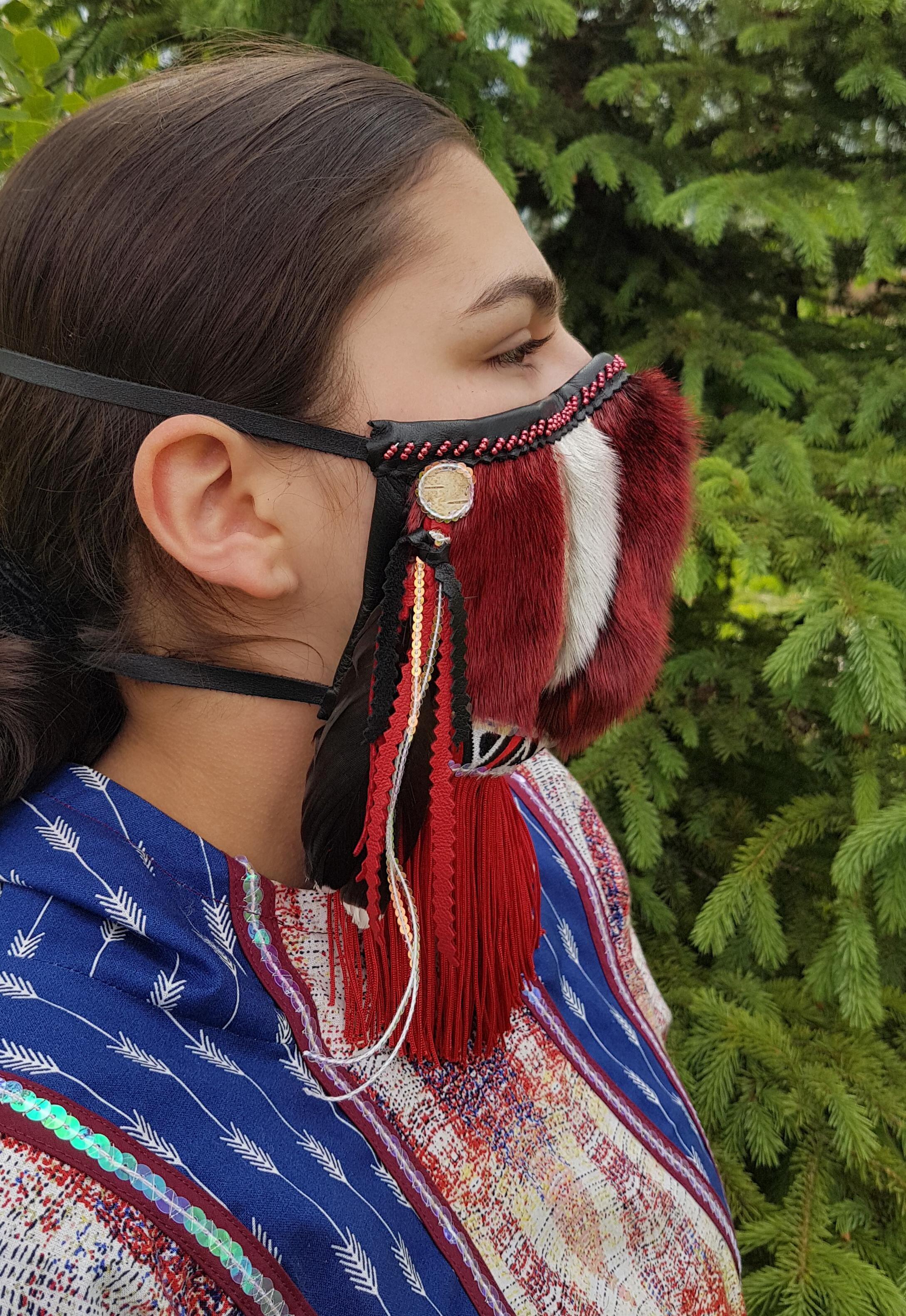
Tese masks are my response to COVID-19. Over half of our people were wiped out during the Spanish Flu epidemic approximately 100 years ago and we were on the brink of extinction.
WORDS & ART by TAALRUMIQ / CHRISTINA KING
BACK COVER STORY
We had no natural immunity to diseases brought over by European Whalers and Fur Traders. My maternal grandparents were young children who helped fetch water for the sick and dying during that time.
Today's Inuvialuit descend from those who survived the devastating flu epidemic. We also face the same fear with COVID-19. Tese masks are a testament to our strength and resilience as Inuvialuit People. We are strong, intelligent, successful, and modern people who still live according to traditional values and way of life passed on to us from our ancestors.
As Indigenous people, our experiences tell us that we aren't really seen, heard, nor valued by mainstream society. Yet we are still here despite years of colonization, systemic racism and injustice, genocide, diseases, starvation, residential schools, and ongoing ill treatment of our people.
Tese masks are a 'sister set', inspired by the resilience, strength, and fortitude of Inuvialuit people and culture; these masks say, "I'm here, I'm real, I have value—I exist." We are still here. Our experiences, our history, our future matters—we matter.
Both masks feature traditional design elements of Inuvialuit clothing, such as walrus tusks. Walruses were an important resource for Inuvialuit life in the Arctic, providing food, material for tools, rope, waterproof clothing, and oil for lamps.
~ Mask 1 (left) is designed with our traditional parka in mind. It is made with seal skin, black leather, fabric, ptarmigan feathers, birchbark, sequins, beads, and chainette fringe. Tis mask features white walrus tusks, enhanced with mini sequins. Te geometric design in traditional black, white, and red, were made of caribou hide and fur long ago. Ptarmigan feathers and birch bark are two simple things that hold strong memories for me and my love for my culture. No matter how insignificant something might seem, everything had a purpose in Inuvialuit life and culture. Ptarmigan, a small arctic bird, provides food, and its feathers are useful. Birch bark is found on the shores of the Arctic Ocean, washed up with driftwood, providing another necessity—fire starter, essential for life in the Arctic.
Mask 2 (right) is made of white sealskin with red walrus tusks and a zigzag bead embellishment reminiscent of our traditional designs. Tis mask also has red sealskin and mini sequin fringe, beaded trim and natural blue fox fur accents. With braided silver ear pieces, red, white and black trim, this mask is a modern interpretation of Inuvialuit tradition.
Individually, each mask is beautiful, strong, and makes a statement; together, they are so much more. Like Inuvialuit, together they are stronger! Like all Indigenous people, together they are stronger!
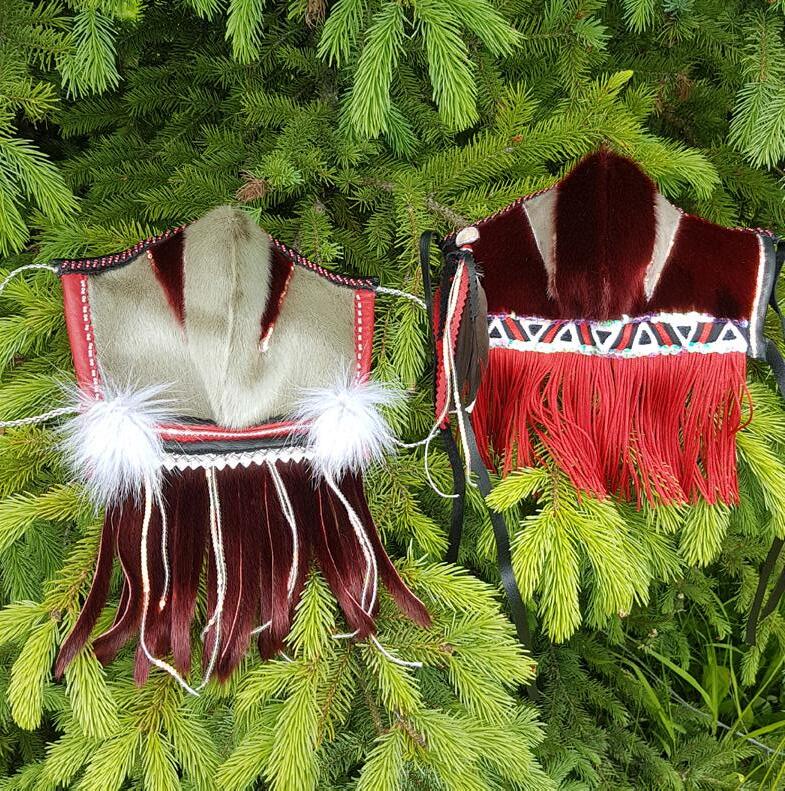
INUUHIRIKTUQ HEALTH & WELLNESS 107 KINGUANI / BEHIND
@ FEELTHEGENTLEBREEZE

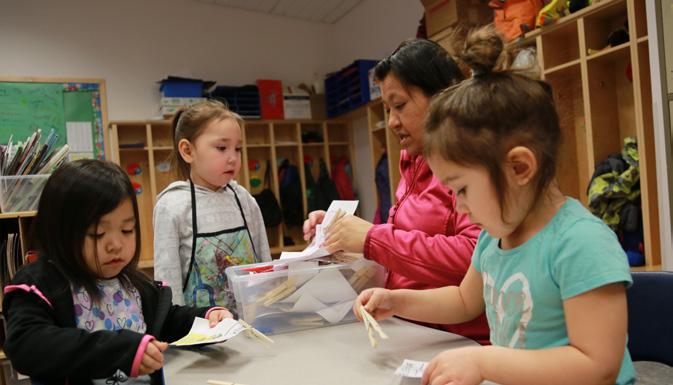

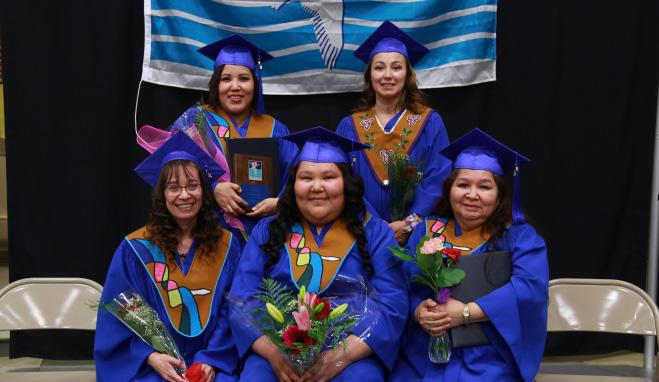

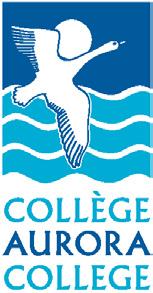

Aurora Campus Programs •Practcal Nursing Diploma (contact the campus for prerequisites) •Business Administraton •Ofce Administraton •University & College Access •Occupatons & College Access •Academic Upgrading Phone: (867) 777-7800 • Email: info@auroracollege.nt.ca For more informaton: Apply Online! www.auroracollege.nt.ca School of Arts and Science Environment and Natural Resources Technology Diploma School of Business and Leadership Business Administraton Diploma/Certfcate Ofce Administraton Diploma/Certfcate Northern Leadership Development School of Developmental Studies Adult Literacy and Basic Educaton Occupatons and College Access (OCAP) University and College Access (UCAP) School of Educaton Early Learning and Childcare Diploma Early Childhood Development Certfcate Certfcate In Adult Educaton School of Health and Human Services Bachelor of Science in Nursing Personal Support Worker Certfcate Post Graduate Certfcate in Remote Nursing School of Trades, Apprentceship and Industrial Training Apprentceship Programs Building Trades Helper Camp Cook Fundamentals of Electrical Heavy Equipment Operator Introducton to the Mining Industry Surface Miner Training Mineral Processing Operator Contnuing Educaton Check our website for complete lists ALL PROGRAMS Aurora College Plan now for fall 2020! ADVERTISEMENT for AURORA COLLEGE 1 YEAR for $20 Includes 4 quarterly issues 2 YEARS for $36 Includes 8 quarterly issues NAME ADDRESS and/or P.O. BOX PROVINCE/TERRITORY POSTAL CODE CITY " PHONE NUMBER E-MAIL Subscribe Today! Mail this with a cheque/money order to: P.O. Box 1704, Inuvik, NT X0E 0T0 *All prices are in Canadian Dollars (CAD). II (YES)! SIGN ME UP FOR TUSAAYAKSAT, PLEASE! Please contact: tusaayaksat@northwestel.net or +1 (867) 777-2320

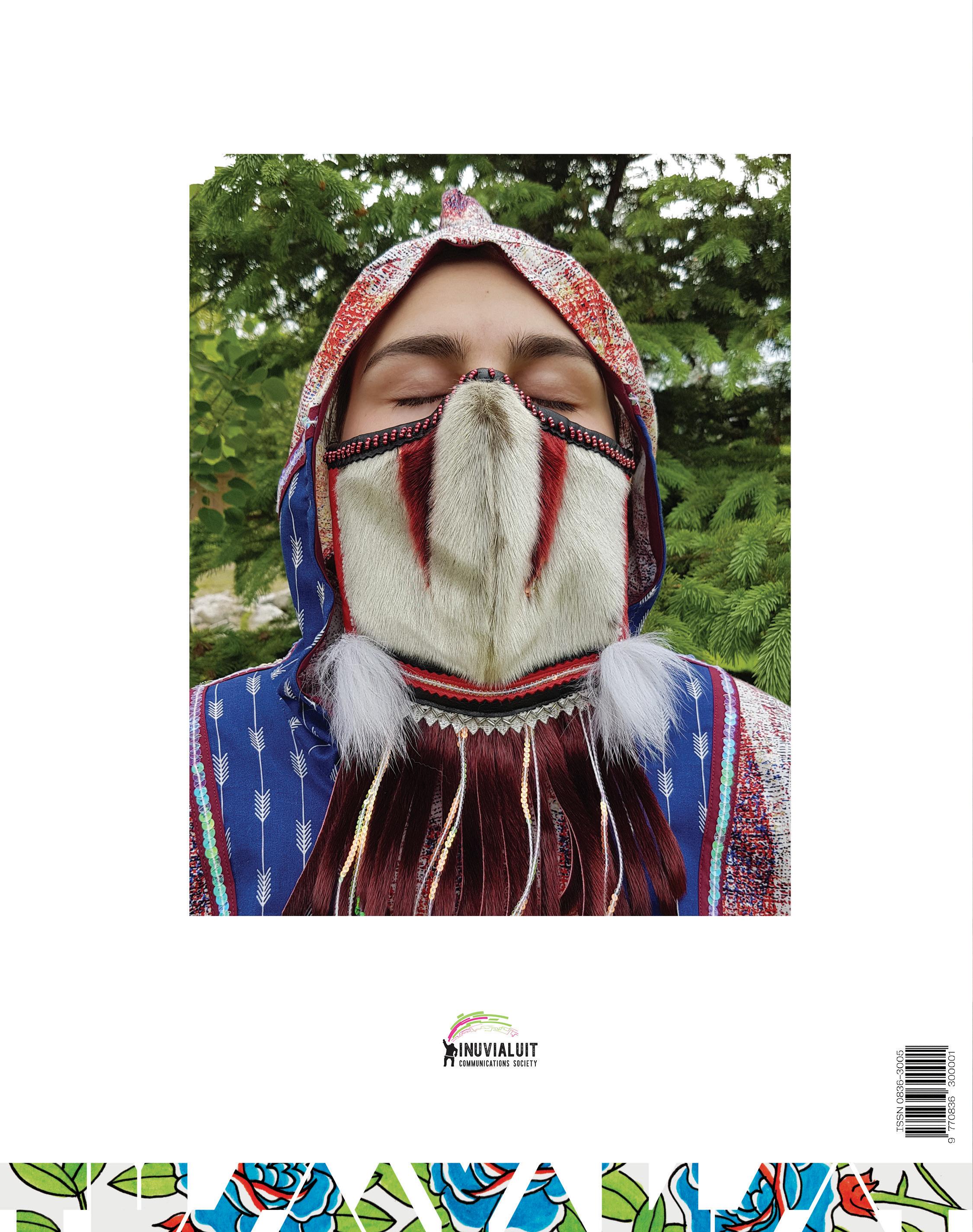

















 PHOTO BY MYRNA POKIAK
PHOTO BY MYRNA POKIAK










 PHOTO BY STEWART BURNETT
PHOTO BY STEWART BURNETT
 PHOTO BY WERONIKA MURRAY
PHOTO BY WERONIKA MURRAY






 PHOTO BY KYNWILL GORDON-RUBEN
PHOTO BY KYNWILL GORDON-RUBEN

 LEARN MORE: You can follow Alice's Facebook group, "Tea & Maktak", for the latest updates, videos, and other Inuvialuktun content.
LEARN MORE: You can follow Alice's Facebook group, "Tea & Maktak", for the latest updates, videos, and other Inuvialuktun content.

 PHOTO SUBMITTED by STARLA SHORT
@ STARLALOHA
PHOTO SUBMITTED by STARLA SHORT
@ STARLALOHA




 ARTWORK BY ALEXANDRA ALEEKUK
ARTWORK BY ALEXANDRA ALEEKUK


 PHOTO SUBMITTED by KAILIN ALEEKUK
PHOTO SUBMITTED by KAILIN ALEEKUK

 WORDS & PHOTOS by KYNWILL GORDON-RUBEN @KYN_TOMMY
WORDS & PHOTOS by KYNWILL GORDON-RUBEN @KYN_TOMMY
 LEFT : Pat Kuptana tweaking his self-made goose calls—his pastime of choice when on the land—while on the lookout for geese.
LEFT : Pat Kuptana tweaking his self-made goose calls—his pastime of choice when on the land—while on the lookout for geese.
 BELOW : Nathan Kuptana and Kolton Gordon-Ruben pluck the frst catch in preparation for fresh goose soup in the blind.
Words & Photo: Kynwill GordonRuben (@kyn_tommy)
BELOW : Nathan Kuptana and Kolton Gordon-Ruben pluck the frst catch in preparation for fresh goose soup in the blind.
Words & Photo: Kynwill GordonRuben (@kyn_tommy)




 Leadership retreat views at the Project Jewel campsite, Gwich'in Territorial Campgrounds, October 2018. Photo: Shayla Snowshoe.
Leadership retreat views at the Project Jewel campsite, Gwich'in Territorial Campgrounds, October 2018. Photo: Shayla Snowshoe.





 (RIGHT) Peter Greenland entertains Elder Sarah Jerome at the Youth Leadership Retreat, October 2018. Photo: Shayla Snowshoe.
(BOTTOM RIGHT) Elaine Elanik plays with Dani-Mae while she picks berries, at the Midway Youth Gathering, August 2019. Photo: Shayla Snowshoe.
(DIRECTLY BELOW) Karissa Kimiksana and Natasha Ross enjoy the hike and views at the Project Jewel campsite, Gwich'in Territorial Park, at the Youth Culture Camp, October 2019.
Photo: Shayla Snowshoe.
(BOTTOM LEFT) Stringer Kasook listens to wise words and advice from Elders and previous leadership, at the Midway Youth Gathering, August 2019. Photo: Shayla Snowshoe.
(RIGHT) Peter Greenland entertains Elder Sarah Jerome at the Youth Leadership Retreat, October 2018. Photo: Shayla Snowshoe.
(BOTTOM RIGHT) Elaine Elanik plays with Dani-Mae while she picks berries, at the Midway Youth Gathering, August 2019. Photo: Shayla Snowshoe.
(DIRECTLY BELOW) Karissa Kimiksana and Natasha Ross enjoy the hike and views at the Project Jewel campsite, Gwich'in Territorial Park, at the Youth Culture Camp, October 2019.
Photo: Shayla Snowshoe.
(BOTTOM LEFT) Stringer Kasook listens to wise words and advice from Elders and previous leadership, at the Midway Youth Gathering, August 2019. Photo: Shayla Snowshoe.


 A spectacular berry-picking afernoon, close to the Yukon border, during the Midway Youth Gathering, in August 2019.
Photo: Shayla Snowshoe.
A spectacular berry-picking afernoon, close to the Yukon border, during the Midway Youth Gathering, in August 2019.
Photo: Shayla Snowshoe.


 (BELOW) Smoking dry-fsh. Youth caught and prepared the fsh, guided by teachings from Elders Alice & Ernest Vittrekwa. Midway Youth Gathering, August 2019. Photo: Shayla Snowshoe.
(BELOW) Smoking dry-fsh. Youth caught and prepared the fsh, guided by teachings from Elders Alice & Ernest Vittrekwa. Midway Youth Gathering, August 2019. Photo: Shayla Snowshoe.



















 PHOTO BY MYRNA POKIAK
PHOTO BY MYRNA POKIAK













 PHOTO BY STEWART BURNETT
PHOTO BY STEWART BURNETT










 COLLAGES BY KYLE NATKUSIAK ALEEKUK
COLLAGES BY KYLE NATKUSIAK ALEEKUK



 PHOTO BY KRISTIAN BINDER
WORDS by DENNIS ALLEN
PHOTO BY KRISTIAN BINDER
WORDS by DENNIS ALLEN


 WORDS by NOEL-LEIGH COCKNEY
WORDS by NOEL-LEIGH COCKNEY















 By KRISTIAN BINDER
By KRISTIAN BINDER











